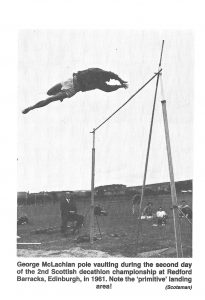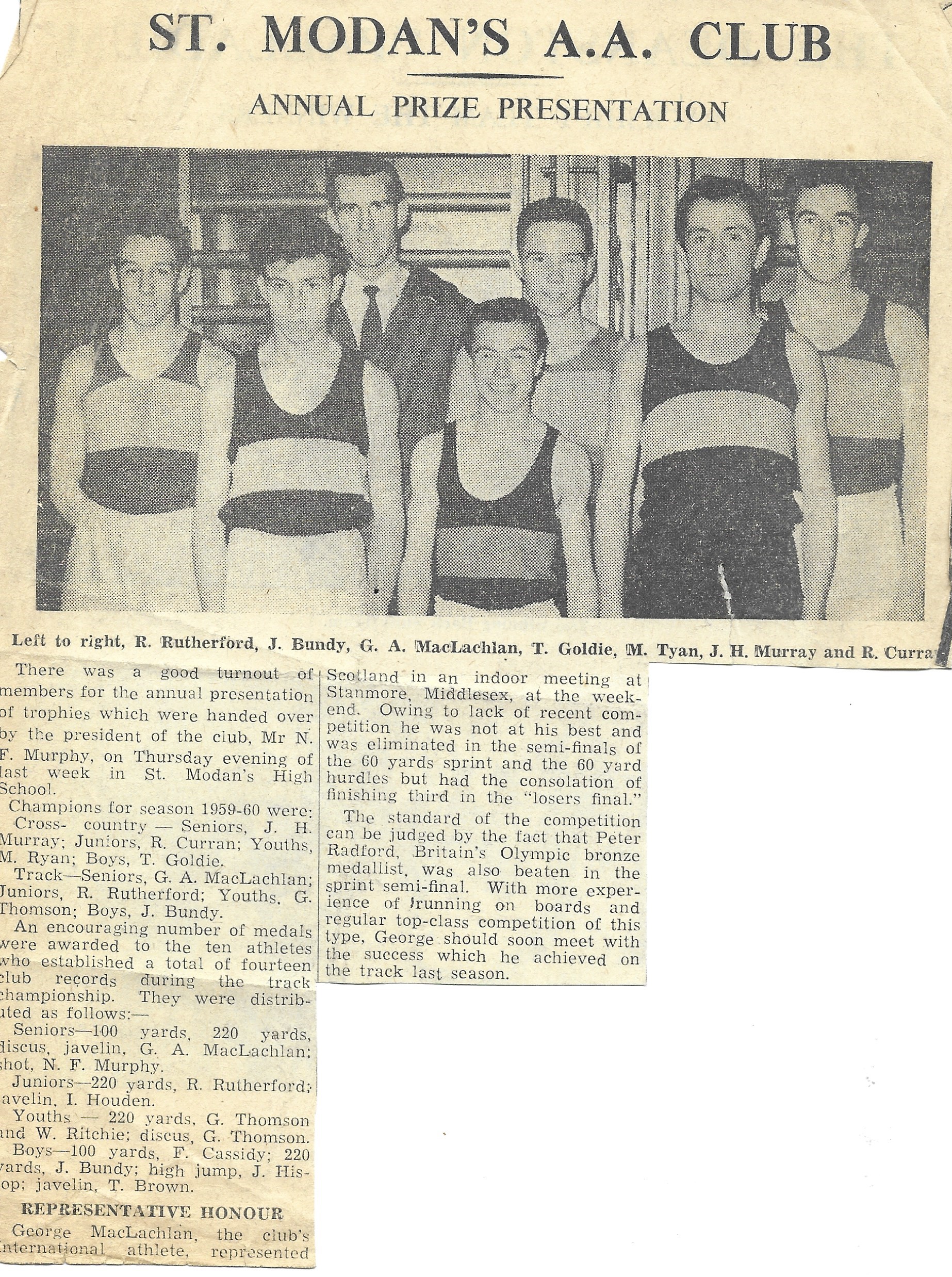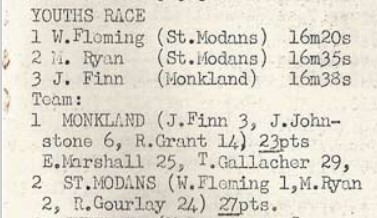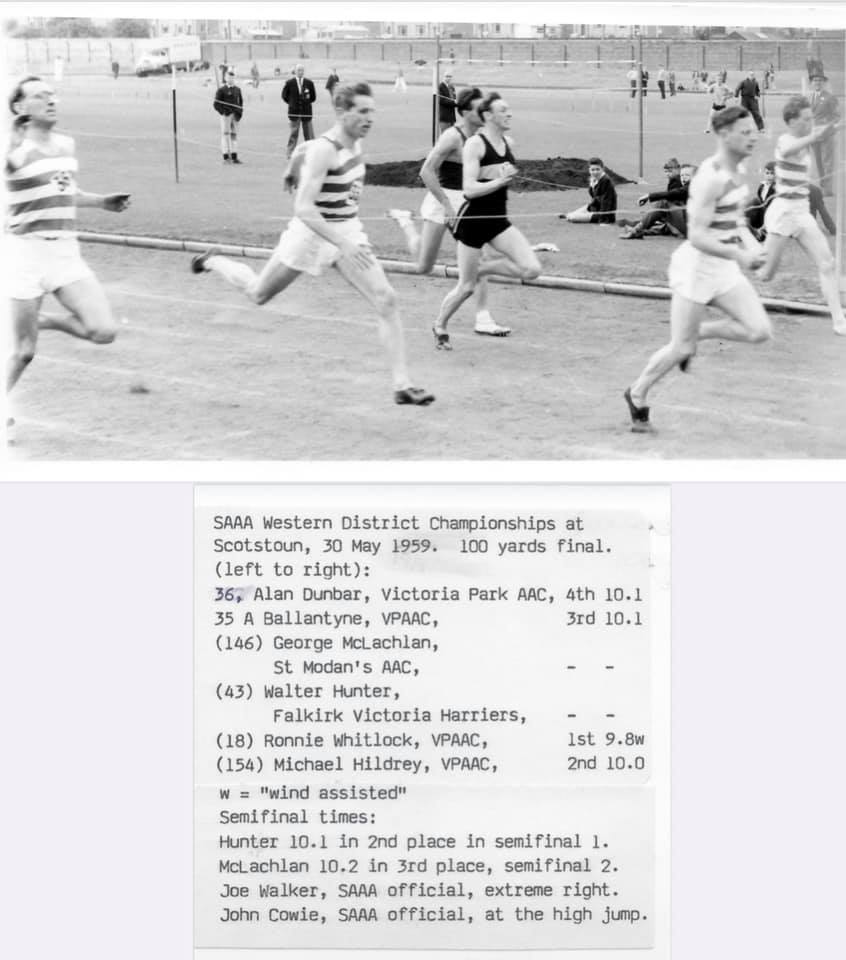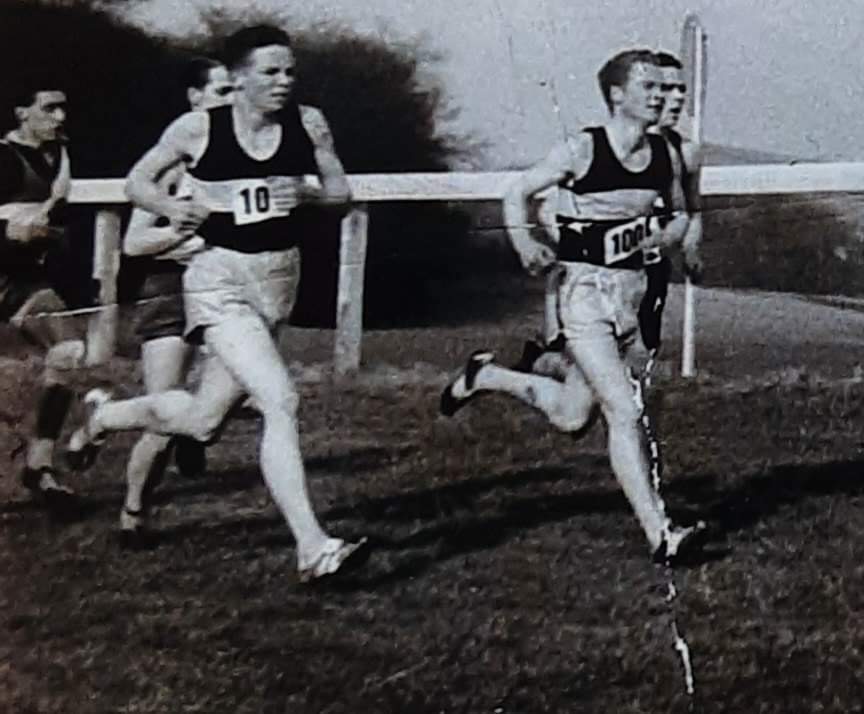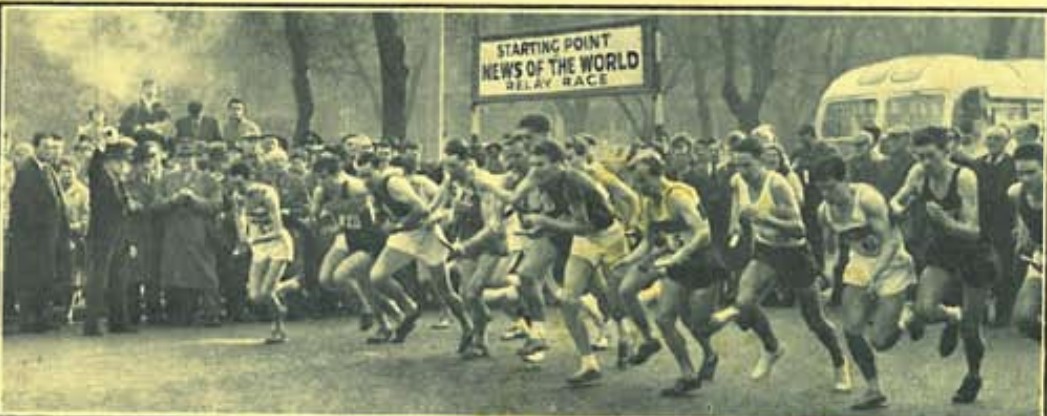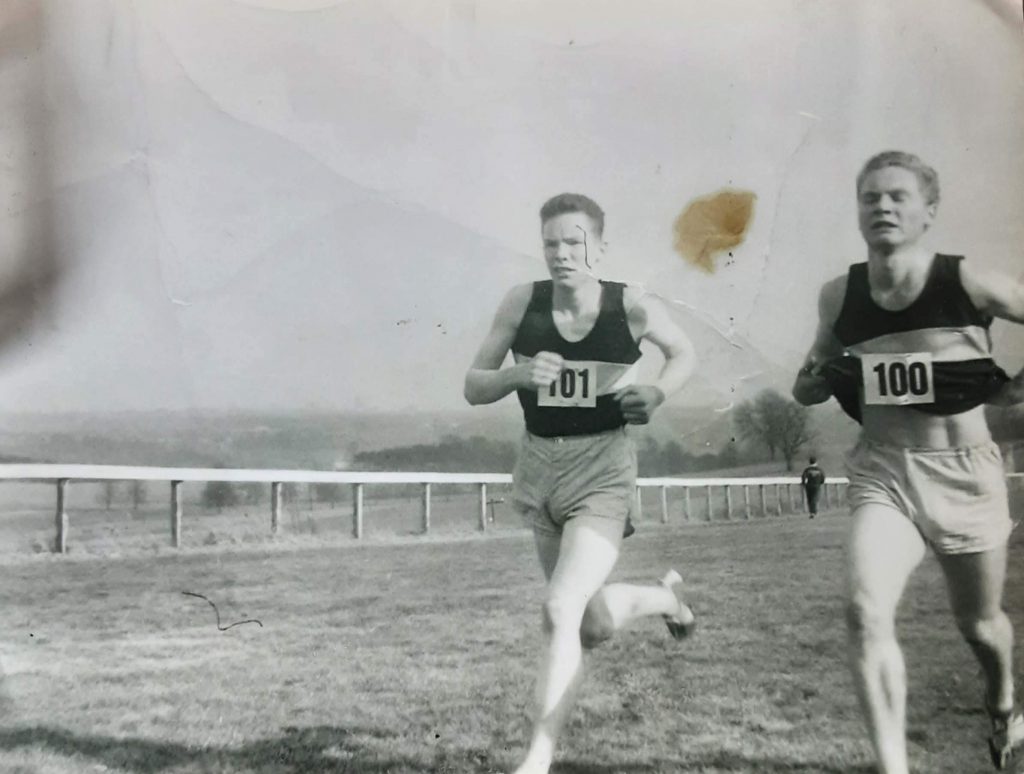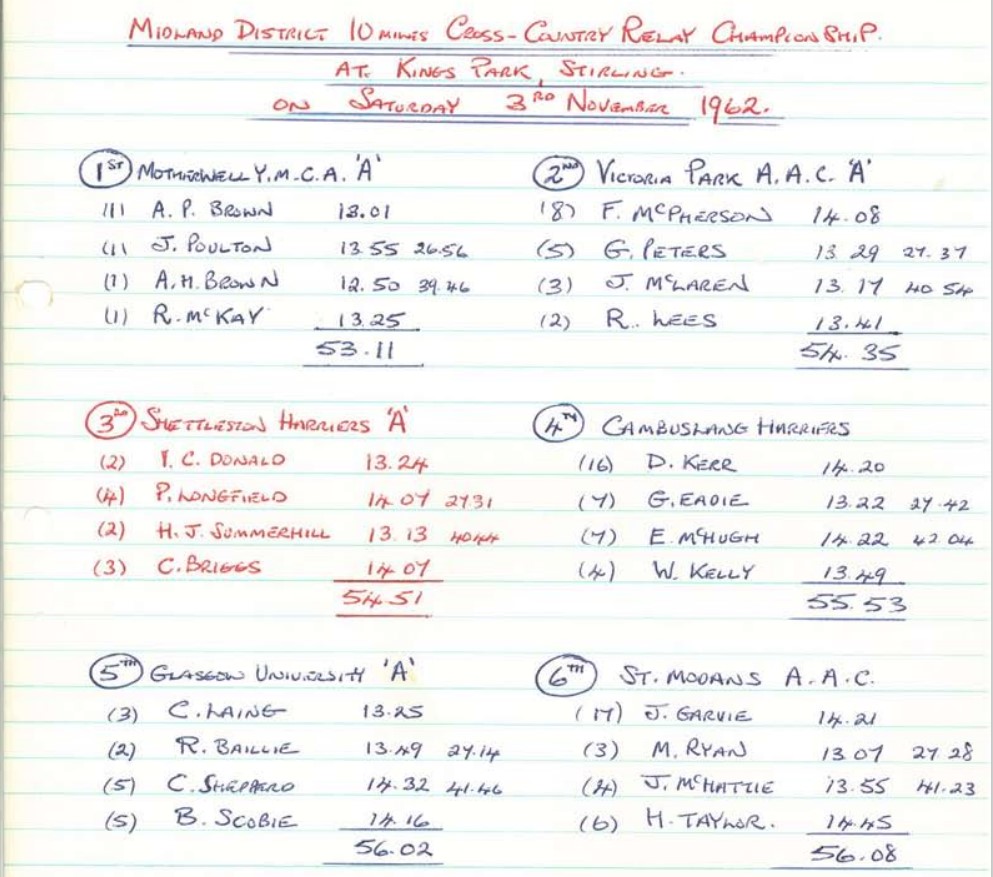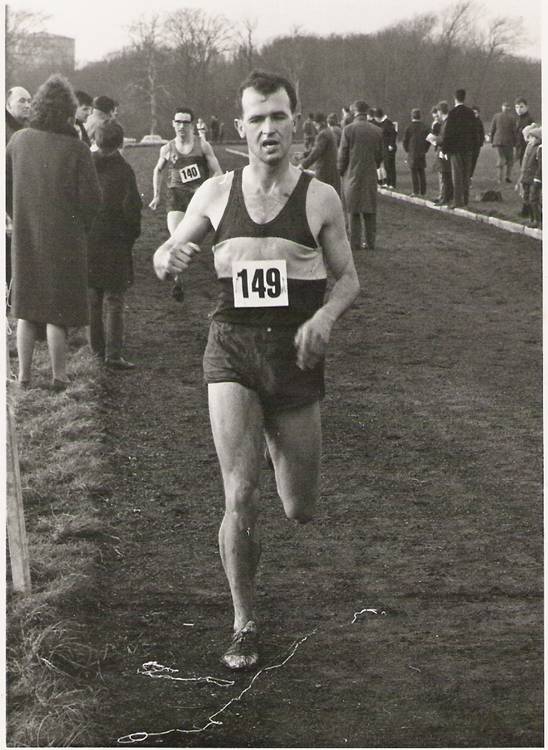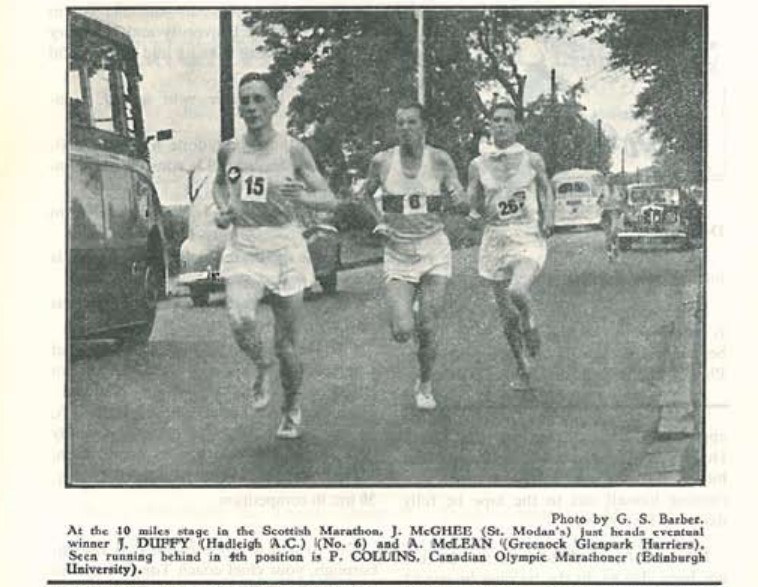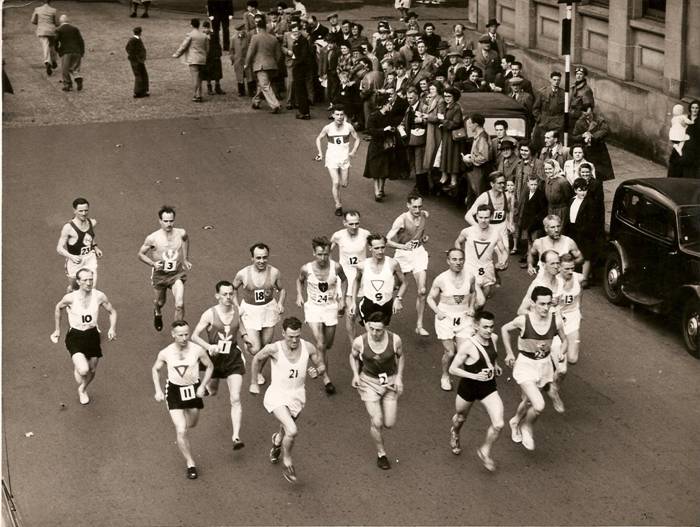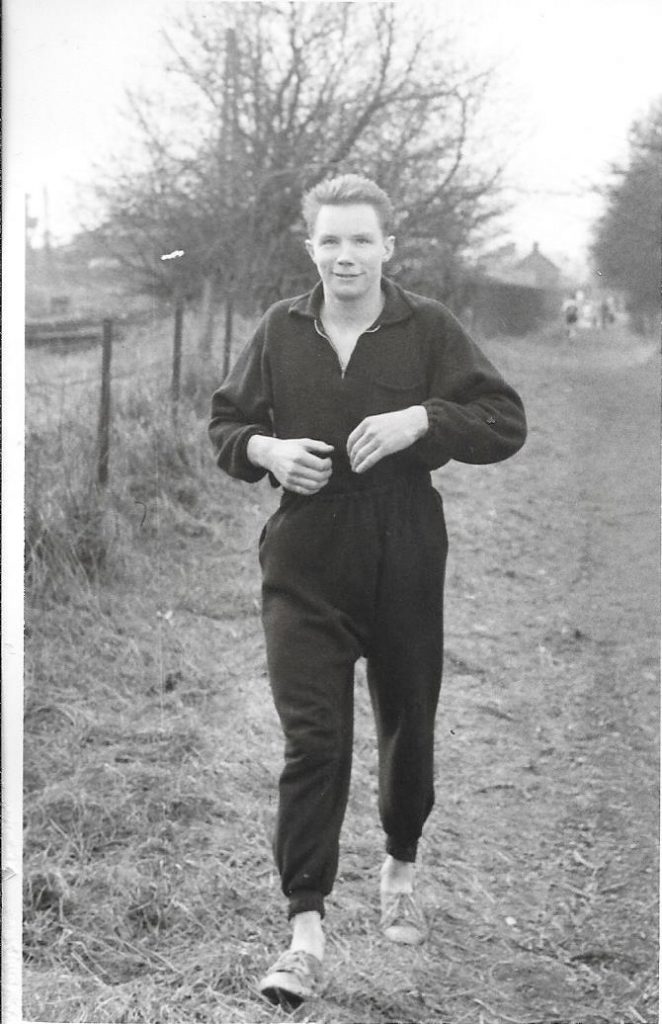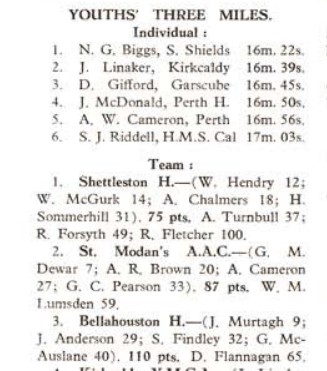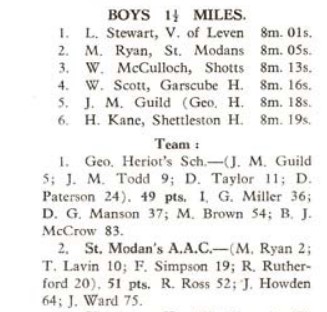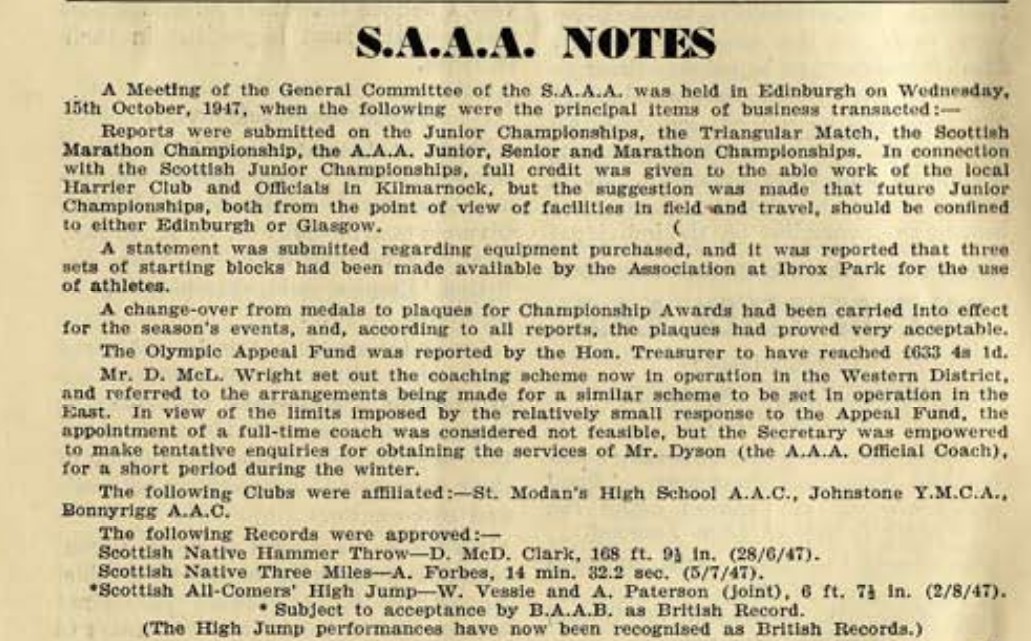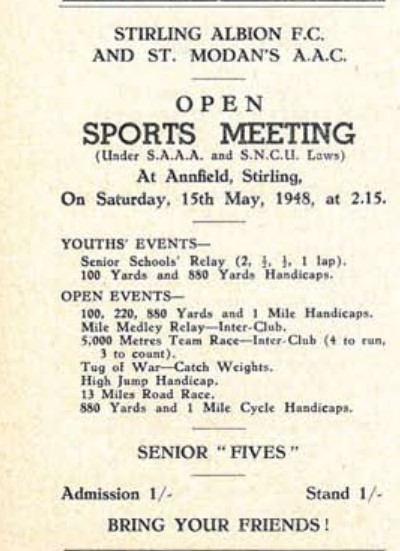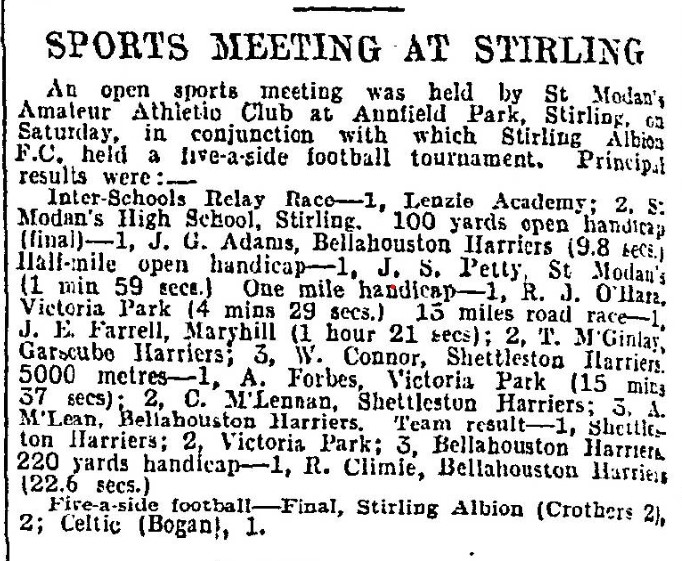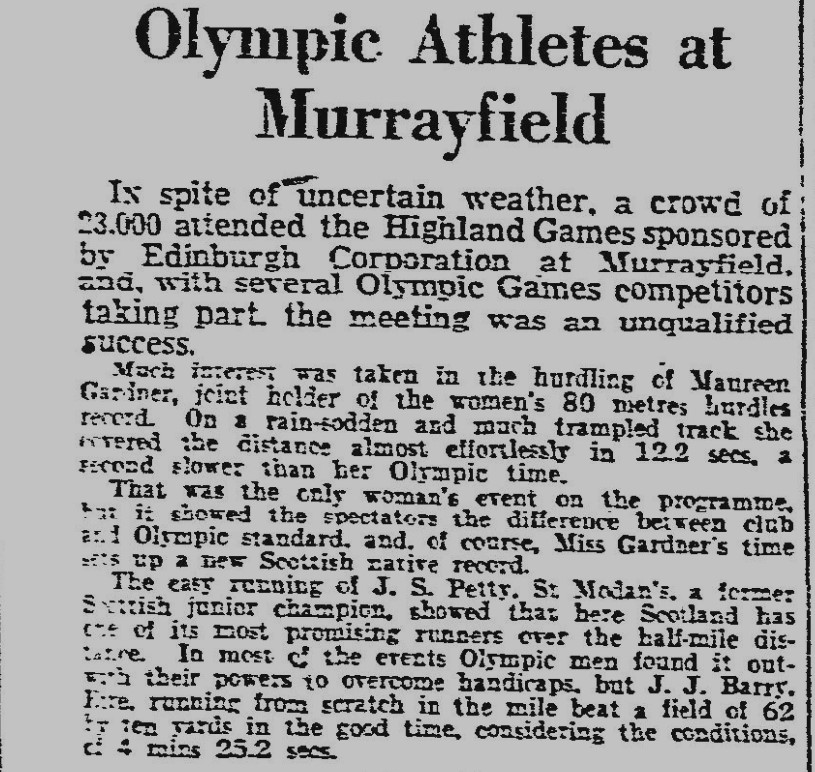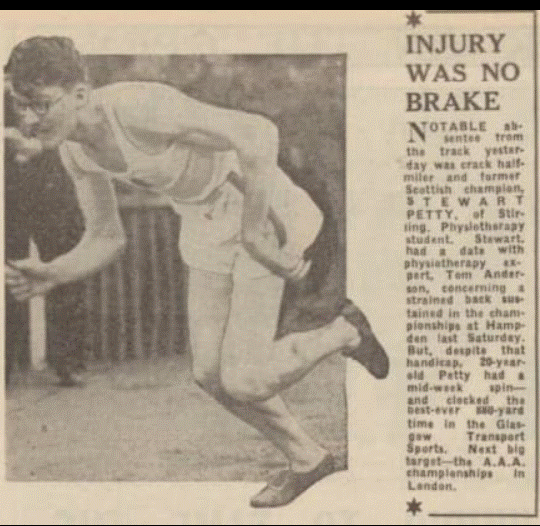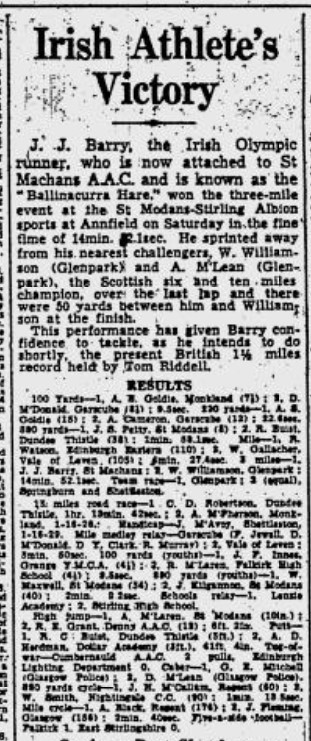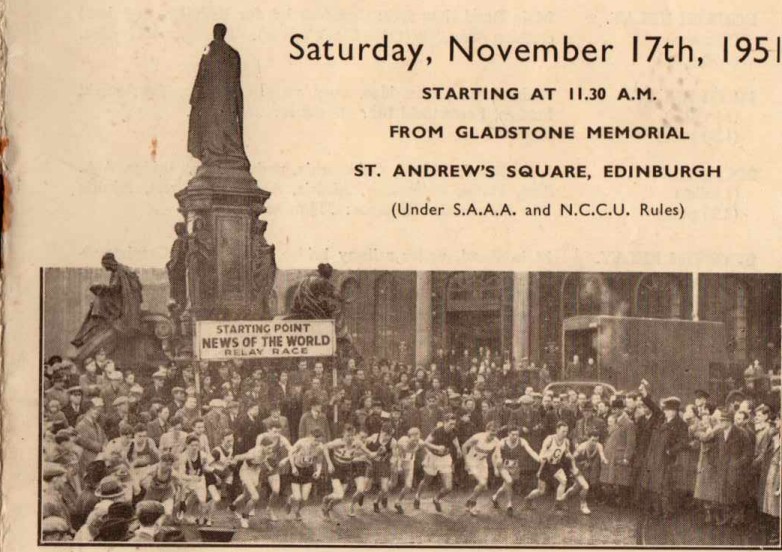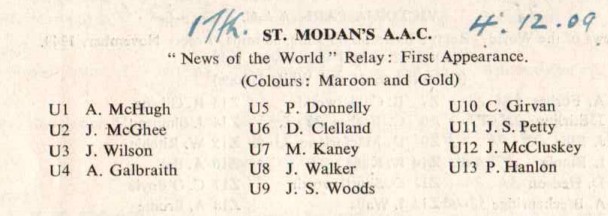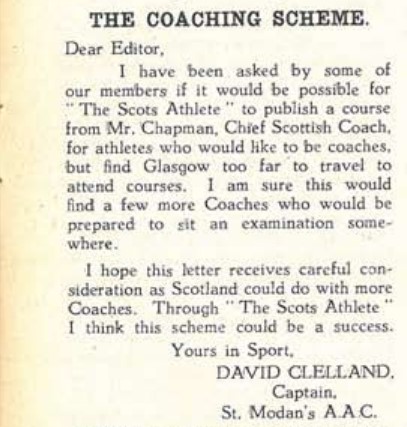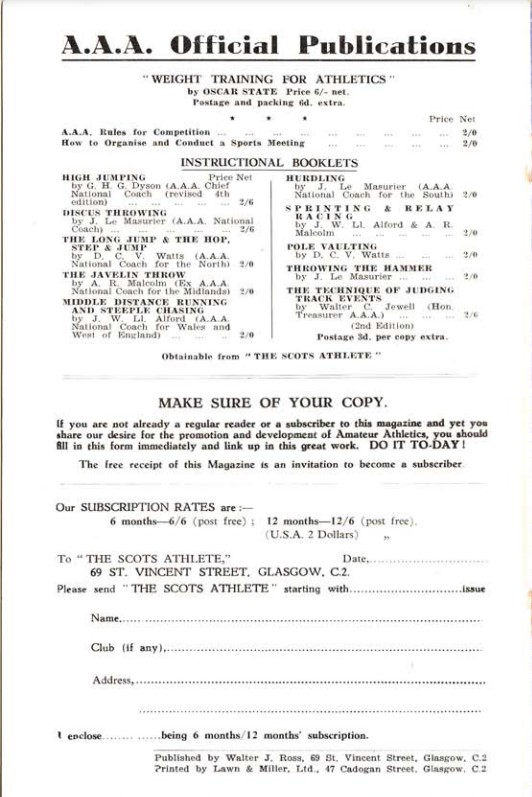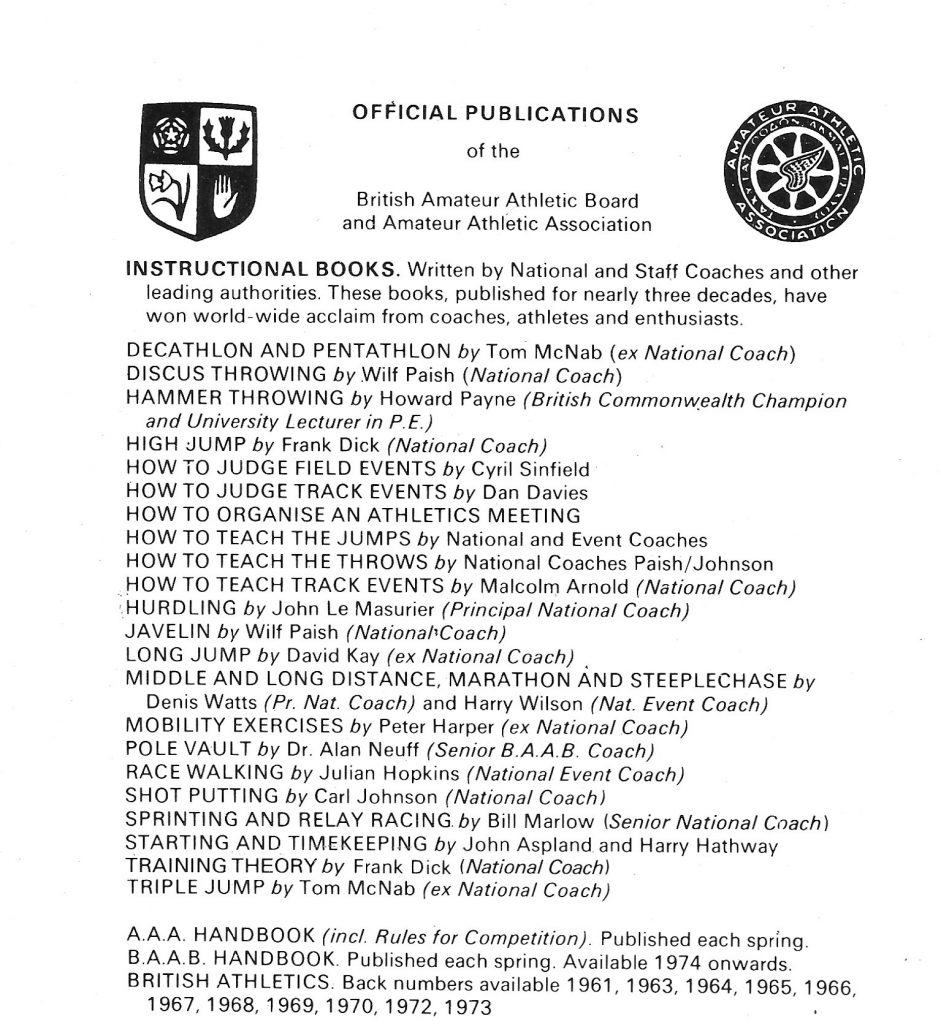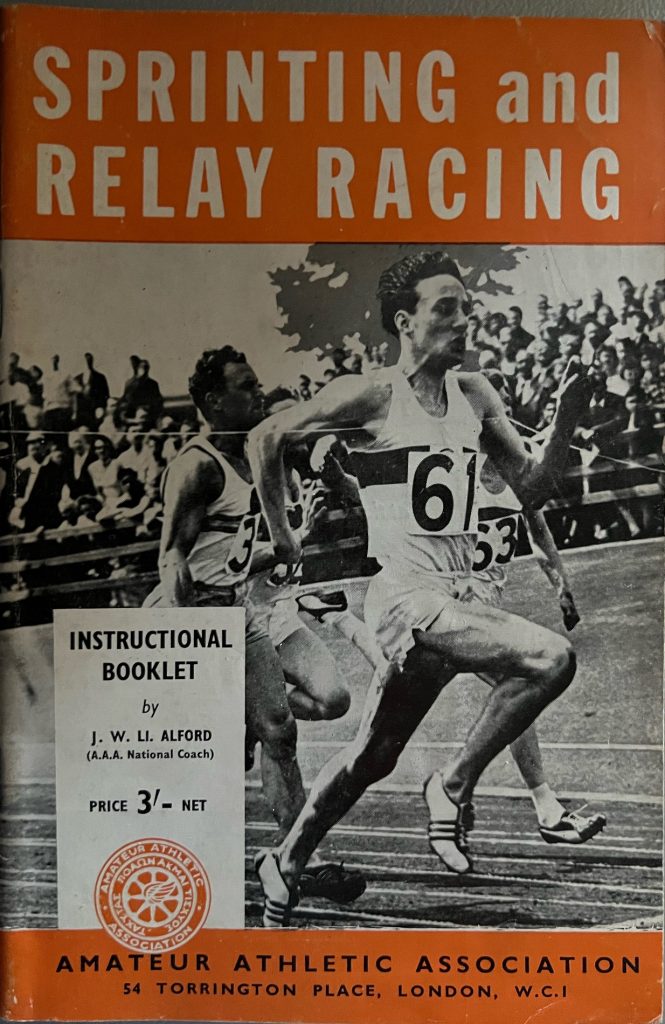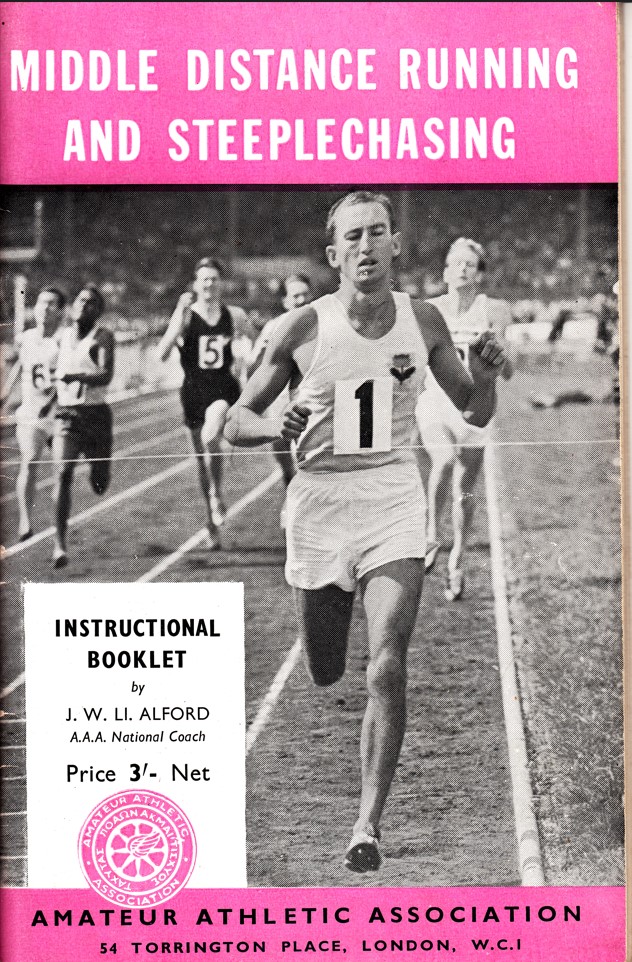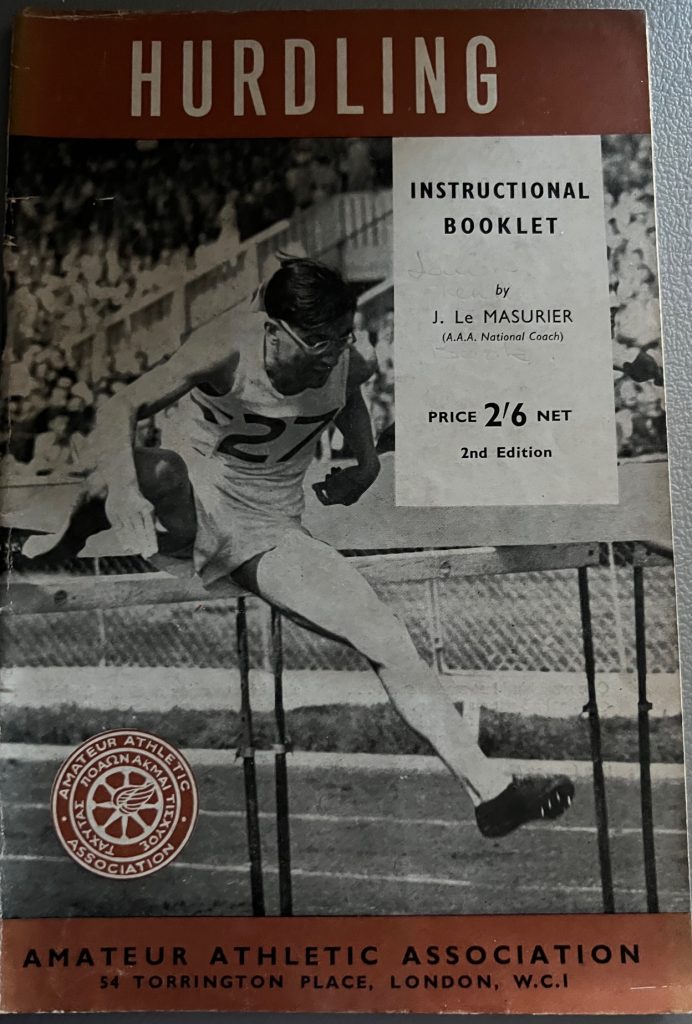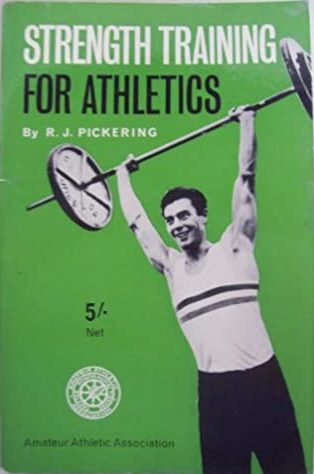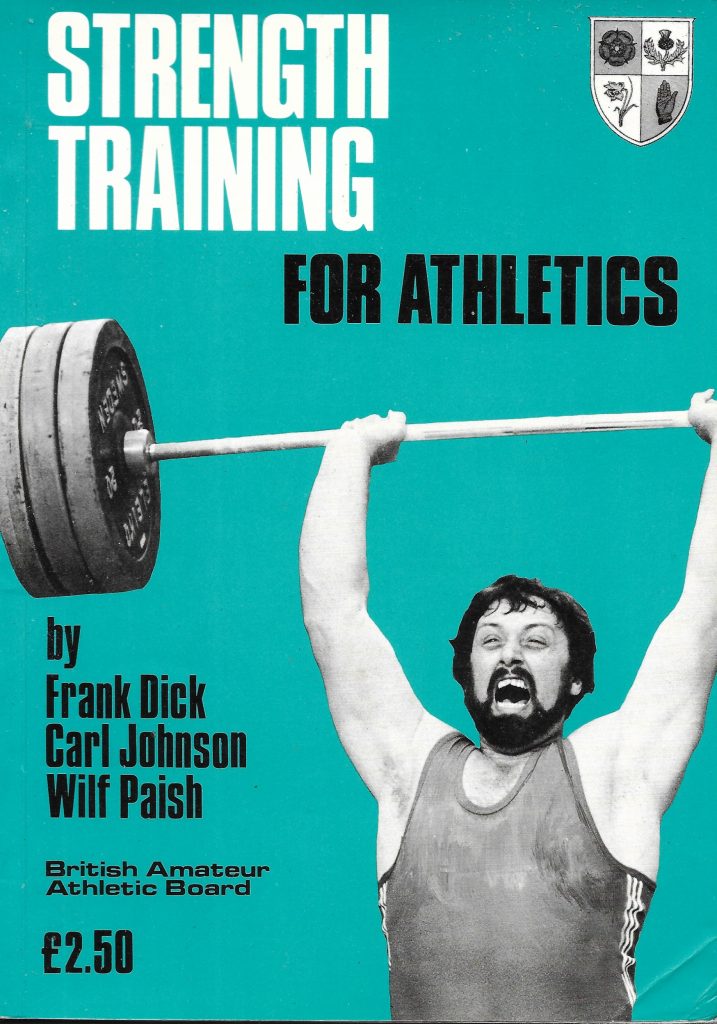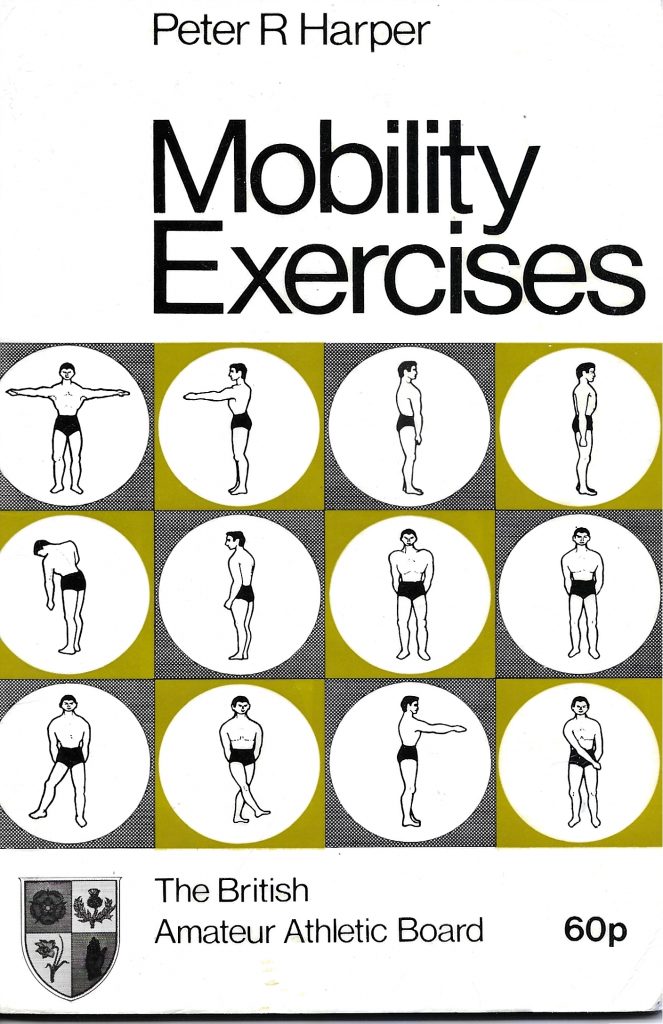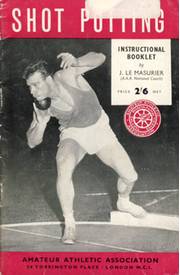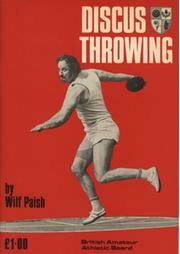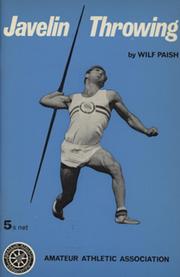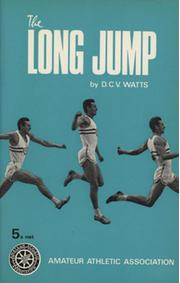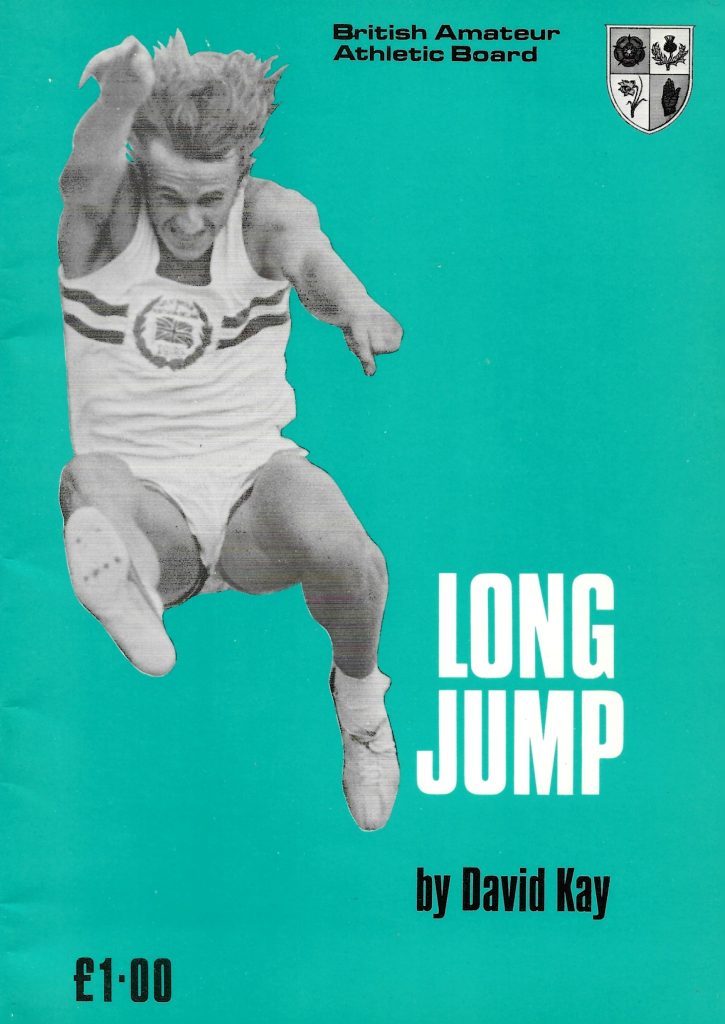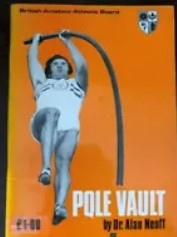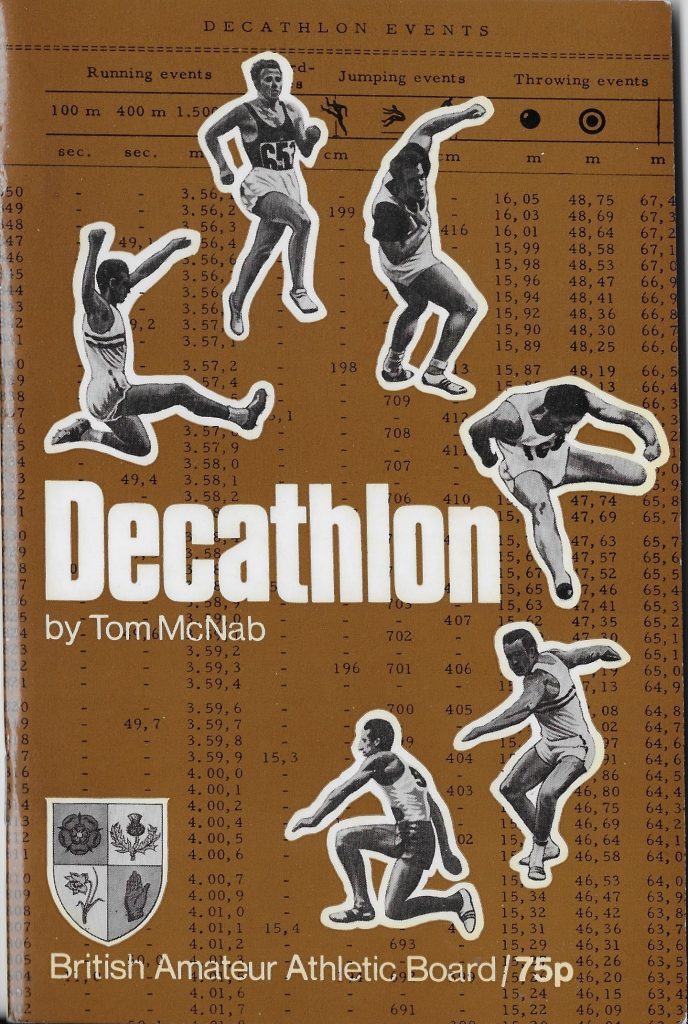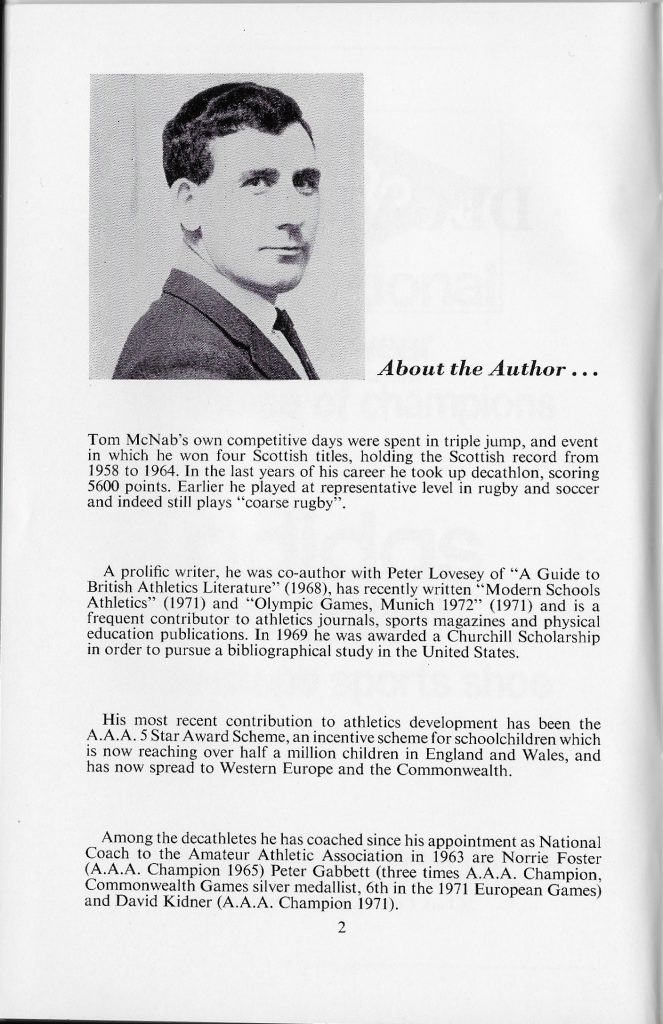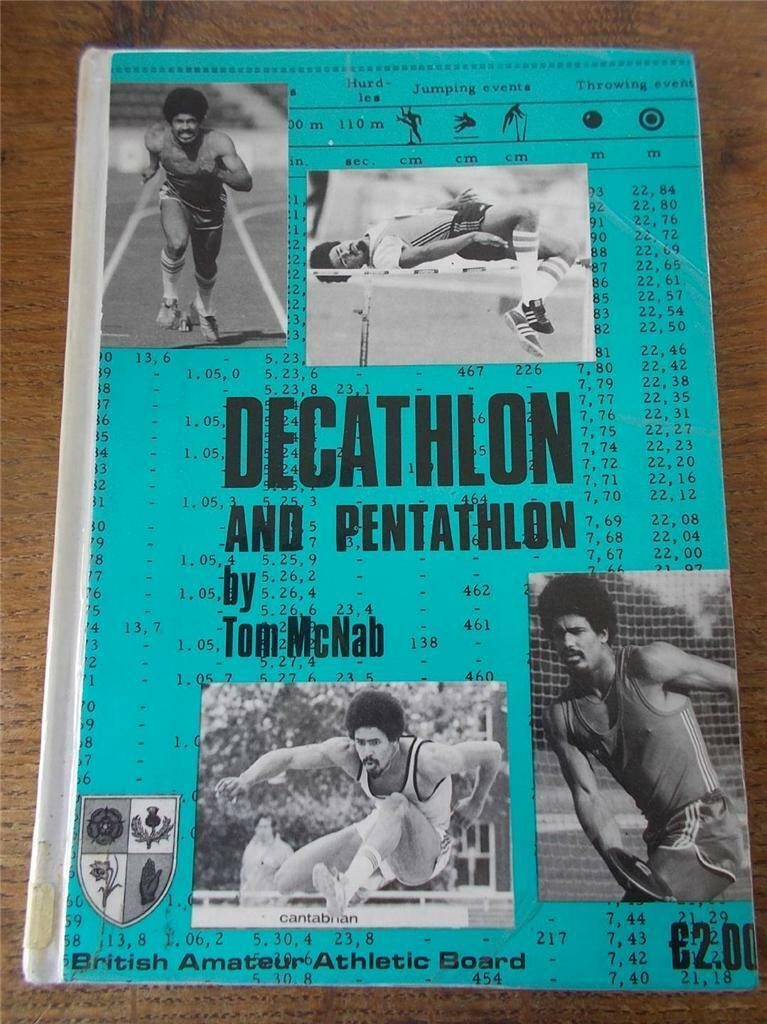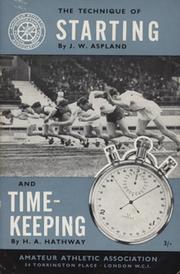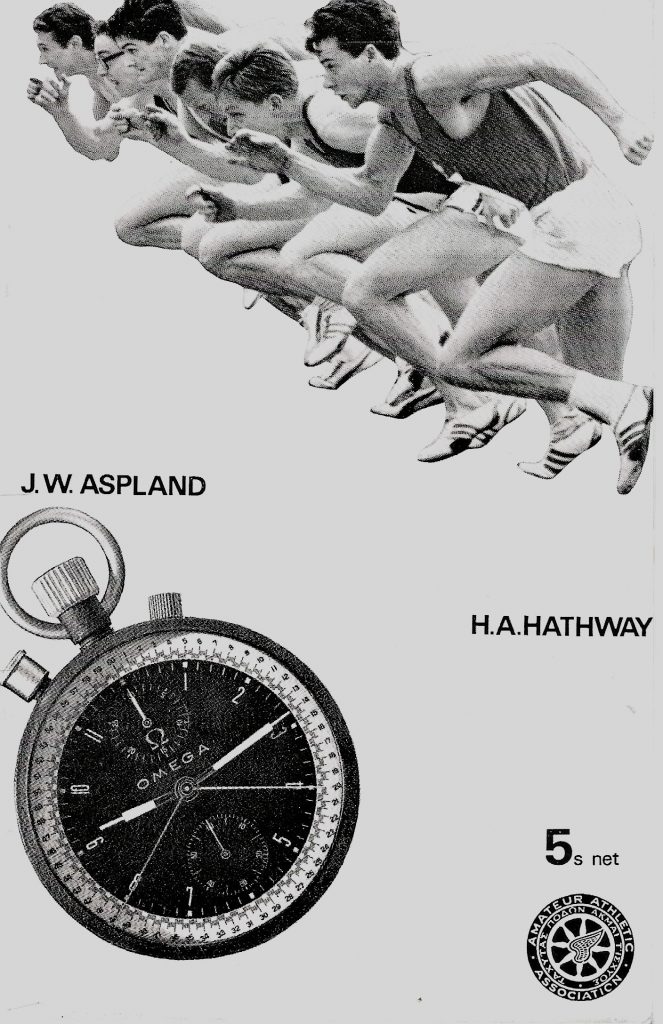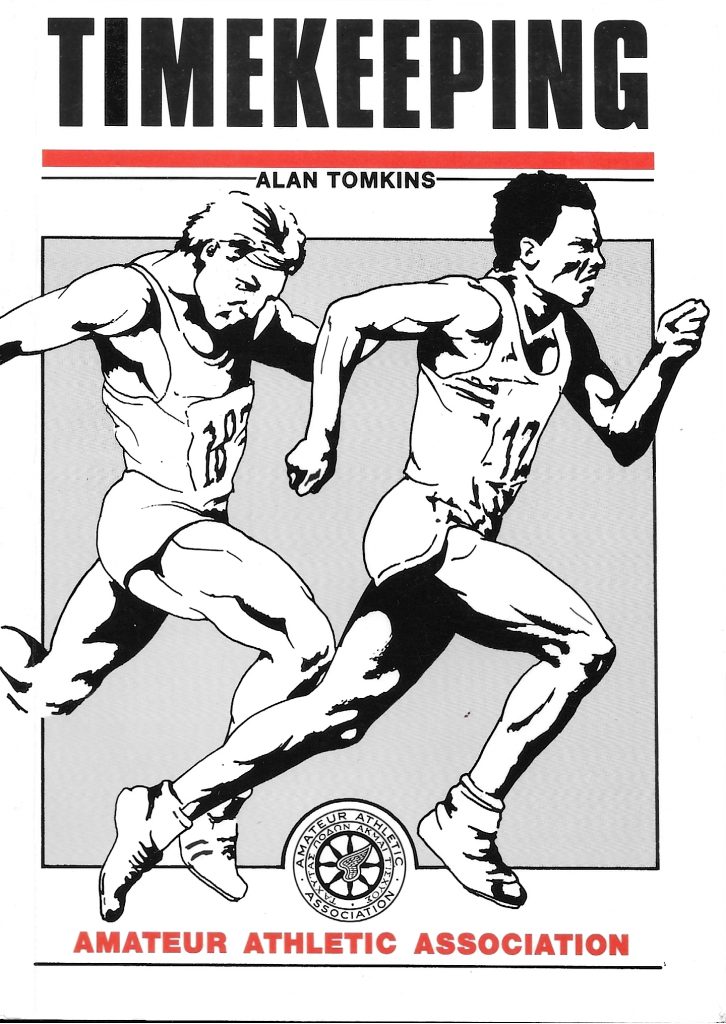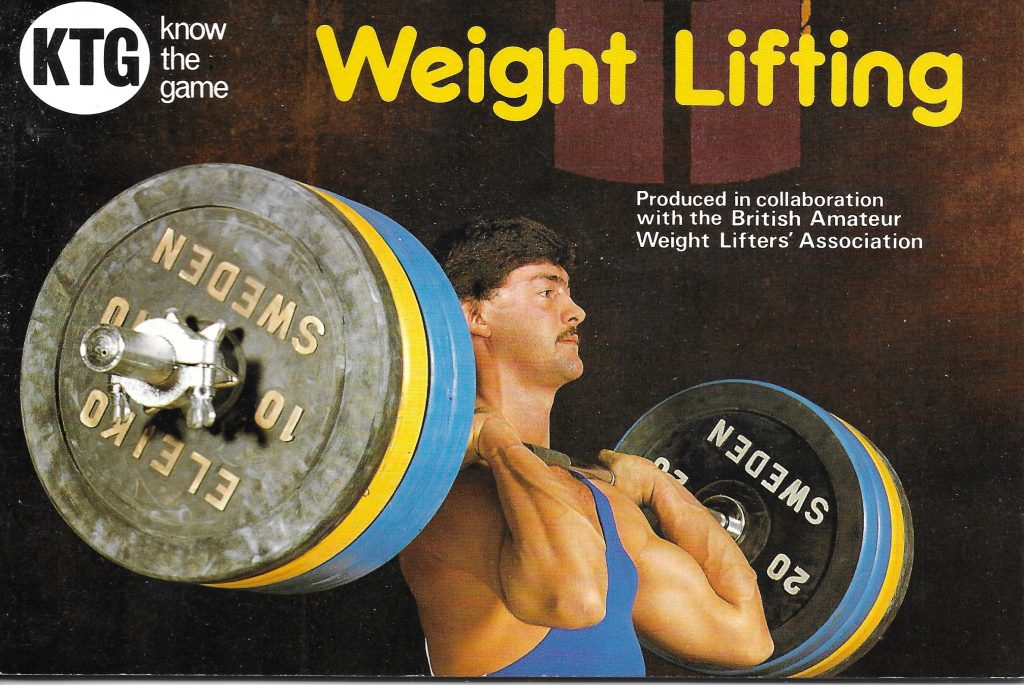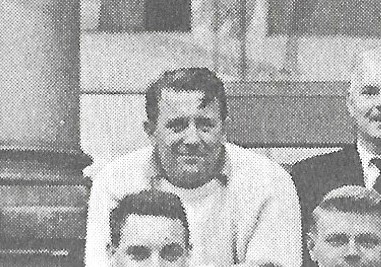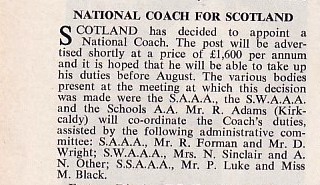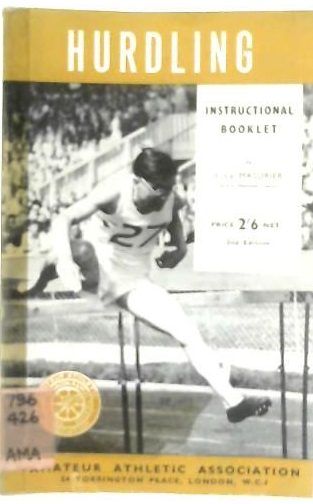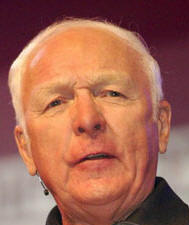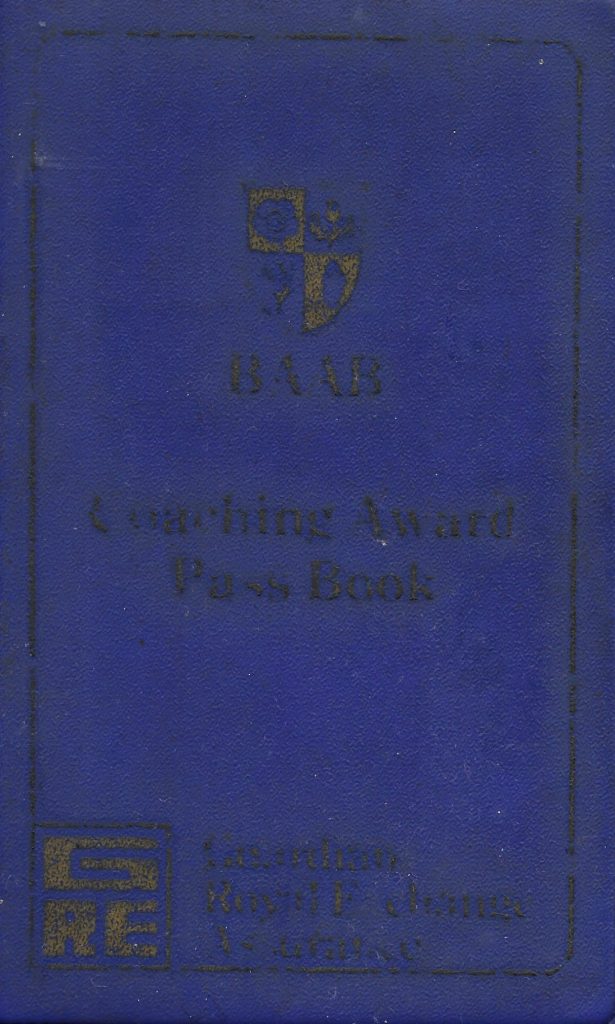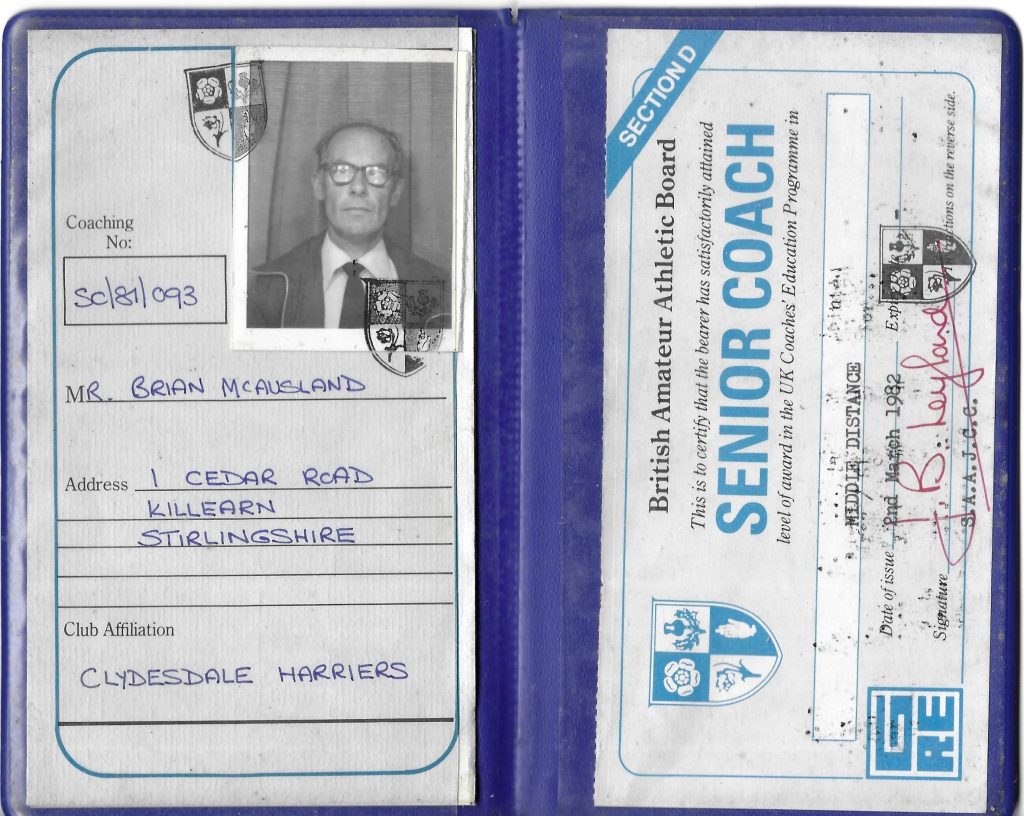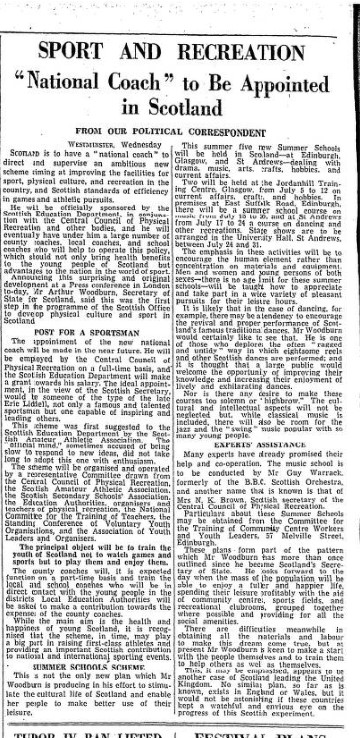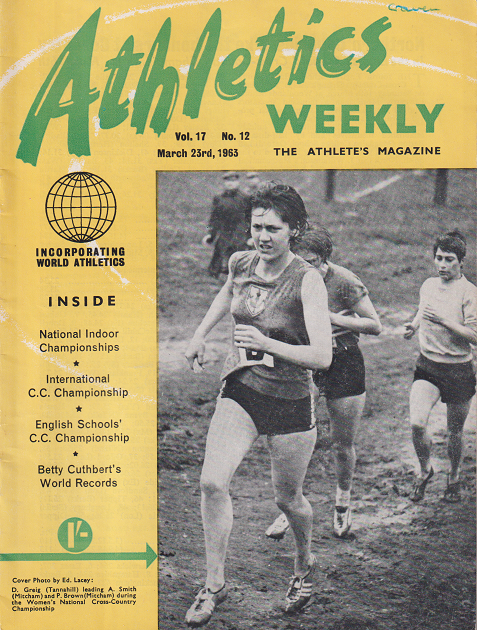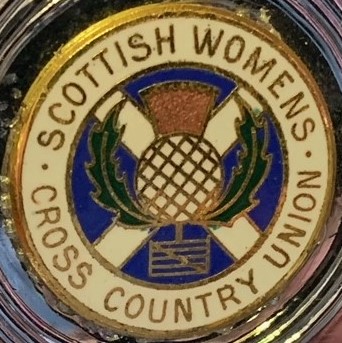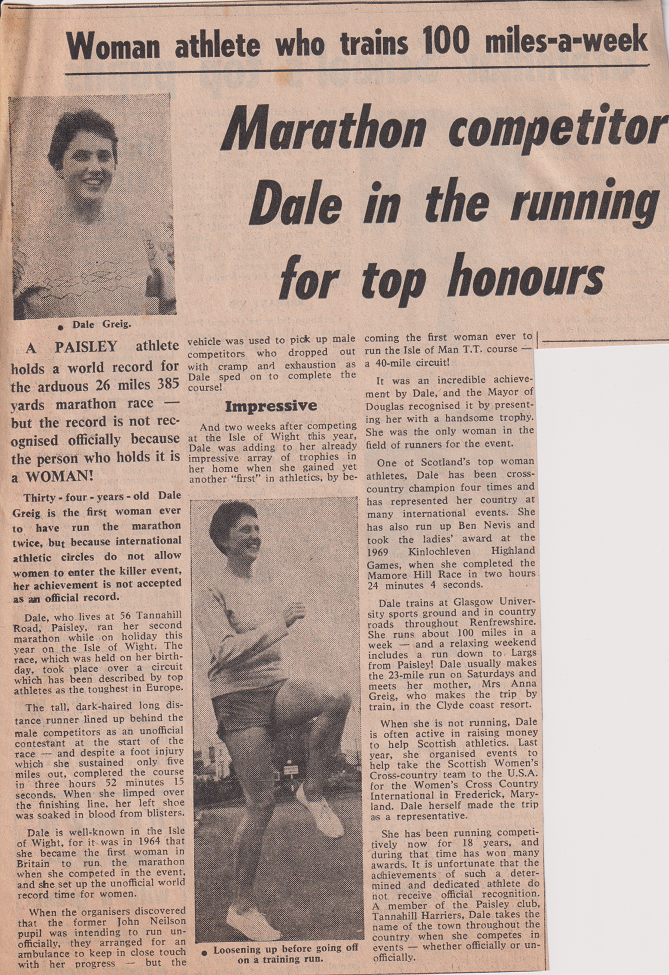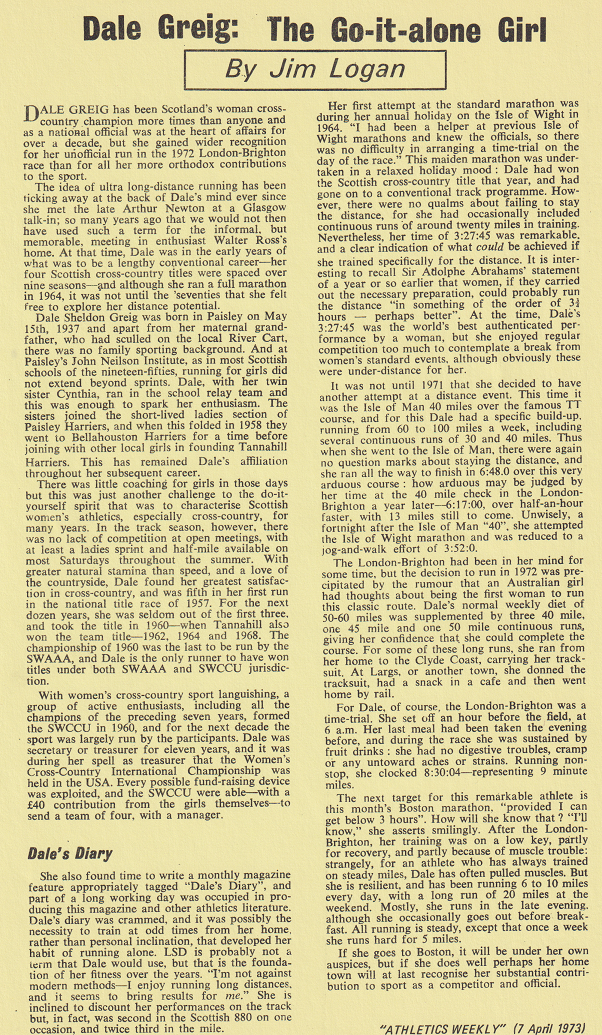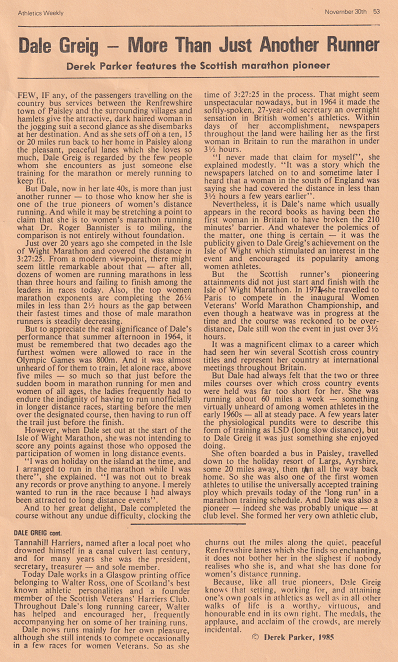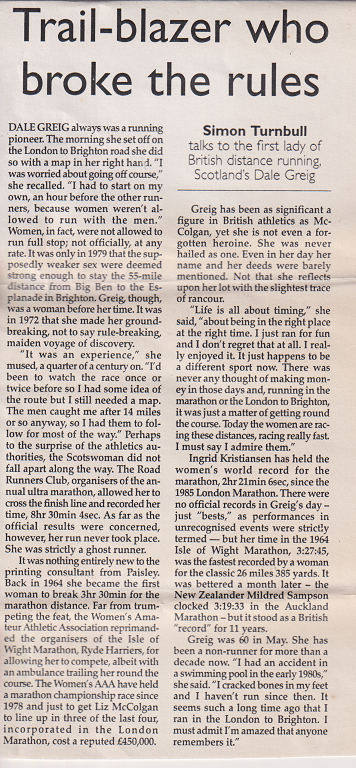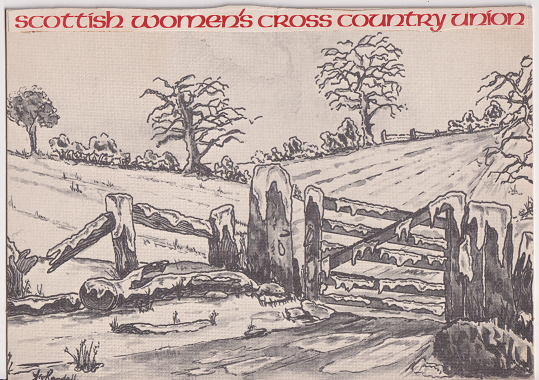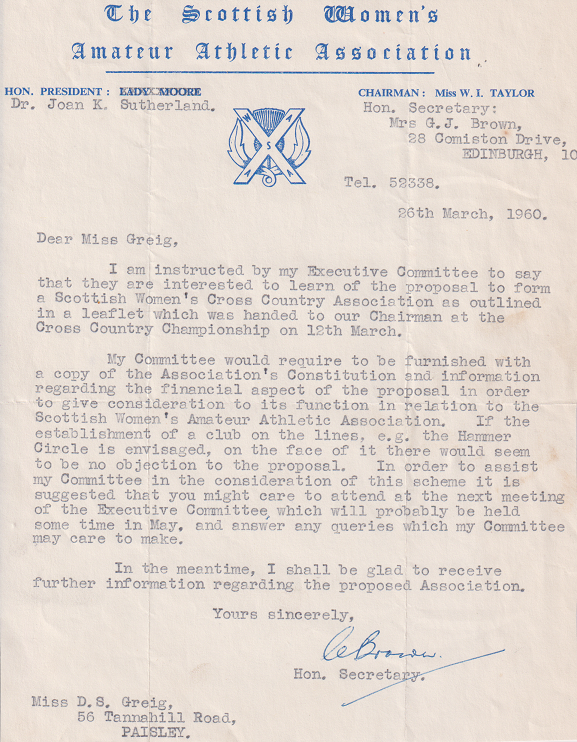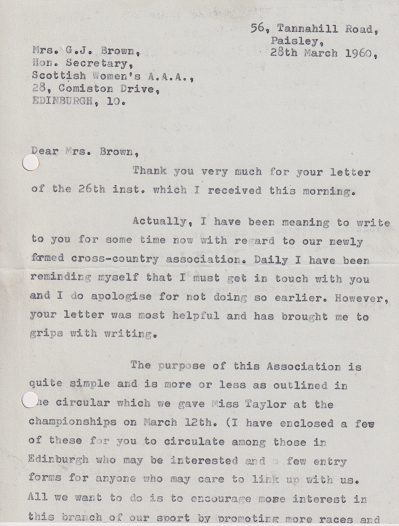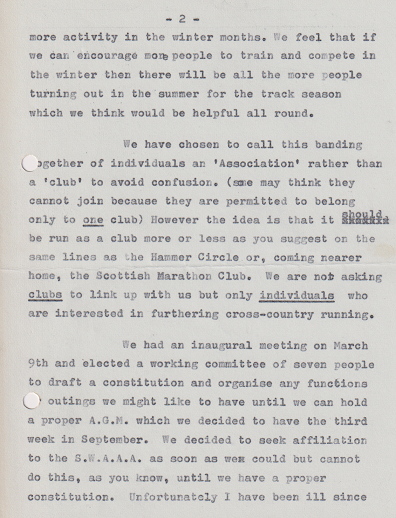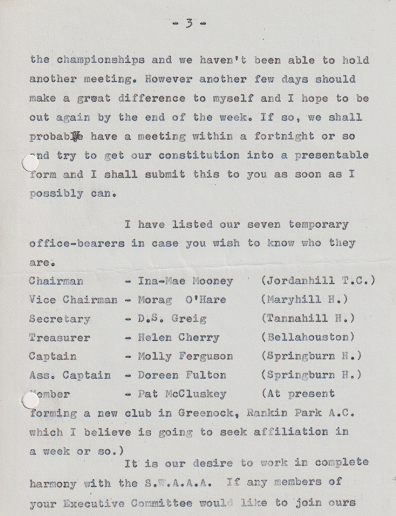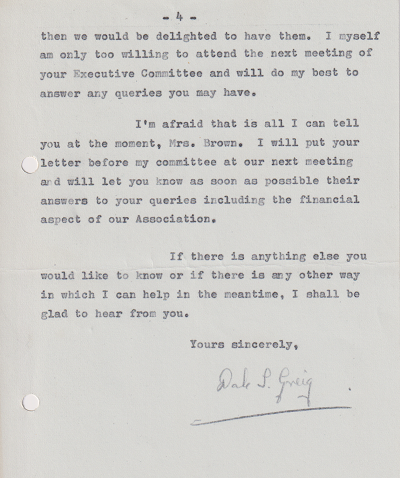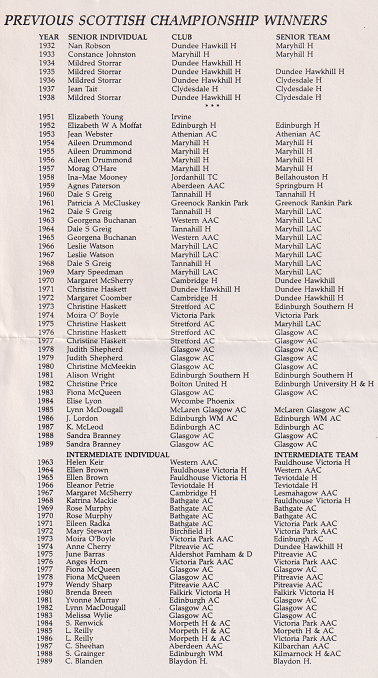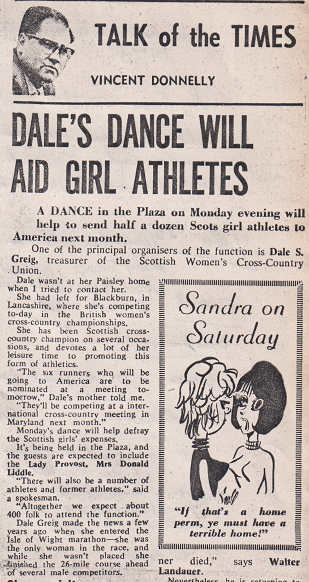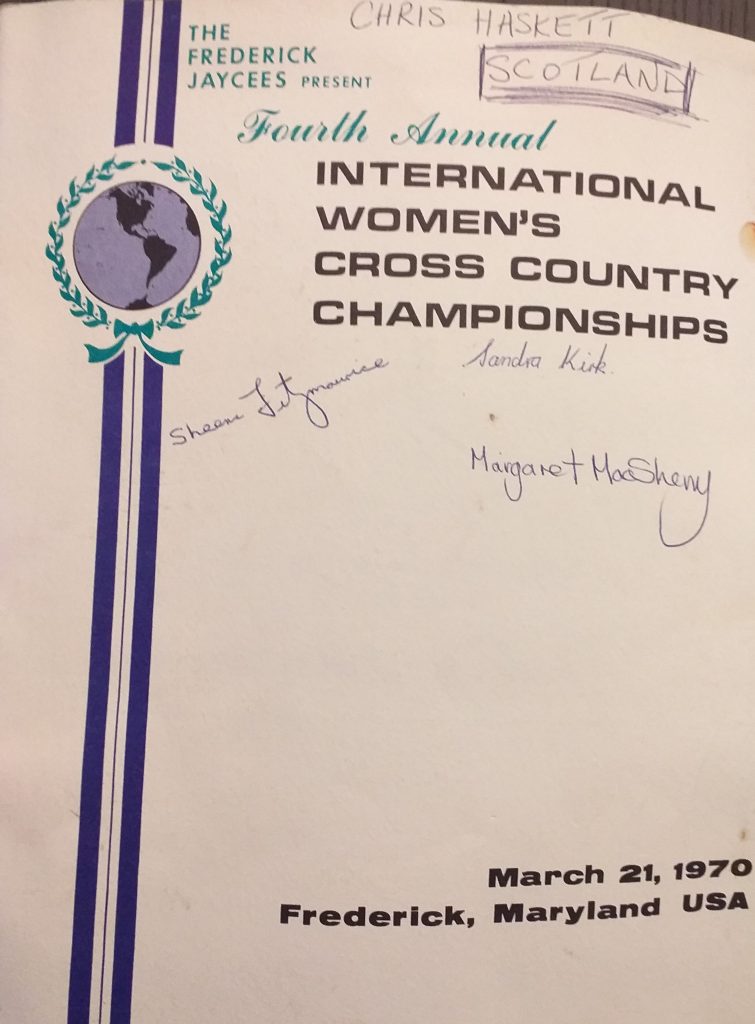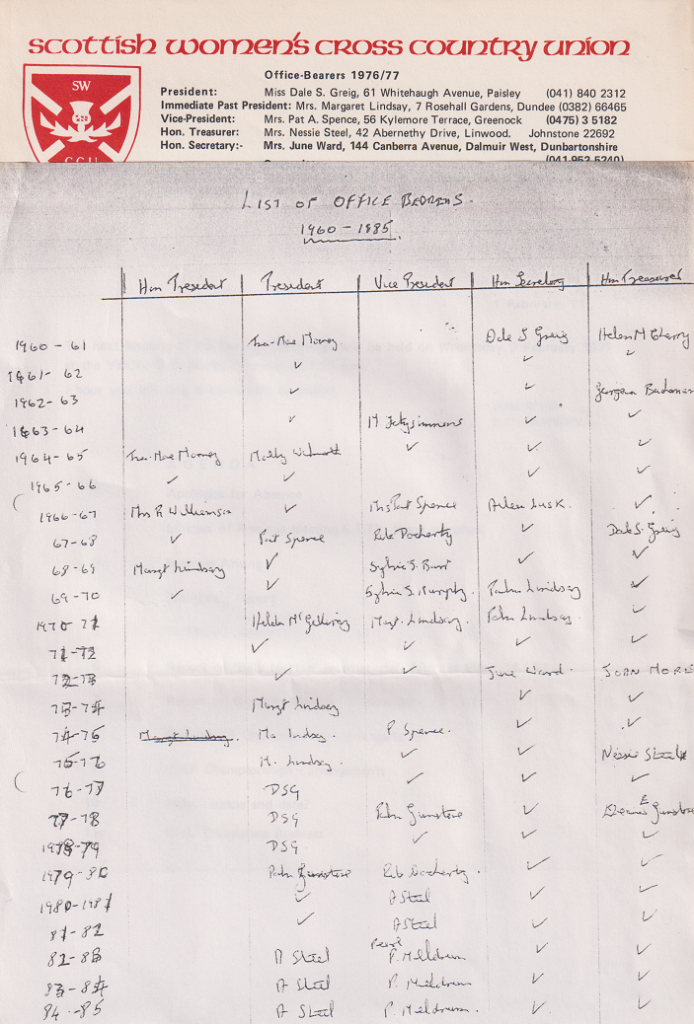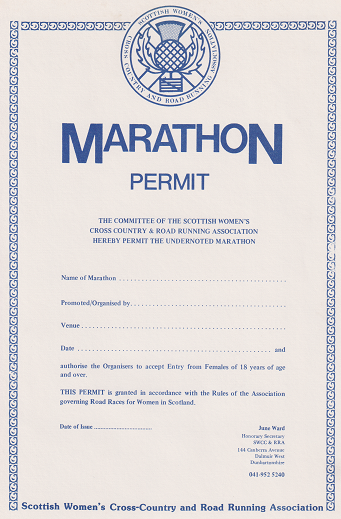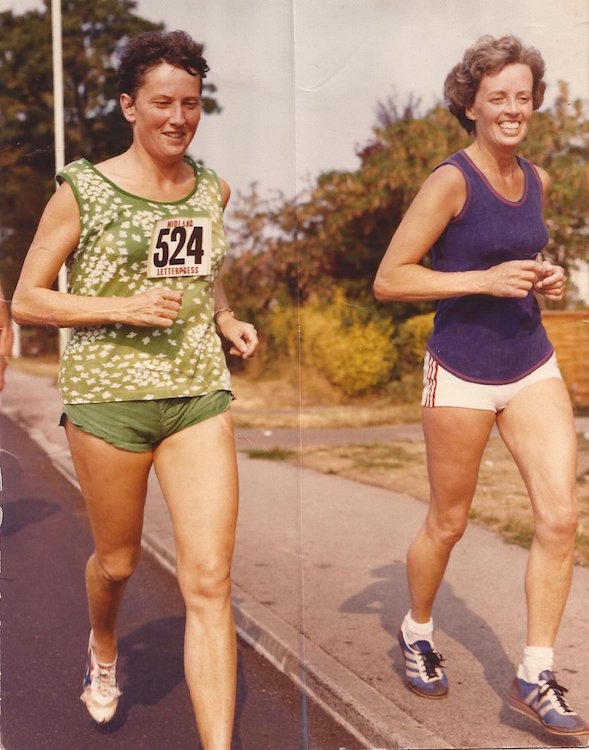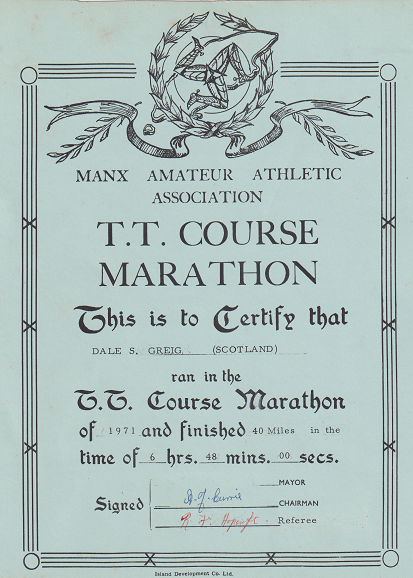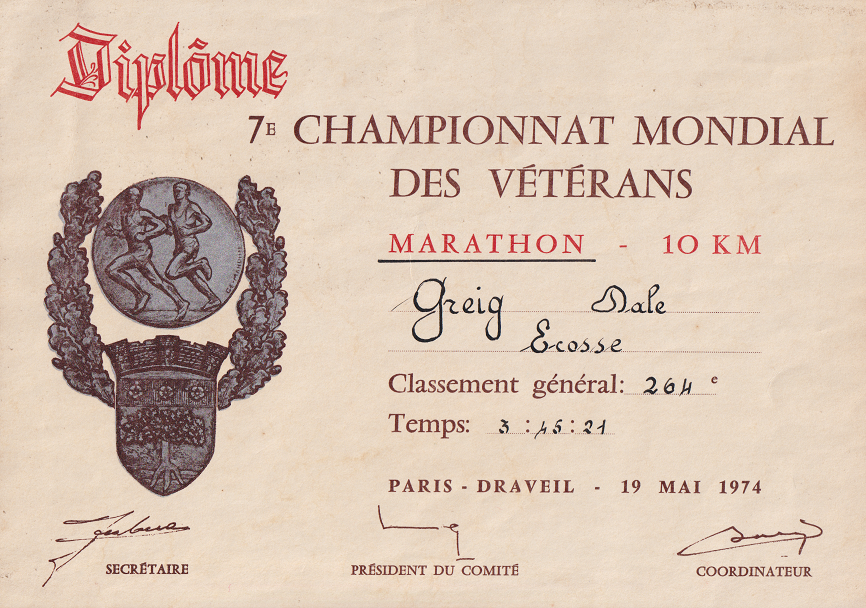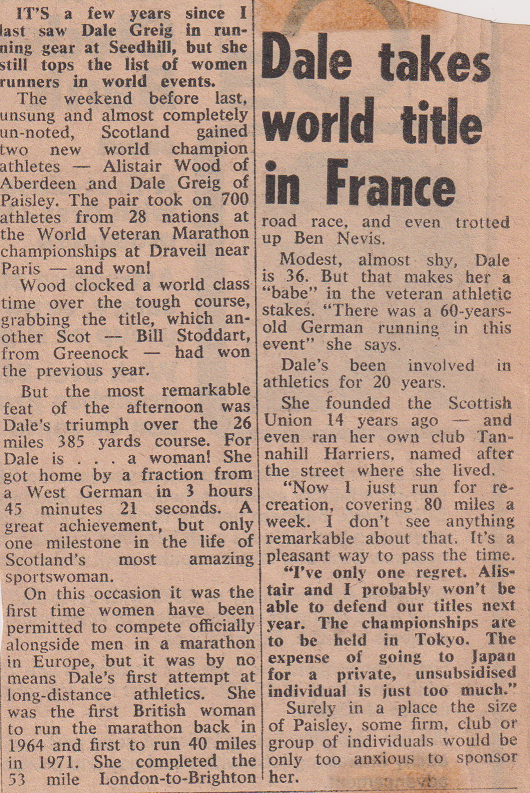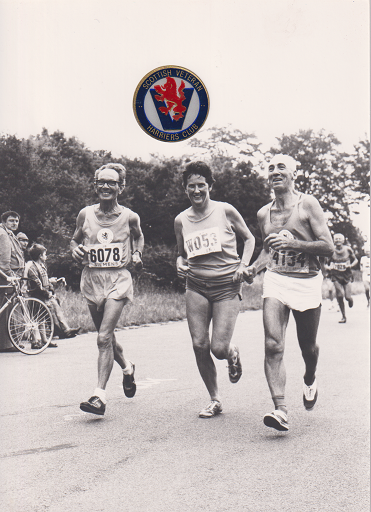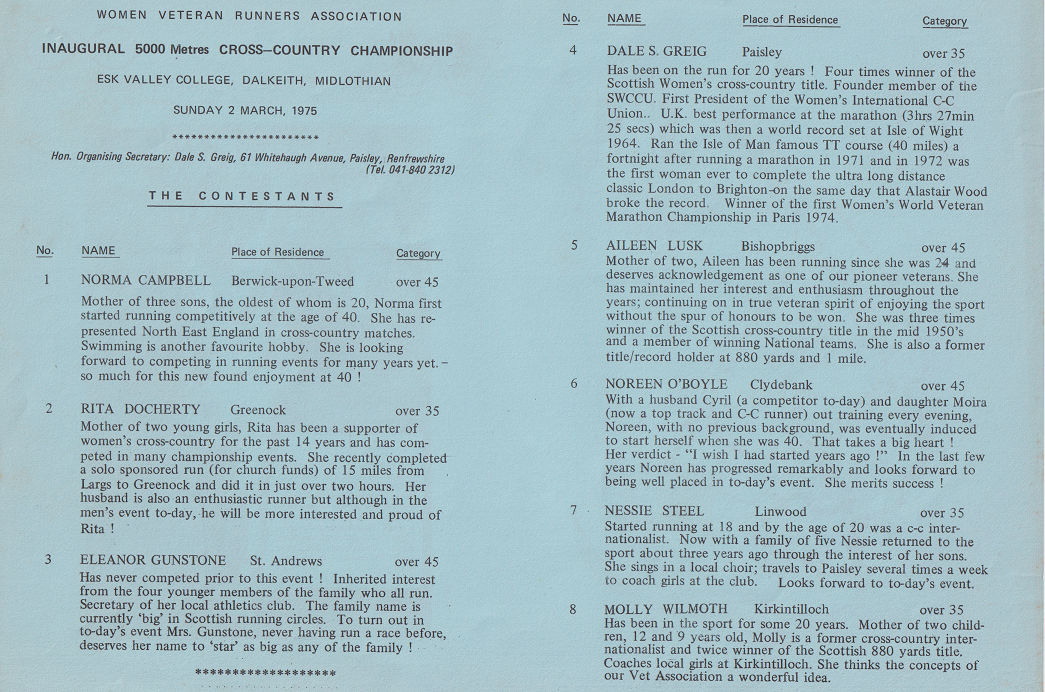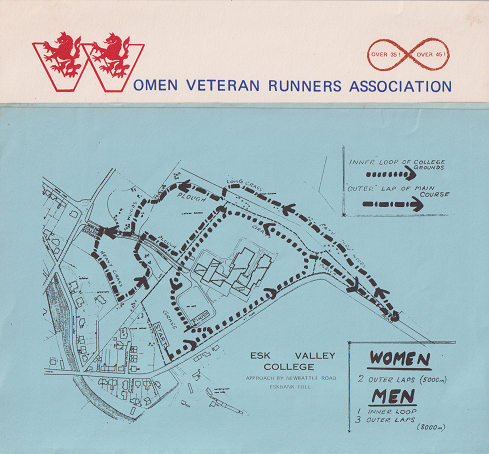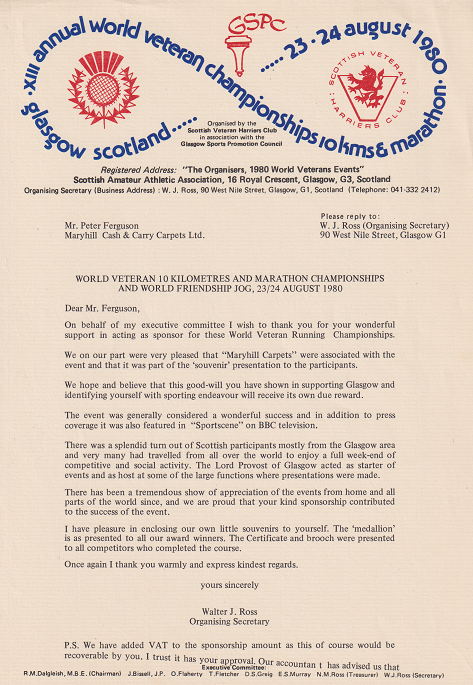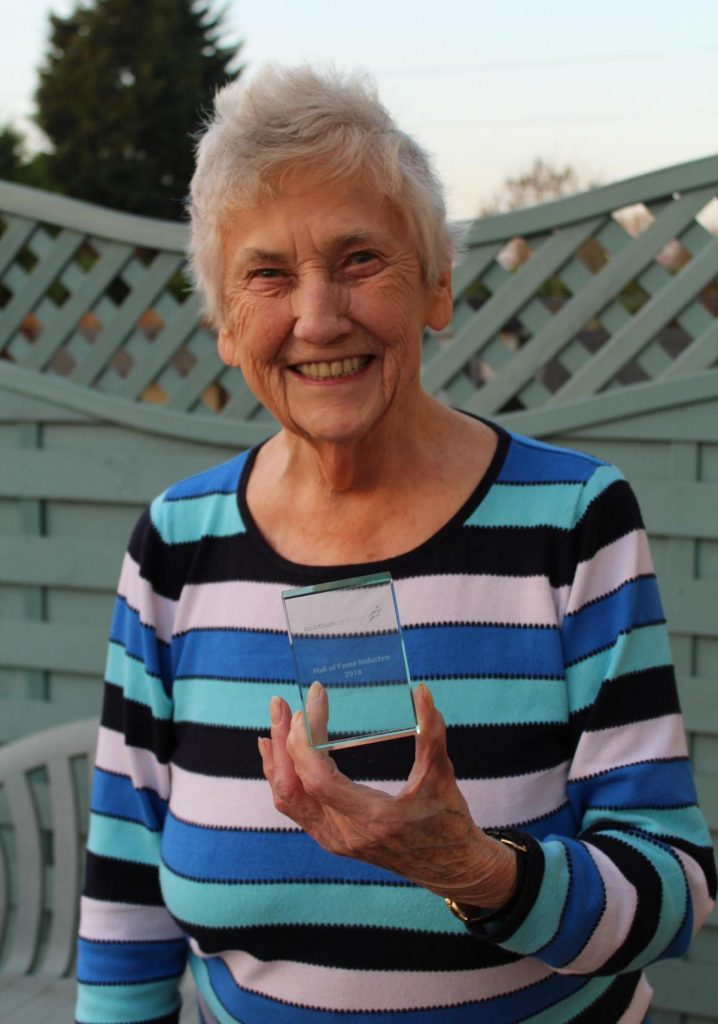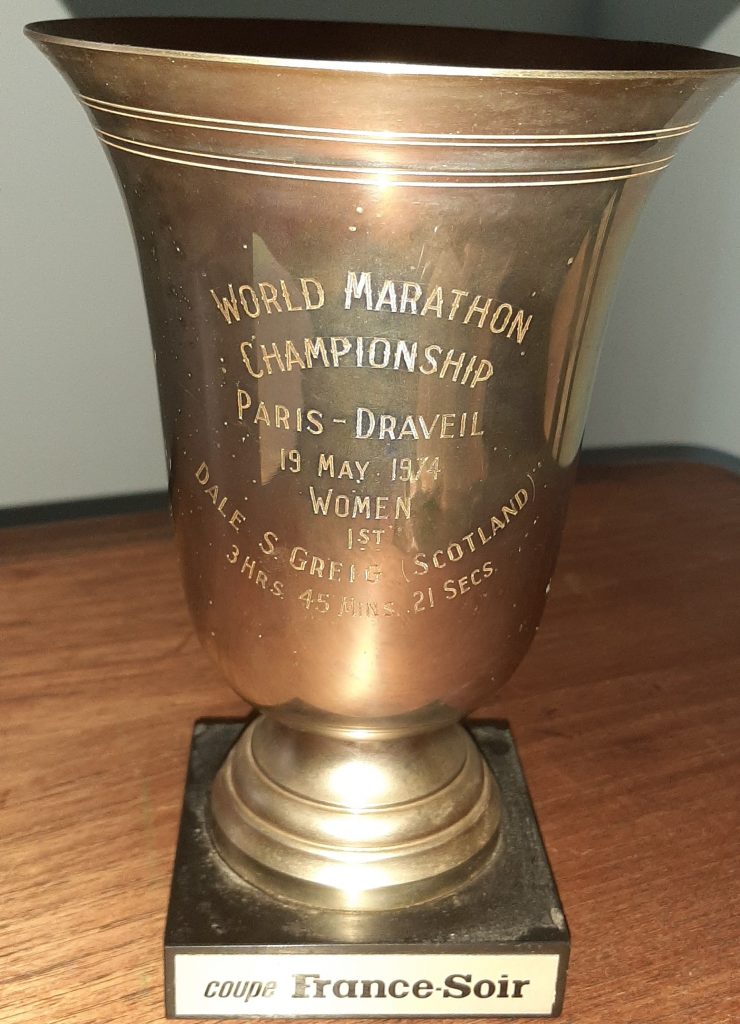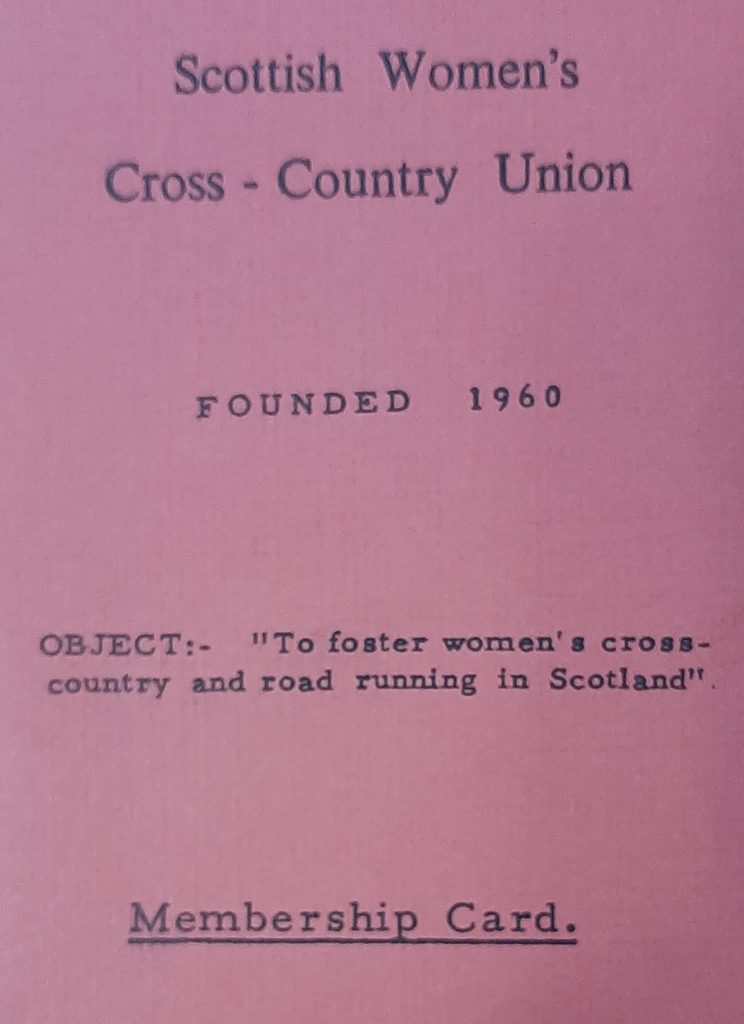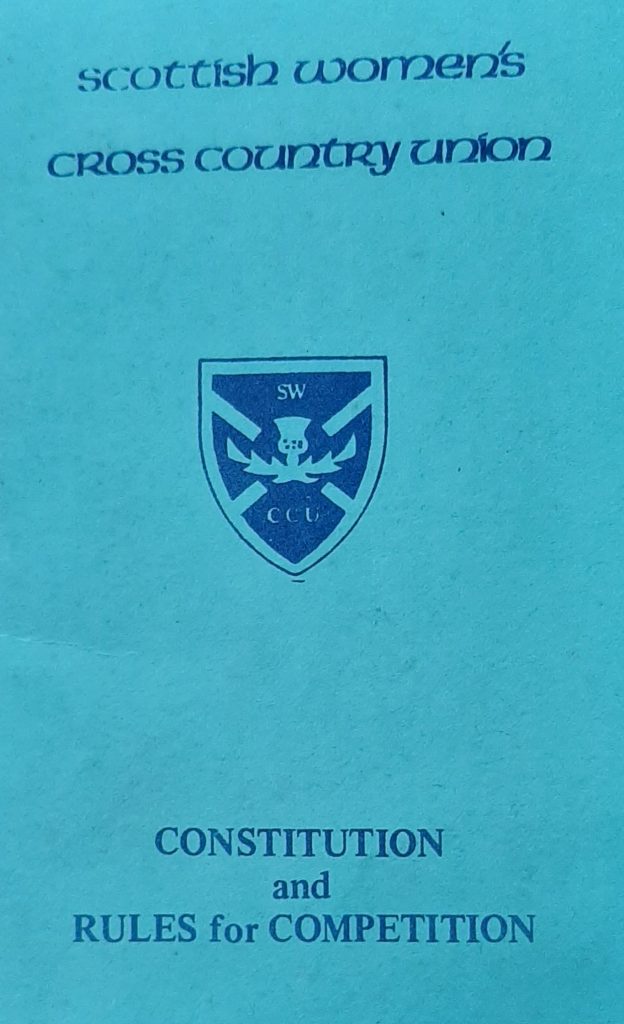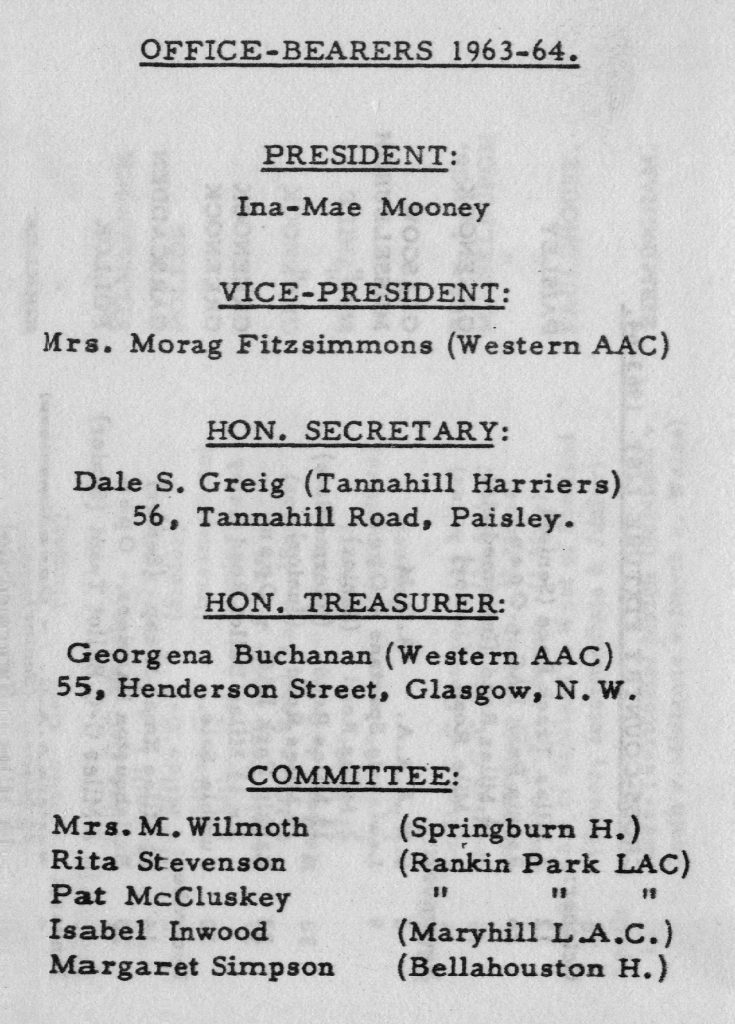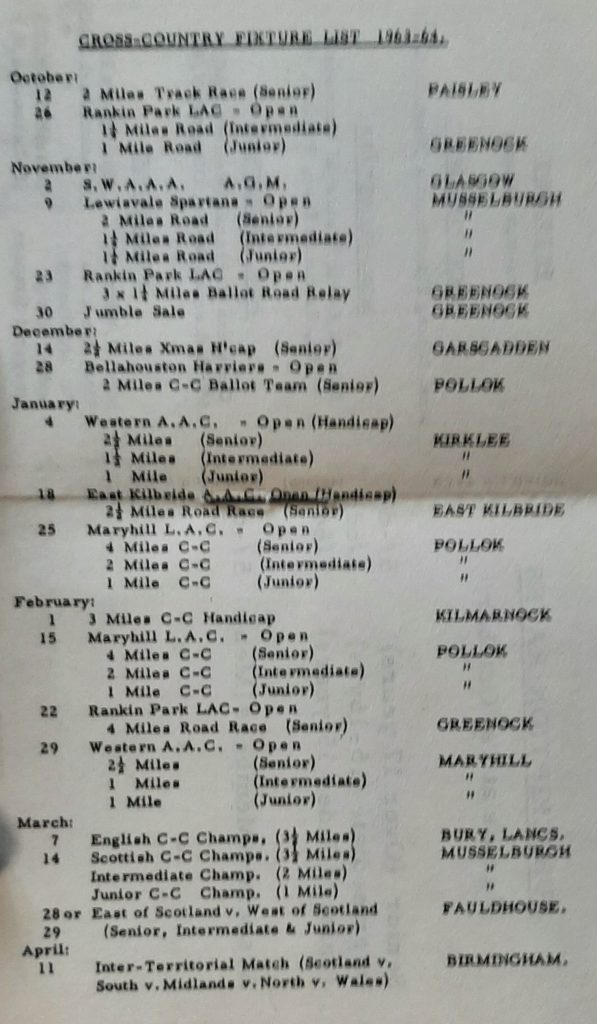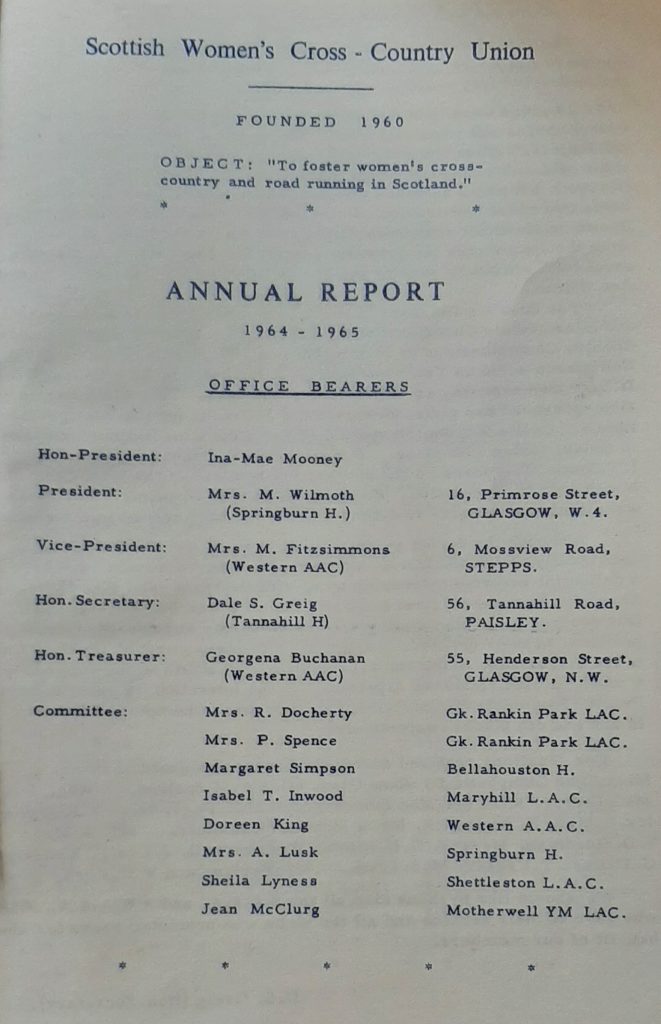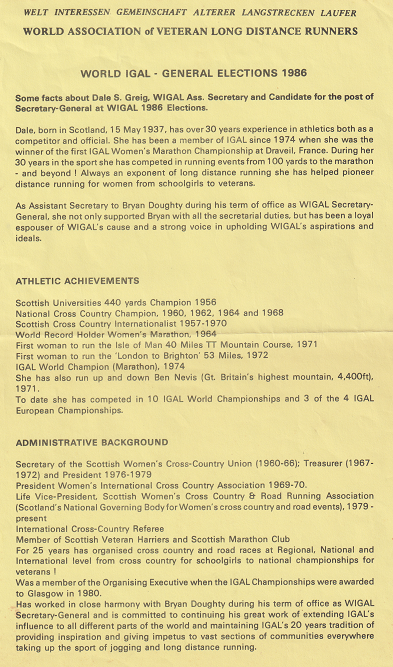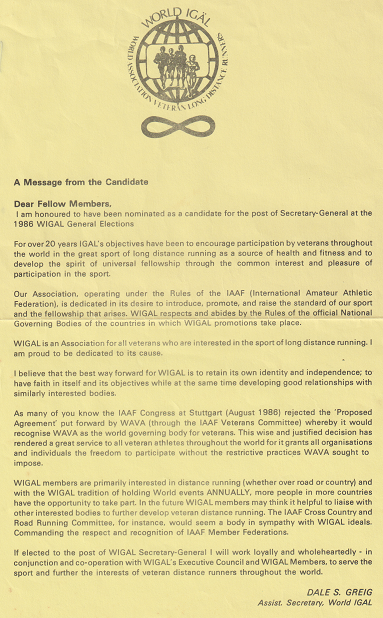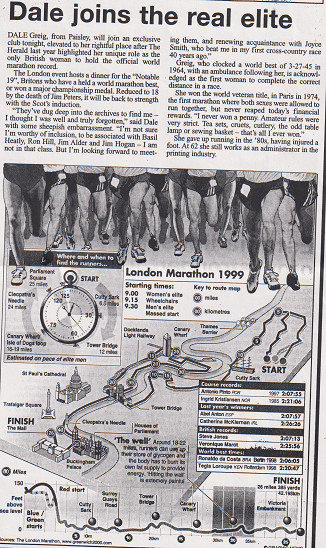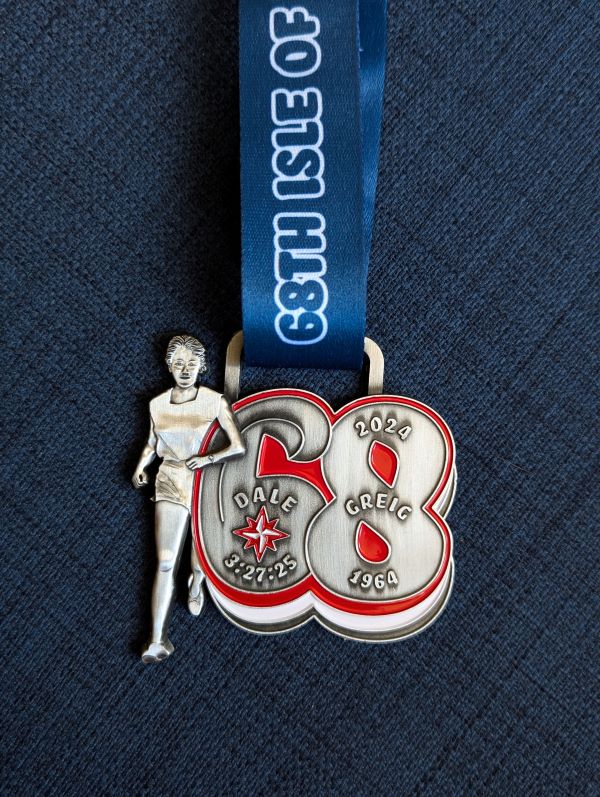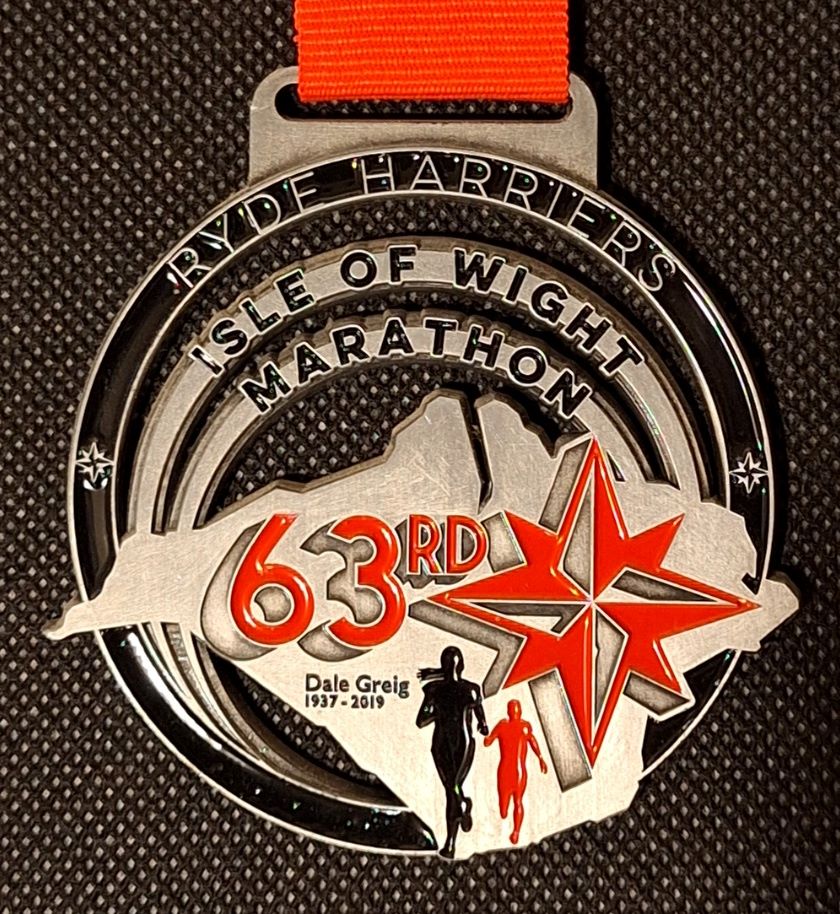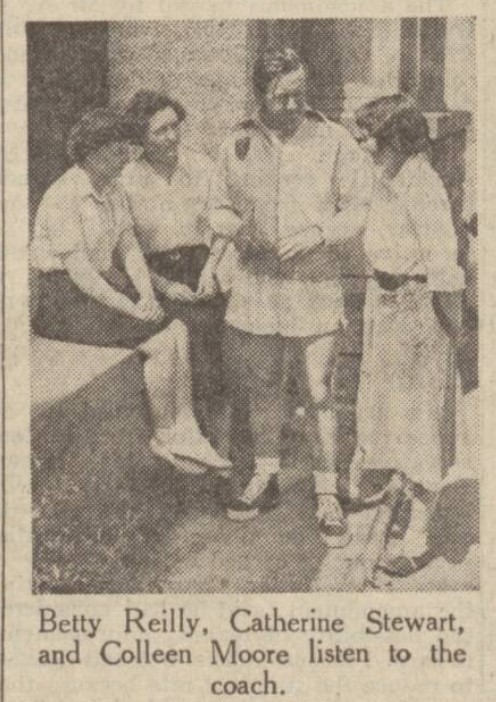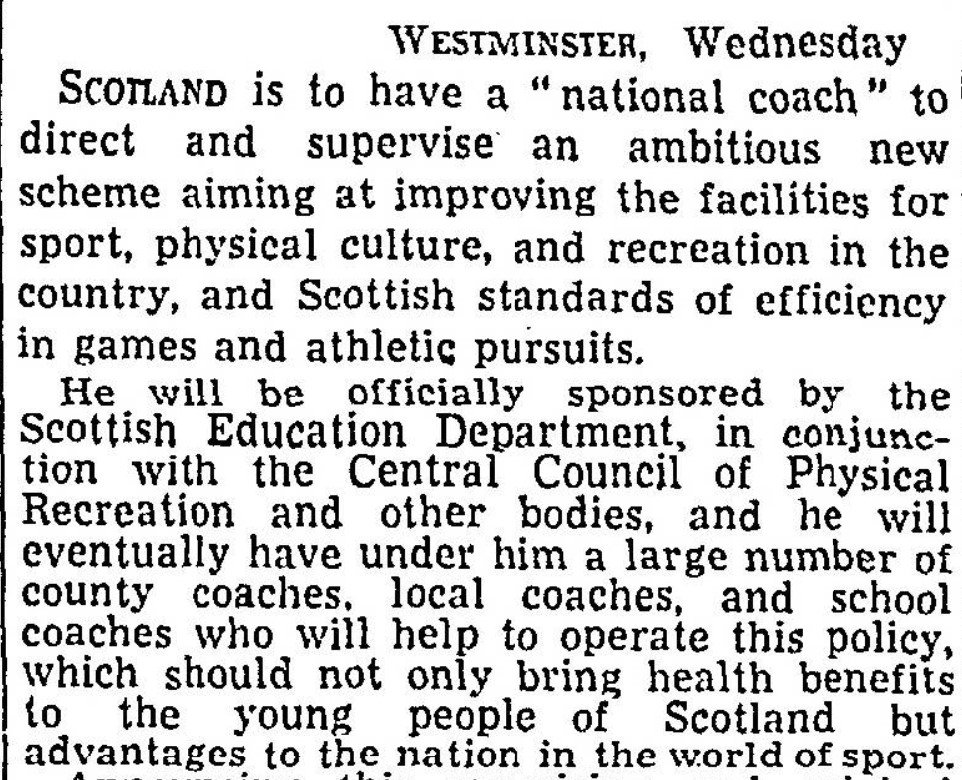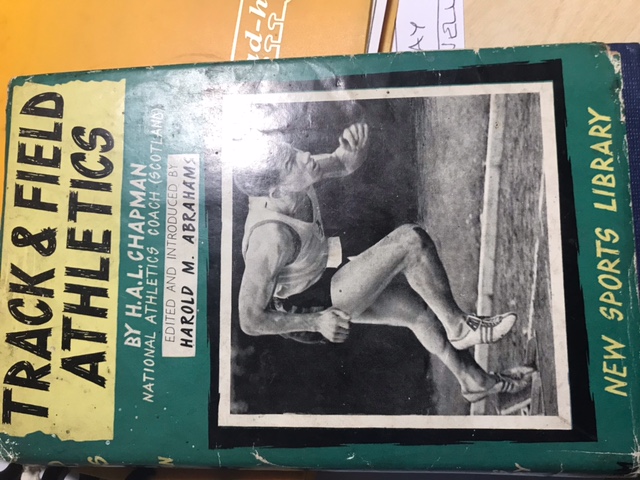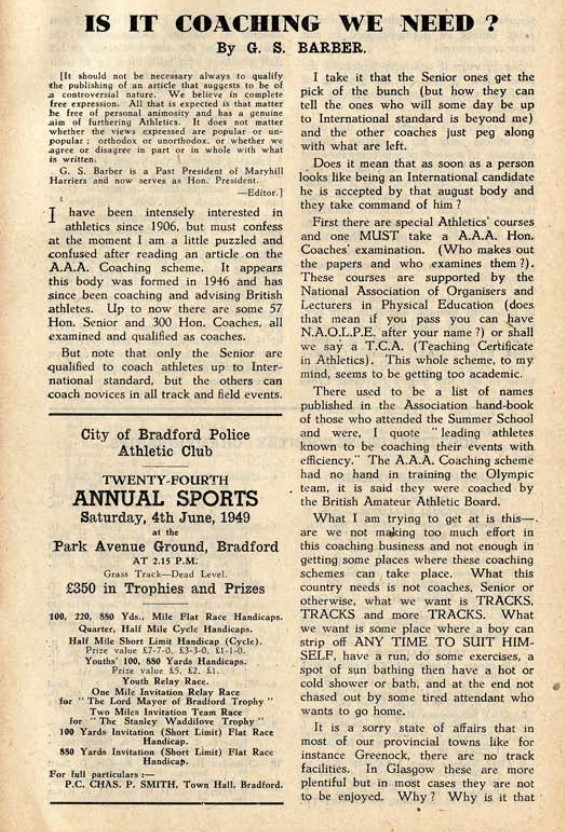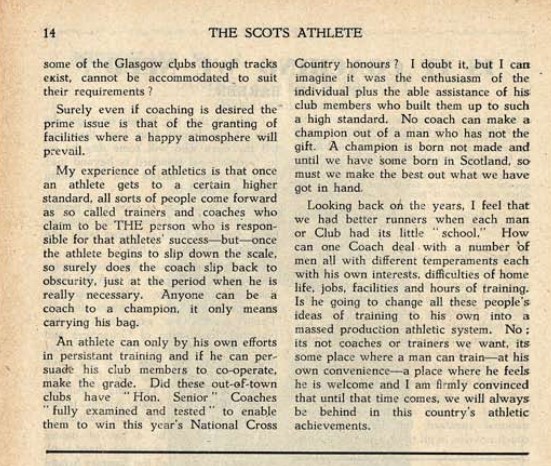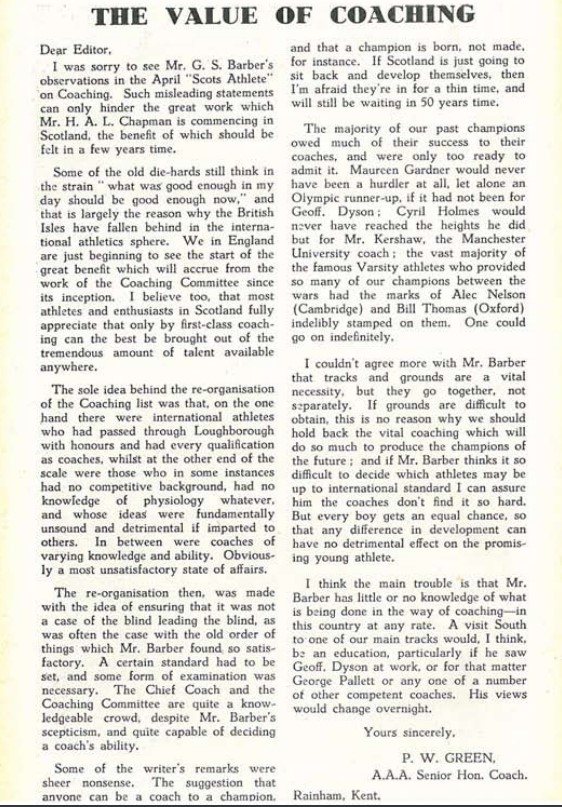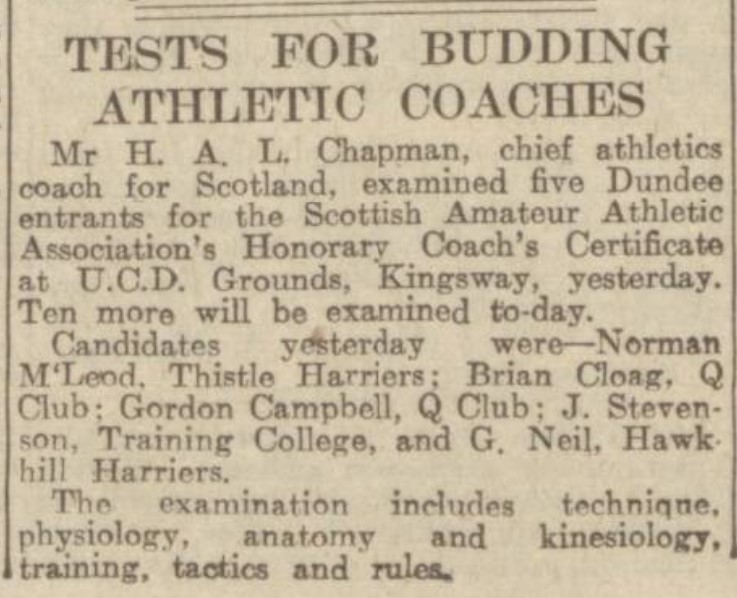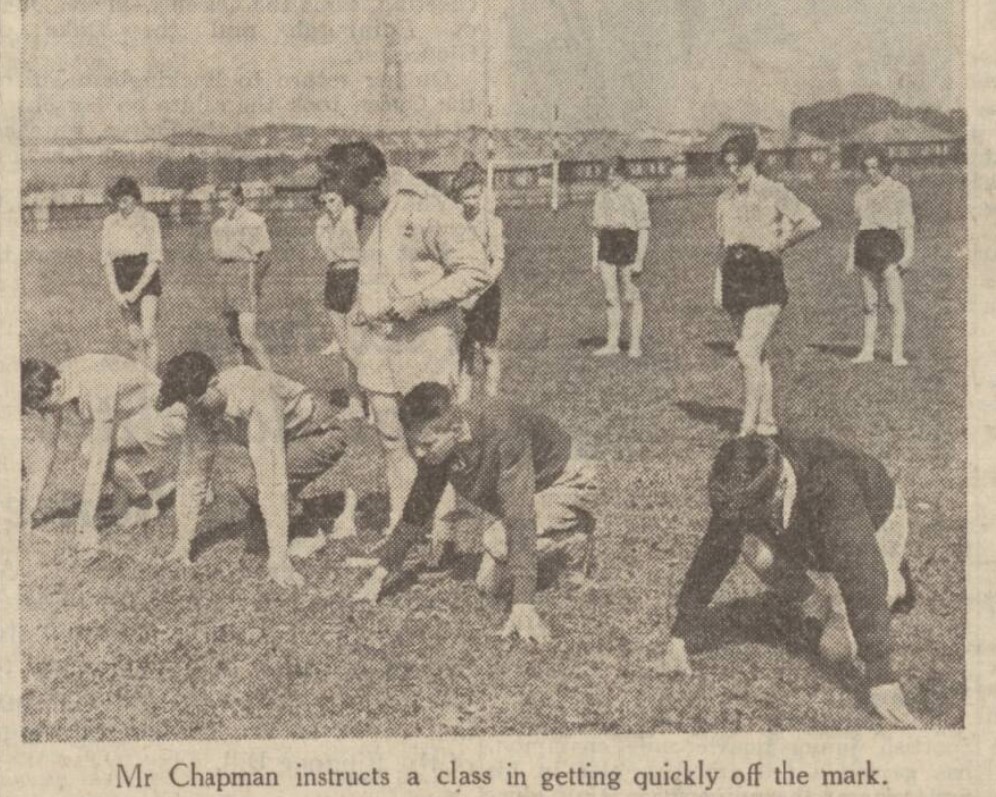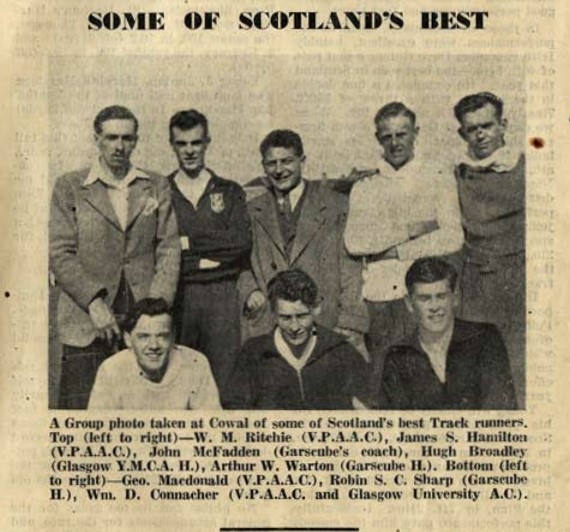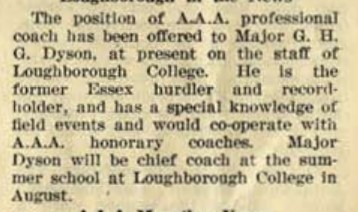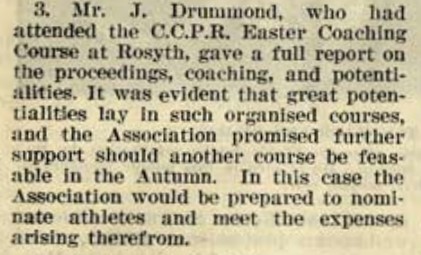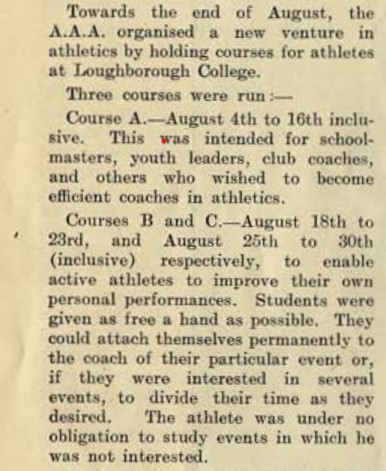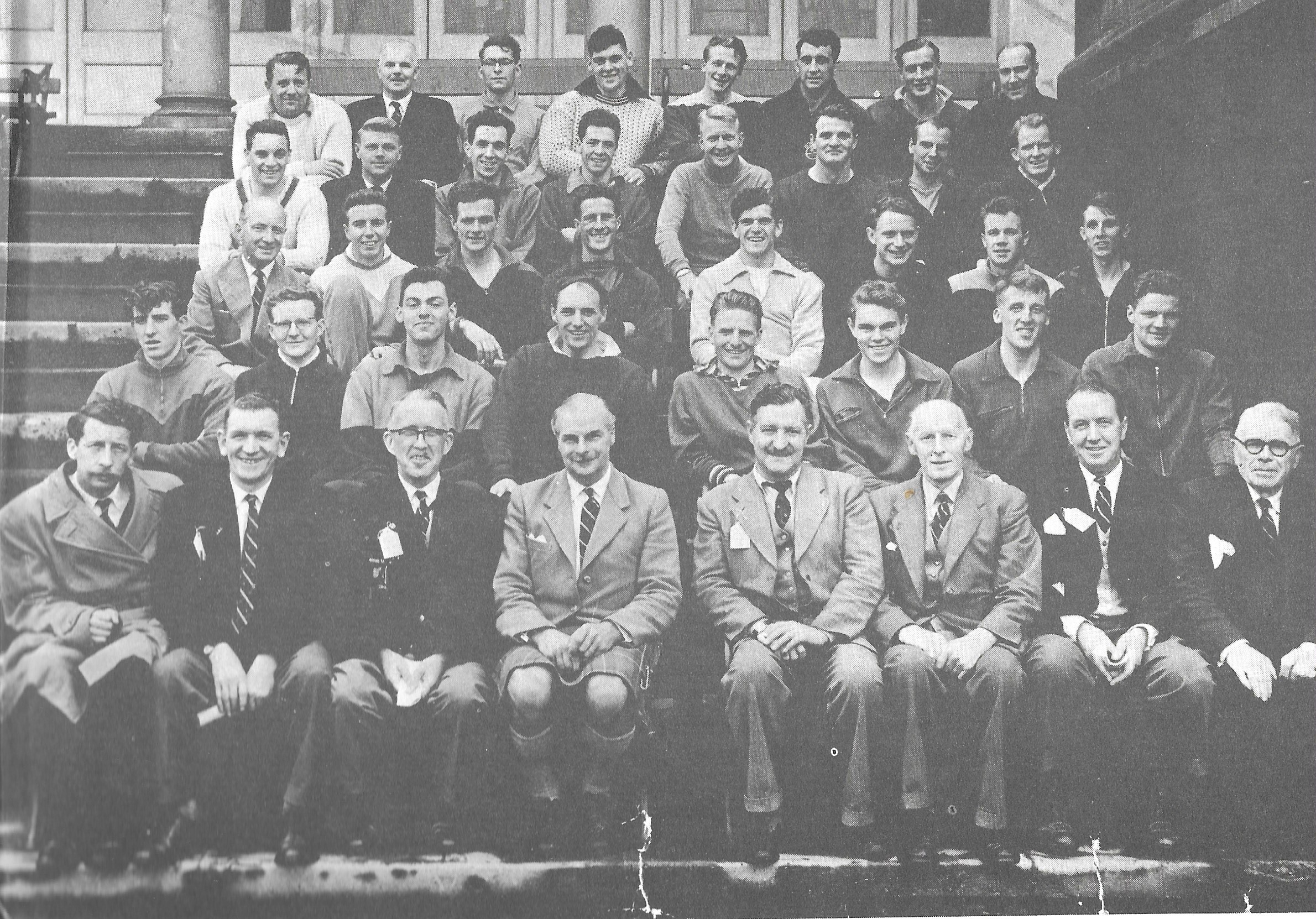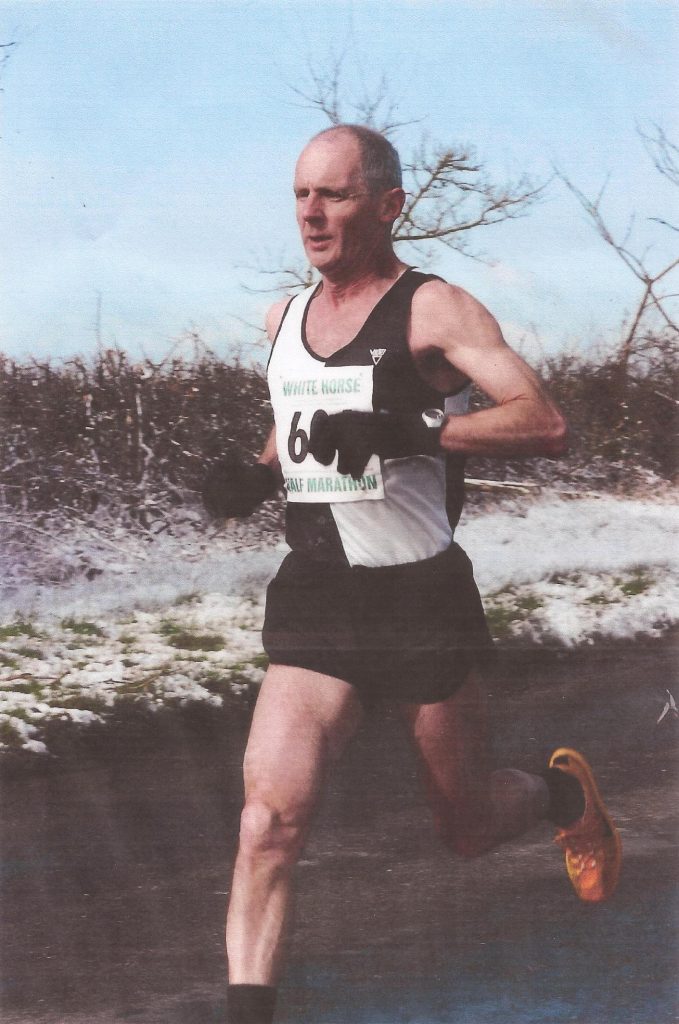
Brian Gardner’s detailed, five-section memoir – ‘No Cross-Country for Old Men’ – is fascinating to read. Not only is it very well written but, with complete honesty and wry humour, it also traces the highs and lows of life (sporting and otherwise). Brian had considerable athletic talent, which was nurtured at Airdrie Harriers and Clyde Valley AAC, when he was coached by the great Tommy Boyle. Young Brian was especially good at 800m, 1500m and cross-country. He won a Scottish Schools Steeplechase title. Moving to England (for study and then work) Brian improved his personal bests and finished a very good 14th in the 1979 Scottish Senior National Cross-Country Championships. Sadly, injuries interrupted progress and led to depression. However, this is a tale of amazing resilience, recovery and achievement, against the odds. Even after his tenth operation meant complete retirement from running before the age of 60, Brian switched to competing in Open Water Swimming. (Earlier, he had also won a British title in the sport of Modern Triathlon (Swimming, Shooting, Running).
Section Four, below, deals with Brian’s stellar running career as a Veteran athlete (M40 to M55). Read and enjoy!
(As paperback, hardback or e-book/Kindle, the whole book is now available to buy from amazon.co.uk Just type in ‘No Cross Country for Old Men by Brian Gardner’.)
No Cross-Country for Old Men
By Brian Gardner
The Closing Laps: Veteris
Chapter Fourteen: Crisis
The summer of 1993 was disrupted by another operation, although not for a sports injury: it was a vasectomy. Recovery was supposed to be easy but, thanks to an infection, it was more painful than the last two operations put together.
Going into the biathlon season, I was swimming more often than running. The climax of this was silver in the National. Then they changed the rules, imposing an additional handicap of minus 200 points on every competitor under the age of forty, effectively taking us out of the reckoning. I had one more year of modern triathlon and biathlon in 1994, unsurprisingly without medals, and then decided to return to running. I had joined the newly-formed Calne Running Club and thought it was time to say goodbye to the track, return to my cross-country roots and enjoy some low-key road races and relays.
The road relays were fun, always ending in the pub. I was elected club captain and also ‘player-manager’ of the Wiltshire men’s cross-country team. My final race of the 1995/96 season was in the Wessex League at Blandford where I clinched third place overall after improving from eighteenth in the first round to second. It was twelve years after my last medal in the same league. The standard in the league had slipped, like most of UK distance running. It was my final race as a senior because two weeks later I turned forty.
And became a veteran.
I wasn’t tempted by the disappearance of the 200 points penalty that a return to modern triathlon would bring. Armed with the knowledge gained from coaching and coach education as well as twenty-three years of running, I was preparing for a season at 800 metres and 1500 metres.
Not the marathon?
Here’s how the conversation goes, one that has been repeated ad nauseum many times since the marathon boom of the early eighties.
‘So, you’re a runner, then?’
‘That’s right.’
‘Marathons?’
(Notice it’s always ‘marathons’—plural—as if one marathon isn’t enough.)
‘No, not marathons. I run track and cross-country.’
‘How far is that, then?’
‘Well, there’s 1500 metres on the track.’
‘1500 metres: that’s not even a mile.’
‘That’s right.’
‘Not much of a challenge, is it?’
‘Well, it depends how hard you run it.’
‘But marathons are a bigger challenge, aren’t they? You could move up to marathons, couldn’t you?’
‘No, thanks.’
‘Why not?’
‘Because I enjoy running 1500 metres and cross-country. I want to try my best to improve my times and win championships.’
‘How far is cross-country, then?’
‘It varies, usually about five miles.’
‘Oh well, then you could probably manage marathons; really test yourself.’
*******
Approaching the bell at the end of the first lap of the 800 metres at the South West Veterans Championships, Exeter.
A balding runner moves up alongside me, vying for pole position.
An old balding bloke? I can’t let somebody like that beat me. But, hang on: I’m an old balding bloke. (I’ve been warned that there’s something uncomfortable about being at an event when everyone is over the age of forty.) I pick up the pace and hold the bend.
And win in 2:05.0.
An hour later, I’m watching the back of the early leader of the 1500 metres as he pulls away.
But only so far, then I start to reel him in.
200 metres to go, I’m on his shoulder. Do I take it on now or wait until we’re in the final straight? I’m feeling good: let’s go now.
I win in 4:15.8.
It’s my first veteran-only competition and I’m a (double) South West Champion.
So far, so good.
*******
On reaching the age of forty, many runners think it’s going to be easy: they’re the youngest, all they have to do is match times achieved in their late thirties and they’ll win. It’s not that easy: it’s more about managing your inevitable decline than being a slave to your times from younger days. And it’s competitive: standards are high at the top level of the ‘vets’.
My training was going well. I was following the five-tier system: progressive sessions at 400 metres, 800 metres, 1500 metres, 3,000 metres and 5,000 metres pace. A progressive competition programme was more of a challenge: there was the Wiltshire Senior Championship and the occasional open meeting but Calne had no track team: I was the only one. However, I did manage to run 2:01.2 for 800 metres leading up to the British Veterans Championships and a return to Exeter.
The 1500 metres on Saturday was a straight final. Showing some of my old aggression I led for the middle section and wound up fifth in my fastest time of the season—4:12.38—a pbv (personal best as a veteran). Looking at the results on the board, I thought about changing my name to Dave: all four in front of me were Daves. I won my heat in the 800 metres on Sunday and finished last in the final. This could have been another crying-in-the-showers incident. However, twenty years older, I reflected that 2:03.70 was a respectable time, it was my third race of a weekend that included a season’s best exactly when it should be—in the final of the most important event of the season—and it had been a successful return to the track.
Encouraged, I wrote to the Scottish Veterans team manager, asking to be considered for selection in the Veterans’ Home Countries International Championship, coming up in November. I wrote about my performances that season on track, the previous season on the country and my fourteenth place in the Scottish in my younger days. Fingers crossed, I posted the letter and waited for a reply.
Meanwhile, we were hosting the first Calne 10K road race, which was to incorporate a veterans’ race and a trophy.
Dad’s trophy.
The year after Dad died, Mum had commissioned a trophy in his memory for the first veteran to finish the annual road race in Airdrie. When the race ceased to be held, the trophy lay dormant in Mum’s attic, from where I reclaimed it and had a new inscription added: First veteran to finish the annual road race in Calne. It was a proud moment when I walked up wearing my Airdrieonians shirt to receive Dad’s trophy.
Unlike the long-running exchange of letters leading to my selection for British Colleges, there was a straightforward reply from the Scottish Veterans manager. It confirmed my selection for the Scotland over forties’ (M40) team and provided details of where and when to meet. With the minimum of fuss, I was on the edge of achieving a lifetime’s ambition: to run for Scotland.
It wasn’t the World Cross but it was the only international veterans’ event of the year when top quality in-depth was guaranteed. Although only five nations gathered for the British & Irish International Cross-Country Championships, this was usually a higher standard than the European and World Championships. Whilst there were stars amongst athletes from all over Europe or the World at the continental or global championships, nobody got there by selection: they all entered as individuals and paid their own way. On the other hand, only selected athletes made the start line at the British & Irish, and competition for selection was fierce.
The championships were hosted on a five year cycle by England, Ireland, Northern Ireland, Wales and, as in 1996, Scotland. In less than glamorous circumstances, I drove to Airdrie after school on the Friday, Susan drove Mum and me to Irvine for the race on Saturday, and I drove back down to Calne on Sunday.
It was a huge thrill to pull on my Scotland vest and line up to represent my country at last. In my excitement I started too quickly but recovered and ran a sensible race thereafter to finish twenty-fourth (eighteenth M40). Overtaking another Scotland M40 in the run-in, I had squeezed into Scotland’s scoring four, helping the team to silver medals. It was my first international medal, although I didn’t see it until a week later: we left before the presentation, because of my early start and long drive home the next day. Once again, I was an unknown: turned up, ran the race, didn’t have time to get to know the team, went home.
But nothing could diminish my sense of achievement. I left wanting more.
*******
Looking for more regular races as my second track season as a vet began, I joined the British Milers’ Club (BMC), which had been set up to raise standards in middle-distance running by providing regular, meaningful competition. I ran for the BMC Vets in a successful world record 4×1500 metres attempt at Watford. Unfortunately, I was in the ‘B’ team, which failed to finish. It was no compensation that we ran a decent 3×1500 metres. However, 4:10.6 was a promising start to the season, nearly two seconds quicker than my best.
But I would run no faster.
It was nothing to do with injury, bad planning or over-racing.
It was the start of a long period of illness.
Brought about by stress.
At school.
It was another crisis.
I came to the village school in January 1996 with a good reputation, forged during six years in Swindon, where amongst my post-Snap projects had been writing and implementing a new Physical Education policy and scheme of work, and grounds development. Raising funds from grants, I coordinated the planting of thousands of trees, hedging, shrubs and flowers. Together with new fencing, bird boxes, extensive pathways and a redevelopment of the pond area, the grounds were transformed from a featureless ‘green desert’ into a haven akin to a nature reserve. Every child in the school was involved: from planting a bulb to designing plans.
It was in the midst of this transformation that the headteacher of the village school came to observe me in my classroom. She was visiting all candidates who were due to interview for deputy head at her school. She liked my style of teaching and saw in me what she felt her school was missing: a leader with a firm understanding of the curriculum.
I should have heeded the warning signs but, excited by an opportunity, I was in denial.
It was my tenth interview for deputy headship: could I not see that the previous nine were trying to tell me something? There were ninety children on roll in the village school but the headteacher did not teach a class. Did that not ring any alarm bells for me? She wanted a deputy head with a firm understanding of the curriculum. Is that not the headteacher’s job? What had she been doing with the curriculum so far? The Swindon school was in a relatively poor area where most parents took little interest, whereas the village school was in a middle-class area, where most parents wanted to be involved, not always in a positive and helpful way. Could I not see that transplanting ideas and methods from one school to the other was going to cause problems?
If only we could benefit in advance from hindsight. In ignorance I blundered into the crisis. As well as teaching my class full-time, I developed policies and schemes of work—none of which were already in place—in every subject area. Inevitably, in the limited time available, this work was rushed, without full consultation or involvement of staff and governors. Everything had to be in place by the end of the year and a half between a worrying pre-inspection review (before my time) and a forthcoming Office for Standards in Education (OFSTED) inspection. I tried to teach my class with the same methods that had brought success before, not giving myself time to think that this school and these children required a different, bespoke approach. Almost idiotically, and shortly after joining the school, I volunteered to coordinate another grounds development project.
The number on the school roll increased to over a hundred during that year and a half.
And still there were only three classes, not the more obvious four.
My own class grew from thirty-three to thirty-nine, made up of all of the Years 2, 3 and 4 children.
And still the headteacher did not teach a class.
It was a recipe for disaster.
By the time the inspection week came along, I was running ragged.
The school did not fail the inspection.
Neither did I.
The school was not put into special measures.
Neither was I.
But strong recommendations were made.
And it appeared that I was to be the scapegoat.
Had I suddenly changed from being a good teacher to a poor one?
*******
‘It’s not our job to advise; would that it were’.
‘Improve the teaching in the middle class.’
‘This is down to you.’
‘If you walk out of that classroom now, you’ll never come back.’
‘Go and have your nervous breakdown somewhere else.’
*******
Driving home on Friday at the end of OFSTED week.
I haven’t failed, but I’m a failure.
As a teacher.
As a husband.
As a father.
As a person.
When I get home and walk through the door, what am I going to do?
What do I say?
How am I going to get through the weekend?
And go back to school on Monday?
How do I face that?
How do I face…
Anything?
On the edge of a steep drop.
Why not…
Drive the car…
Over the edge?
Turn the steering wheel.
Crash through the fence.
Let go of the wheel.
Let go of everything.
Let myself go…
Over the edge.
End it all.
Is the drop steep enough?
*******
The edge of a cold loch.
I didn’t do it then.
I found a way forward.
I won’t do it now.
I’ll find a way.
But how, what?
*******
Friday evening.
I’m sitting on our kitchen floor, rocking back and forth.
Jane makes an appointment with our doctor.
For Saturday morning.
*******
‘You’re ill. You’re not going back to work. I’m signing you off. Taking you out of the situation that’s causing you this stress.’
I’ve never been off with stress before.
I’ve always kept going.
Have to keep going.
Can’t let the children down.
Can’t let the family down.
Have to keep the income coming in.
‘You’re ill. Your priority is to get better. It’s the only priority.’
Okay, I’ll go off sick.
But after I write the reports, after I take the class on a planned trip, after I finish…
‘No. Someone else can do all that. You’re ill. Go off sick now.’
*******
I’m in my classroom.
On Saturday morning.
We’re all there: Jane, Sam, Emma and me.
It’s a compromise.
Put things in place to make it easier for a supply teacher to take over.
Then go home.
Phone the head.
Go off sick.
Stay off.
Three hours later, that’s exactly what I do.
*******
Three weeks later.
Sixteen years of teaching plus four in training.
Twenty years.
I had never been off sick for three consecutive weeks before.
It had never before occurred to me to go off sick, despite the obvious signs and symptoms that I was suffering from work-related stress. I had responsibilities to the school. I had to keep working, get through the OFSTED week, do my best to take the school forward.
Nor had it occurred to me to give up teaching altogether. I had responsibilities to the family. I had to provide for them. How would we manage without an income?
I had responsibilities to myself, too. I had trained for four years and had been teaching full-time for sixteen. It was my vocation. It was part of me. I couldn’t give it all up after twenty years.
Could I?
Then I discovered that income wasn’t an issue: I would be paid 100% of my salary for six months and then 50% for a further six, when sick pay would make up the difference. For a whole year we would be no worse off.
A whole year.
Would I really be off sick for a whole year?
Then what?
‘Deal with that when it comes,’ my doctor advised. ‘I’ll keep signing you off. Concentrate on getting well.’ He prescribed anti-depressants and referred me to a mental health consultant.
I thought I was the only one.
‘You’re not the only one,’ my doctor assured me. ‘There are hundreds, maybe thousands of teachers just like you.’
This was 1997.
People still didn’t understand mental health, especially men’s mental health.
But there were exceptions, including our GP. It could have been so different: he could have been dismissive. And I had experienced enough of that when I was first injured. But he understood, knew exactly what to say and what to do. Set me on the road to recovery.
A long road
Chapter Fifteen: Tribunal
Who were these thousands of teachers like me? I’d never met any of them. Never heard of anyone. Were we all in denial?
Until I bumped into a former colleague from Swindon, outside the Co-op in Calne. She was off sick too. Her feelings were similar to mine: despair, uselessness, anger, wanting to blame someone, blaming herself, feeling alone despite the support of family. So, I wasn’t the only one but did that help?
At this point I should be able to recount how running saved me: how it provided a release from stress, a distraction, a different focus, time to think and make decisions about the future, a new way forward, a happy ending.
That’s not what happened.
My GP had recommended exercise. That wouldn’t be a problem, I had assured him.
But it was.
At first I hung up my spikes and went out for a run over the hills, trying to relax. I went swimming, cycling and walking the dogs, all at times when I would have been in school. It was a relief. It was almost revenge: doing something that I wanted to do instead of being a slave to OFSTED. If only the inspectors knew how they destroyed lives.
After a few weeks I started to train for the track again. Released from the physical exhaustion of teaching, I had much more time to recover from training, which was going well. I resumed my racing programme.
Which didn’t go well.
My 5K road relay times were a minute slower than pre-OFSTED. Meanwhile on the track, I would get into good positions but when the time came to dig deep and find another gear, there was nothing there. There was no competitive urge. It felt like adrenaline had run dry. Aggression had disappeared.
I hung up my spikes again and went for a run.
This should be when I describe how I connected with nature, reconnected with myself, rediscovered…
Something.
I didn’t.
I described my feelings to the mental health consultant. Were the drugs suppressing my competitive instinct? Did they have an effect on adrenaline? The consultant confirmed that there was some truth in what I was suggesting. Drugs were supposed to be help me feel better and recover from illness. If they were having an adverse effect on running, it was like putting up barriers, a roadblock on my alternative route to recovery. It was counter-productive.
We agreed that I would wean myself off the drugs.
By the end of the summer I was drug-free, and preparing for my second cross-country season as a vet. Having regained some confidence, I had started to volunteer at our local sports centre. Where, after a career of working with young children, I discovered that I had an affinity with older people. Months after withdrawing into myself, I gradually crept out of my shell and chatted with the older people. They were happy that a younger person was taking an interest in what they had to say, and they were interested in me, too. Although I never revealed the full story of what brought me to their group as a volunteer, they seemed to know. Life experience brings perception.
I took them on weekly walks, which usually ended at a café or a pub for lunch, and I started to assist the fitness instructor in the gym. The manager wanted to keep me on and, as he couldn’t pay me, the centre funded my attendance at courses: fitness instruction, the National Pool Lifeguard Qualification (NPLQ), exercise referral, older people’s exercise, even an IT course. Over the course of a year, I was setting myself up for a career in leisure and fitness.
I sent a new doctor’s note to the headteacher every month without fail. So far, there was no pressure to return to school. I was beginning to relax into volunteering and running. One step at a time, I was starting to feel good about myself again: doing something useful, being liked.
And running well: I was called up for Scotland again.
It was odd that the British and Irish always took place in November, much nearer the beginning of the season than the traditional place for major championships at the end. The selectors either had to arrange an early trial race or rely on current or previous form. In my case, it had to be previous form: I had done nothing since the beginning of the track season. Scotland put its faith in me, which made me feel even better about myself.
I wasn’t going to let Scotland down.
It was Northern Ireland’s turn to stage the races. Curiously, Scotland arranged a coach journey, not flights. My journey was longer than most but I saw it as a continuation of my recovery. It was my first time away from home since going off sick. I would miss the family but I was looking forward to an adventure.
Train to Glasgow, then Airdrie to stay a night with Mum. Then train back to Glasgow, Mum coming with me to see me off. Team coach to Stranraer, ferry to Belfast, coach to Ballymena.
On the back of good early season form I ran confidently, finishing seventeenth (fourteenth M40) and third Scot. It was an improvement on the previous year. More significantly, I belonged. The long journey by coach and ferry, the two-night stay in the team hotel and the presentation and dance all fostered team spirit. Unlike the mad dash of my international debut, there was time to get to know my teammates: Archie Jenkins, our top runner, always up for it; Davie Fairweather, team manager, always there for you; Iain Stewart (not that Ian Stewart), always close to my standard; Colin Youngson, another teacher, always eloquent; Jane Waterhouse, an adopted Scot, always there or thereabouts; Hazel Bradley, always cheerful.
I took my good form and renewed confidence with me on the long journey home and into the remainder of the season. Sixteen years after my first attempt, I finally won the senior title in the Wessex League, with two first places and two thirds. I then returned to Scotland for the Scottish Veterans Championship and drove back home two days later with a bronze medal in my pocket. I remember having last year’s winner in my sights in the run-in. It was Fraser Clyne who, as a student, had beaten me in that representative match in Camberley and went on to become one of Britain’s top marathon runners. I was in exalted company again, knowing that one final thrust would take me past Fraser and into the medal positions. It was a proud moment when I walked onto the stage to receive my first national cross-country medal.
As a successful season drew to a close, I completed my leisure and fitness training. I had been shy at the beginning of the fitness instructor course, amongst a group made up mostly of ex-forces personnel and PE student-types. Slowly but surely I found my way. Passing the practical assessment, which required a demonstration of perfect technique in free weights, was a landmark achievement for me, such a contrast from the destructive nature of OFSTED. In regaining my self-respect, I also earned the respect of the rest of the class, particularly at the final assessment when I led them in a circuit training session.
The course enhanced my own exercise routine, adding quality weights training to my usual long runs, cross-country and hill repetitions supplemented by a weekly swim and regular cycling. My mileage had crept up from the thirty miles per week of my modern triathlon days to around forty-five: not excessive. I had been able to maintain quality and quantity for a whole season and I wasn’t injured. It proved beyond doubt that a sustained period of regular, sensible training leads to good racing.
Running was helping me recover from the trauma of OFSTED, after all. Volunteering and vocational training were providing me with a new purpose in life. However, school was never out of my mind. The end of a year off sick was approaching. By now, I had decided never to return to the classroom. What was I going to do when the salary stopped coming into my bank account? Working in leisure wouldn’t pay the bills. Even if it did, I couldn’t get a job until my contract at school had ended. Rather than let it happen to me, I decided to influence the way that it ended.
History was repeating itself. My recoveries from injury had taught me resilience, proactivity and determination. I sought advice and guidance from my GP, my mental health consultant and my union rep, Craig.
Together we formed a plan.
The doctors agreed that, when my teaching contract ended, I should be eligible for retirement on the grounds of ill health. And yet, they knew that I was getting better. It was a dilemma. At the one extreme, I was volunteering, training for a new career and running internationally; at the other, I needed to show that I was unfit to return to the classroom. Which was undeniably true: no matter how well I seemed on the outside, each and every thought of facing my demons again filled me with dread, caused palpitations, loosened the bowels, made me feel physically sick.
In order for me to extricate myself from teaching, fully recover from the crisis and start again, both extremes had to be in place at the same time. This was the challenge faced by my union rep and me as we attended a tribunal at school.
*******
It’s the first time I’ve been at the school gates since that Saturday morning almost a year ago, when I was here with the family, preparing to leave it all behind.
Conspiratorially, Craig and I turn to each other. He sighs, gives his shoulders the slightest of shrugs, his facial expression saying: here we go, good luck. Taller than me, he pats me gently on the back, almost fatherly, and we walk through the gates and into school.
Two and a half years ago I walked anxiously through these same gates, relishing the opportunity that my first deputy headship would bring, anticipating a turn of fortunes, an advancement of my career.
How could I have known that those fortunes would turn against me? That, far from an opportunity, it would be a nightmare? Far from advancement, it would end my career?
And now, anxious again, anticipating a different turn of fortunes, I hope to walk away again at the end of the evening with another opportunity: to receive an ill health retirement pension. Then I can afford to start afresh. Just like the interview nearly three years ago, everything depends on how I present myself in the next hour.
We’re in the library, the same room as the interview. Once again facing a panel of judges. Do any of them understand how I feel? Do they realise that they hold my future in their hands?
I’m here tonight to shape my own destiny. It’s a job interview and OFSTED inspection rolled into one. It’s ‘down to me’ again.
The preamble describes events since OFSTED: no interim deputy head, only one of the original trio of teachers left (ironically, a previously failing teacher whom I mentored so well that she performed better than all of us during OFSTED), a switch from three to four classes, the number on roll continuing to rise (but still the headteacher doesn’t teach), poor standard attainment tests (SATS) results, a lowly place in the school league tables, parents up in arms. Some of the governors are looking at me as though it’s my fault, the OFSTED scapegoat their obvious target.
But hang on, the Year 2 stats, which I coordinated, brought better results than previous years, and the school roll began to rise at a rapid rate when I joined the school, so I can’t have been all bad. I decide not to comment. Let them ramble on.
‘I wasn’t consulted on this,’ states the headteacher of the (hypothetical) phased return that Craig and I sent in advance of the meeting. Her letter, inviting me to a pre-meeting, arrived on the same morning as the meeting. And sent me into a state of shock. Luckily I managed to contact Craig, who phoned on my behalf to cancel the meeting.
‘I fail to understand how, after all this time, you could be shocked by an invitation to a meeting with your headteacher,’ one of the governors, a vicar, tells me in accusation.
You don’t understand mental health, I think. For a man of God, you don’t understand much about human beings, do you?
But I say: ‘May I remind you that I’m off sick?’ This isn’t the time to be confrontational.
There are two vicars, representing two churches. The other tries a different approach, not unkindly: ‘Do you really think that this phased return will be the best thing for you and the school? Do you honestly want to come back?’
He knows. I like him. When I was teaching, I liked him. During the week after OFSTED, I trusted him, arranged to meet him, went to the vicarage, described how I felt, that it wasn’t all down to me, that they should also look to the headteacher. I confided in him. I admire the compassion of this other man of God.
I lie.
‘Yes.’
*******
Craig and I return to the library when summoned. We’ve been waiting in the staff room while the panel deliberates. It’s so like a job interview that it’s uncanny. Only this interview is to lose a job.
They have made their decision. They tell me, with regret, that they have decided to dismiss me on the grounds of ill health.
I hold my head high as I walk around the room, shake hands and look each and every one of them in the eye.
Eyes down, the headteacher avoids my gaze.
So does the first vicar.
The second vicar returns my look. Is it sadness? Is it disappointment? He may well be the only governor who truly understands what happened here tonight. We understand each other.
*******
‘You coped well. Remarkably well,’ says Craig afterwards. We’re now in the pub, and I’m sinking a pint in relief. It’s possibly the best pint I’ve ever tasted.
I treated the tribunal like a competition. I had my race-mask on the whole time. It was an act. I had trained for it and Craig was my coach. We had prepared well, and it appears that we have achieved the desired result.
Surely I can’t be denied an ill health retirement pension after the school has dismissed me on the grounds of ill health.
*******
I could and I was.
My application for ill health retirement was rejected. The panel (yes, another panel) suggested that as I had been volunteering, I was well enough to work and therefore not unwell enough to receive an ill health pension.
My GP and consultant intervened on my behalf, and there was another anxious wait.
Meanwhile, my year of volunteering over, I took on some paid work at the leisure centre. Not surprisingly, the relationship altered and there was less work for me. It was the odd shift in the gym and lifeguarding now and again. It wasn’t enough. I needed to find another job. But even if I found a full-time job in leisure and fitness, it wouldn’t pay as well as deputy headship. It wouldn’t even pay the bills. We needed that retirement pension. The wait continued.
And then, like a knight in shining armour, the old mantra rode to the rescue: when your running is going well, everything is going well. Two letters arrived on the same day: I was selected for Scotland for the third year in succession, and I was going to receive a lump sum and annual teachers’ pension.
Shortly after another improved performance at the British & Irish, and a sizeable deposit in my bank account, I was offered a new job in a leisure centre in Swindon. It was temporary and part-time, but my hours would increase with overtime and coaching, and there were many opportunities across the borough for permanent work.
At last, after the nightmares of the last three years, the crisis was over.
It was a new beginning.
Chapter Sixteen: Targets
An ex-deputy headteacher sitting in a lifeguarding chair, I was leaving myself open to ridicule. I was the oldest member of the team, an oddity. However, I was accepted for being different. I soon settled into my new role and routine, and seemed to be well-liked by customers and colleagues. It was the beginning of six mostly happy and contented years.
And safe: I didn’t have to go back to school. I would never have to face that stress again.
As promised, the hours of work increased to full-time in the gym, plus coaching and overtime. I taught older people’s exercise classes every week, re-establishing a rapport with older people. I learned how to climb and qualified as a climbing instructor. I also helped to start an exercise and social group, to support adults with mental health problems. Some of my colleagues looked upon the group with suspicion. When they saw ‘mental health’ on the duty sheets, they stood back, frowning and said, ‘mental?’
‘They’re not mental,’ I explained. ‘They’re people dealing with challenges, just like you and me.’
It was the turn of the century and people still didn’t understand mental health. But here in Swindon they tried: they changed the name on the sheets to ‘Health’. The name stuck and the group is still running to this day.
My own mental health was improving. The pension, coaching and overtime supplementing my fitness instructor salary, we were no worse off financially than when I was deputy head. That brought security to the family and to myself.
I was respected for being good at my work and more importantly for being myself.
But I was having nightmares.
*******
There are no children. It’s the middle of term and I’m in the staff room, preparing lessons. I’ve returned to teaching on a trial basis and I’m doing okay. It’s a turning point. Do I keep going, rediscover my vocation but run the risk of another breakdown? Or do I give it up at the end of the trial period and return to the comforts of my job at the centre? I don’t know, because I wake up, the bedsheets drenched in sweat. The nightmare, with minor variations, returns another night, and still I don’t reach a decision. I never do.
The nightmare comes back again and again at times of stress.
And still does.
Twenty-five years later.
*******
The hours were long at the leisure centre, but the environment and routine were conducive to training. I had free use of the gym, pool and climbing wall before and after shifts. On days when an evening shift was coming up, I enjoyed running in daylight, free at last from turmoil and stress. Over the hills and Far From the Madding Crowd, I was finally connecting with nature.
I never wore headphones: I wanted to enjoy the full experience. I didn’t want to block out one of my senses. As well as admiring patchwork fields from a hilltop, I wanted to listen to the skylark singing high above. I didn’t only smell the earth: I heard the squelch of mud underneath every stride. I felt the wind on my face and heard it chasing leaves along the trail. I tasted rain on my tongue and heard it splashing in the puddles.
One day I ran above the clouds. The sun was shining high but the valleys were shrouded in mist. Coming across some people enjoying a spot of flying with model aeroplanes, I thought: me too; I’m flying. That’s what it felt like. A natural high.
Once a week I trained on the track with Swindon Harriers, including Pete Molloy, World Veterans Champion at 1500 metres, a member of that 4×1500 metres world record team, an inspiration if ever there was one, and an ideal training partner. Although a few years older than me, Pete was faster but not so much faster that I couldn’t stay fairly close to him. A friendly Yorkshireman, he always had an encouraging word for me.
Minor injuries and illness aside, my performances in competitions were consistent. I won the Wessex League veterans cross-country title every year and was a regular in the Scottish Veterans team. On the track, I was often in the minor medals at the Scottish Vets and once at the British. I wasn’t slowing down much, and age-graded tables demonstrated that in age-related terms I was improving.
I ran a faster actual time for 5,000 metres (15:40) in my mid-forties than I did at any time in my thirties. That was the season of my first taste of international track competition, when the World Veterans Championships came to the north east of England. Without overseas travel and accommodation, I could afford the entry fee. The 5,000 metres was run on a heat-declared winner basis: three heats, based on submitted entry times. My best performance at the time of entry was slower than sixteen minutes, placing me in the ‘B’ race, which I won. It was a huge thrill to win a race at the World Championships but I was outside the top twenty overall. Not exactly setting the world alight.
A strange aspect of veteran athletics is that you look forward to growing older and moving into the next age group, when you’ll be the youngest and therefore in theory have more chance of winning. Entering my final year as an M40 I decided that, rather than wait until I was a year older, I would set myself a new challenge: join Swindon Harriers for regular competition on the track. Returning after a long absence to Southern Men’s League Division One, I was a consistent points scorer for the team in my first season and improved steadily, from 16:16 for 5,000 metres in the opening round to 15:51, alongside 4:14 and 9:07 for 1500 metres and 3,000 metres. Meanwhile, the team had performed so well in the league that we were invited to the British League qualifying match at Bedford. Selected for the 5,000 metres, I had a problem: I was recovering from minor injury and a wasp sting, and working a morning shift at the gym. To cut a long story short, I drove to Bedford after work, arrived just in time for my race, finished second ‘B’, we qualified for the British League, and I won the Club Athlete of the Year award.
At the age of forty-five, I was going to make my debut in national league athletics.
But before then, there was a season of cross-country, and it was Ireland’s turn to host the British & Irish. True to form as a late starter, it would be the first time I had ever been on an aeroplane. The thought of flying didn’t worry me at all: it was fear of being in the wrong place at the wrong time that made me feel anxious. It helped that Clara was going to collect me at Dublin and take me to Scotland’s team base near Navan, County Meath. Clara was making a life for herself in Ireland. Long after her early promise as an athlete, she was now a Leinster hockey player.
My spikes caused a minor commotion as I made my way through airport control, but apart from that it was a smooth operation. The bustle of the departure lounge was exciting. Where were they all going? Were they on holiday, business or a stag/hen weekend? It wasn’t difficult to spot other runners going to an international running championship: we all had that lean and hungry look about us. I loved the anticipation as we shuffled from the departure lounge into the queue to board the plane. Excitement building like the buzz of the engine under the seats. That unique feeling in your stomach as the plane left the ground, and then you peered through the tiny window at the map-like view of city, then patchwork fields, then shimmering estuary. Into and above the clouds, waiting to relive the experience in reverse as your destination neared.
While the other teams were enjoying the comforts of hotels in Navan, the Scotland squad was accommodated at the race venue, in a building something like a cross between a youth hostel and a monastery. It had character but it was dark and cold. We were asked to turn the lights off whenever we left a room or corridor, which later caused more than one of us to bump into walls as we fumbled in the dark to find the switch. The heating went off automatically but too early: we felt cold. When one of the team went to reception to ask if we could have the heating on, the reply was: ‘Well, yeez only paid for bed and breakfast.’
The course was on the side of a hill leading down to the river, not far from the site of the Battle of the Boyne, where in 1690 King James II of England and Ireland and the VII of Scotland lost to King William III, sealing James’s failed attempt to regain the throne. There were no such problems for the England cross-country teams: as usual, the most populous nation won most of the individual and team honours. I won my own honours and personal battle to improve, year on year, in this race. I loved that hill as I picked off runners one by one, feeling like I could pass people all day. I entered the finishing straight in eleventh place, only losing out in a sprint finish to Ireland’s Colm Rothery, which was no disgrace as Colm would, the following summer, achieve his targets as World M40 Champion at 800 metres and 1500 metres with 1:52 and 3:55.
My own targets were more modest but unique to me and achievable. Working in a leisure centre brought me into contact with coaches from different sports, and it was a swimming coach who introduced me to tiered targets. Setting single targets such as ‘win the national’ or ‘beat four minutes for 1500 metres’ will result in disappointment if you fail to achieve them. On the other hand, setting targets that are achieved too easily can reduce your motivation. The tiered method sets targets at three different levels: should, could and just might. There are targets that you should achieve if you stick to your training and racing plan and don’t do anything silly. Then there are those that could be achieved if you stay relatively clear of injury and illness, and build up to and approach the major competitions with confidence. On a perfect day, when everything in place and all is right with the world, there are dream targets that you just might reach.
At the beginning of the season I had set myself the following targets:

So I achieved my ‘just might’ target at the British & Irish. Twelfth overall was twice as good as my debut when I was four years younger. I was eleventh M40, which meant that only one M45 (Nigel Gates) beat me. Four months before my forty-fifth birthday, I had a lot to look forward to as an M45, but there were a few more races to run before then. I went on to finish second senior in the Wessex League (could), third senior in the Wiltshire Championship (just might) and third M40 in the Scottish Veterans Championship (could).
Alongside these triple-tiered targets, and five-pace training (in the track season), I had been following a triple-periodised year’s plan since first gaining selection for the annual international match. Much like the double-periodised year with twin peaks at the National Triathlon and Biathlon Championships, the ‘triple’ was designed to help me reach a peak three times per year: the British & Irish in November, the climax of the cross-country season in March and a series of track races in the summer. Unimaginatively I called the phases: Cross-Country 1, Cross-Country 2 and Track. In theory, the system made sense. In each of three short seasons, I would lay a training base, introduce progressive sessions of good quality, and then taper as the key races approached. In practice it was fraught with difficulties. For instance, most races didn’t slot themselves conveniently into the schedule, and the peak races were not exactly four months apart. There were few opportunities for cross-country races in the build-up towards the most important race of the year: the British & Irish. Most significantly of all, if you succumbed to injury or illness during a six-month season, generally you had time to get over it, but if the same thing happened in a four-month season, the key competitions could be upon you before you’ve had a chance to recover.
It may sound complicated. Distance running isn’t complicated, is it? You just run distance, don’t you? But I was learning from experience, including painful mistakes. I was doing my utmost to get the best out of myself.
Cross training provided variation. There was a weekly swim, consisting mainly of general endurance in the early stages of each phase, followed by more specific endurance in the later stages. Twice weekly gym training was in two parts: endurance, on the rower or treadmill, and strength.
As a fitness instructor I had mixed feelings when I saw customers walking or running on a treadmill. It’s better than doing nothing but it’s not as good as the real thing: why pay for an hour on a treadmill, going nowhere, when you could do the same outdoors for free? However, many customers don’t have the confidence to exercise outside, and appreciate the security of the gym and, I like to think, the support they receive from the instructors. At least they should put the treadmill on a 1% incline or higher, when there is less assistance from the rolling belt and less chance of their legs feeling like lead weights if and when they do venture outdoors.
For me, as an athlete, the treadmill opened up a new realm of training opportunities. I designed my own programmes, such as a continuous run with set changes of incline: a tough, hilly challenge during the early stages of each training phase, and a programme with set changes of speed for the later phase. The treadmill belt is relentless, similar in a way to a faster opponent in a race as you try to keep up with him. I endured some really tough sessions, exceeding my theoretical maximum heart rate and pushing myself to my psychological limit to maintain the set pace, willing the treadmill to hurry up and get onto the easy bits. They were emotional times. Customers saw a different side to their quiet instructor: divulged of bulky tracksuit, stripped down and skinny, giving the appearance of floating (so they told me) through the easier sections but gasping for dear life at crucial points in the programme. Those ‘points’ seemed to me more like hours of pain, and there was huge relief and a sense of achievement at the end of each session, which I’m sure prepared me well for races.
My strength training, all with free weights, was also progressive: fifteen reps of all exercises in the first month; three sets of ten, for example legs/biceps/triceps/abdominals for session one and back/chest/shoulders/abdominals for session two, during the second month; sets of ten/eight/six reps at increasingly heavier weights in the third month; and finally, two or three sets of six reps for the fourth month. There were also strip-sets, where you reduced the weight as you increased the number of reps, eventually working a muscle group to exhaustion, and many other variations.
Climbing introduced new elements of technique, teamwork and daring: I loved how different it was from everything else in an already wide ranging training programme. Cycling was taking a back seat, because I simply couldn’t fit everything in.
Despite this wide variety, I still managed to increase my running mileage into the fifties and, a couple of times, sixty. However, as a mature campaigner in my mid-forties, I listened to my body, curbed my enthusiasm, restricted mileage to a sensible level and managed to recover from minor ailments to complete a final, successful year as an M40.
And move up an age group to the promised land of the M45s.
Chapter Seventeen: Promising
I remember a conversation with the eloquent and motivational Colin Youngson, when I revealed that I was proud but frustrated at often finishing second or third but never first in National Veterans Championships. He reassured me that I had established myself as a regular and reliable competitor of a good standard. There would come a time when everything clicked and I’d ‘clean up’.
Would that time be 2001/2002, my debut season as an M45, also my first in the British League? Our team manager at Swindon was Howard Moscrop, another inspirational figure and, like Pete Molloy, a World Veterans Champion (at 400 metres Hurdles). Howard was a down-to-earth man manager, who had a knack of encouraging athletes to turn up: no mean feat, with so many other distractions in the modern world. As a coach, he knew how to get the best out of individuals, leading by example and always showing his appreciation of each and every athlete’s contribution to the team. I was determined to make my contribution count and leave nothing on the track.
In a promising start to the season, I finished seventh in the 5,000 metres with 15:45, faster than I had run during my last couple of years as an M40. The higher level of competition inspired a self-confidence which I took to the Scottish Veterans Championships at Pitreavie, scene of my Scottish Schoolboys win twenty-seven years earlier.
‘GOLD AT LAST!’ I wrote in my training diary. Typically, I didn’t cross the line first as I was beaten by the M40 winner in both the 5,000 metres and 1500 metres but I was finally a Scottish Veterans Champion, twice on the same afternoon.
I followed up with 33:13 10,000 metres for fifth place overall in the British League Gold Cup at Eton, increasing my confidence even more, as a return to the same track for the British Veterans Championships beckoned in a fortnight’s time. I was due to run the 5,000 metres on Saturday and 10,000 metres on Sunday, not a sensible combination, but I wanted to keep my options open in a genuine attempt to win my first British Championship since the modern triathlon of 1993. Frustratingly, I was only fourth M45 in the 5,000 metres, running just outside sixteen minutes on a day when the winning time was slower than my best of the season.
It must be something about that track: my calves had tightened up immediately after the Gold Cup, not surprisingly after twenty-five laps, and now it happened again after the twelve and a half laps of the 5,000 metres. And I had to come back the next day to run another twenty-five.
*******
It’s so hot that there’s a water station on the back straight. There’s not a cloud in the sky as the sun beats down on us relentlessly while we circle the track.
Lap after lap after lap.
I’m in a group of four M45s. We seem to have made a collective decision to ignore the M40s: this is not a day for fast times, let’s focus on winning medals. One of the four will drop off the pace and miss out, and one of us will leave the group behind and win this race within a race. But not yet. The heat is oppressive, burning from above and radiating upwards from the track with every strike of the foot. Face reddening and eyes stinging, only slightly relieved by splashes of water along the back straight.
Lap after lap after lap.
I should be suffering more than most: my tight calves were painful last night in my sleep. But the pain eased during my warm-up, not that anyone needs much warming up today. It was more of a loosening up, and the heat, like a massage, counteracts the tightness in my lower legs. The tightness disappears, replaced by growing confidence.
Lap after lap after lap.
10,000 metres can be the most tortuous race on the track. If you judge the pace poorly and start too quickly, you spend the rest of the race regretting it, each lap progressively slower than the one before.
Lap after lap after lap.
This is where my treadmill training should prove its worth, maintain this monotonous pace.
But it doesn’t need to.
Because, despite the heat, it feels easy.
Because it’s not fast.
Because I’ve run faster.
Because I’m focused.
On the back straight with about half of the race to go, a long way to run. Jostling at the water station. A group of M40s lapping our group. I’m feeling strong, and latch onto the M40s, allowing them to tow me away from the group.
Two laps later. The M40s have dropped me for a second time. I glance behind. I’ve dropped the other M45s. All I have to do is keep going.
Lap
After lap
After lap.
Until the last lap.
Until the finish line,
Where I become a British Champion.
*******
It wasn’t a great triumph: it was a slow time, I was well down the field, lapped and outclassed by the top M40s. But I beat everyone in my age group, so I was a British Champion.
Two Scottish titles; one British; good times at 5,000 metres and 10,000 metres; points in the British League: it wasn’t a bad first season as an M45. Then came a patchy season on the country, interrupted by colds and chest pains. I was diagnosed with supraventricular tachycardia (SVT)—intermittent, rapid heartbeat—but the results from an electrocardiograph (ECG) test were clear. Probably I was simply trying to fit all my training around working too many hours.
Nevertheless, I was in the midst of a decent period of training when the British & Irish came full circle to Scotland for my sixth consecutive appearance and first as an M45. The venue was Callendar Park in Falkirk, where I had represented Airdrie & Coatbridge Boys’ Brigade over twenty-eight years previously. I had a solid but unspectacular race, finishing twenty-fourth overall, some way short of my highest of twelfth a year before. However, as fifth M45, I beat my previous age group best of eleventh and, more significantly, helped Scotland win the team race. We were International Champions. It was brilliant for team morale, an achievement for each and every one of us. But it wasn’t an individual gold. I had yet to win gold in the Scottish Vets cross-country, let alone a medal of any colour in the British & Irish.
I missed the chance to win the Scottish because of illness. However, I finished fifth in the British Vets at the end of the season and won the senior title in my only season in the Avalon League.
My 2002 track season opened with a reasonable run in the British League: under sixteen minutes for 5,000 metres again, but something was wrong. There was a tugging in my groin, not enough to stop me running altogether, but restrictive, annoying, and which didn’t go away after rest. I eased down in training and called a halt to abdominal exercises because of the pain and reduced functionality, which was also making it difficult for me to demonstrate in the gym and at classes.
By the standards of previous delays this injury was dealt with swiftly. The gym’s resident physiotherapist diagnosed an inguinal hernia on 11 June, which was confirmed three days later by my GP, who referred me to a consultant in Swindon. On 17 July, the consultant told me that an operation was required and asked me what I did for a living. When I told him that I was a gym instructor, he asked, ‘Lifting heavy weights?’ A simple nod from me, and the process suddenly accelerated: on the last day of July I was in and out of surgery within two and a half hours.
An inguinal hernia is caused by a weakness in the abdominal wall, perhaps exacerbated in my case by an introduction to weights training relatively late in life (typical), coinciding with long road runs on a camber. Marathon runners talk about ‘the wall’ at around twenty miles, when their energy stores rapidly deplete. I never ran further than twenty miles, but my wall was breached, and the abdominal contents leaked into the inguinal canal, resulting in pain and a visible bulge in the groin. The surgery pushed the bulge back through the wall and held it in place with a mesh.
Simple.
But with a long and painful recovery.
Worse than any of my leg operations.
Worse even than the vasectomy.
On the first day after surgery, on eleven pain killers, I walked 100 metres.
With a stick.
On the second day I walked two hundred.
On the third day, down to eight pain killers, I had my first bath.
On the fourth day I took an hour and a half to have my first dump since the operation.
Awkward.
But what a relief.
Gradually, I increased my walking and introduced stretching, then gentle resistance exercises, then cycling and swimming.
My first jog (eight minutes) was on 20 August, the day after a scan gave me the ‘all clear’.
The next day I jogged a ten minute mile.
Look out World (Cross)! Here I come!
But progress was slow. Every stride downhill sent a searing pain into my testicles.
Ouch!
I was due back at work after five weeks but I fell down the stairs, damaged my ribs and had to add another week to my recovery. Eventually I was back at work on 12 September, returning quickly to practical duties and reached full training by the end of October.
It was no surprise that I declined an invitation to represent Scotland for what would have been a seventh consecutive year but I did make it to the Scottish Veterans Championships in March to come away with M45 silver, better than my three bronzes as an M40. I also won the Wessex League veterans title for the seventh year in succession and surprisingly finished 175th in the English National senior cross-country at the famous Parliament Hill course in London. That was higher than before I was a vet. Standards had been sliding down those muddy hills for twenty-five years or so.
The 2003 track season didn’t happen. I spent most of the summer nursing sore Achilles and hardly running at all. I was able to cross-train, which maintained my general fitness and helped me start to run again in September. However, ongoing niggles and recurring, minor illnesses held me back so much that I missed the British & Irish again and didn’t achieve a full training week until the end of the year. It was a pattern that would be repeated many times until the end of my career.
Not done yet, I had a whole month of full training behind me when I made a rare appearance ‘on the boards’ at the Kelvin Hall, Glasgow, for the Scottish Masters Indoor Championships at the end of January 2004.
Oh yes, we were no longer veterans: we were masters now. I guess ‘veteran’ had ex-military connotations but we had been veterans for years, and suddenly we were masters. I had an advantage over most others: I had been a master before in my modern triathlon days. But now, masters of what? We used to be addressed formally as ‘master’ when we were growing up, but now? We were not grand masters of chess. Nor did we play in masters’ golf tournaments. Had we attained mastery of our craft? Were we masters of our own destiny?
These thoughts never entered my head as I won the M45 3,000 metres and became Scottish Champion again. The following week I won the Wessex League February race outright. A fortnight later Jane, Sam, Emma and I were driving along the M4 on the way to Cardiff for the UK Masters Indoor Championships, where I would be amongst the contenders for a medal.
It did not go according to plan.
*******
For the spectators, sitting almost on top of the action, indoor athletics is ideal entertainment. Whereas in an outdoor stadium with a 400 metres track, you could be blissfully unaware of the shot put or high jump at the other end of the arena, everything around the vicinity of the 200 metres indoor track is so close that you don’t miss a trick. The noise bounces off the ceiling, walls and the track itself as the athletes’ feet thunder like drum beats, rhythmically, a crescendo rising each time they pass in front of your eyes. Lap after lap after lap.
For the athletes, waiting for their events, indoor athletics is nerve-wracking. You watch the action unfold and wonder when your event will actually start. Sure, there’s a timetable, but on this day, in Cardiff, it’s way behind schedule. So, what do you do? Warm up at the allocated time and then try to stay warm? Or estimate the delayed start time and warm up for that? To add to your anxiety, there’s no space indoors, so you have to warm up outdoors, where you can’t keep an eye on progress, or lack of it, on the track; are they catching up with the schedule or falling further behind?
Normally, I would choose the former: warm up on schedule and stay loose. But today, we’re about an hour behind, far too long to stay loose and warm. So I opt for the latter.
Big mistake.
I stay in my seat with the family and watch with them, explaining points of interest to encourage them follow and enjoy the action. They retain their interest and are looking forward to cheering me on.
If I ever set foot on the track: it looks like we’re still an hour behind.
After a visit to the gents I’m edging my way back to our seats.
But…
What’s going on?
The M40s and M45s are lining up
For the 3,000 metres.
My race.
The timetable is back on schedule.
How did I miss that?
‘That’s my race!’
Emma and Sam’s faces mirror my distress.
‘Get down to that start now!’ advises Jane.
But I can’t.
I’m still in my track suit.
I haven’t warmed up.
They’re all stripped off and under starter’s orders.
I’ve missed my race.
It’s the first time it’s ever happened.
We decide there and then to go home and not watch the race.
We’re in the car park before the bell sounds.
*******
To this day, Emma and Sam tell me how sorry they felt for me. They say that they can’t forget the shock and disappointment on my face.
Whether by coincidence or not, I developed an uncontrollable itch, just like after Dad died twenty years before. The nurse asked me if we’d changed our washing powder or altered our diet recently. She was looking for an allergy, but I couldn’t think of anything. Blood test results all came back negative. Then my GP, the same doctor who recognised stress at the end of my teaching career, asked me if I was taking any medication.
‘Only Ibuprofen for sports injuries.’
‘That’s it! Now you’re going to tell me that you’ve been taking Ibuprofen for years, aren’t you?’
‘That’s exactly what I was going to say.’
‘It doesn’t matter how long you’ve been taking something: allergies can start at any time of life.’
So that was it: no more Ibuprofen. From that day, whenever completing a medical questionnaire, I would always have to declare my allergy. A small price to pay to get rid of the infernal itching.
In time for the Scottish Masters’ Cross-Country Championship.
Which,
At last,
I won.
It wasn’t an outright win, of course: I was eighth overall but I was first M45.
Finally, I was a Scottish Cross-Country Champion.
Which of course made me proud.
But the next day, I was brought back down to earth.
*******
I’m outside Mum’s house, cleaning my spikes when a paperboy saunters up.
‘Aye,’ he says.
‘Aye.’
‘Whit ur they? Ur they fitba’ boots?’
‘They’re running spikes.’
‘Ur ye a fast runner?’
‘Quite fast.’
‘Ah bet ye couldnae beat me.’
‘I don’t know. I might: I’m a Scottish Champion.’
‘Aye, right.’
‘Aye: over 45s.’
‘Whit? Beatin’ a load ae auld grainfaithers!’
*******
And that was the 2003/2004 cross-country season.
Or half a season.
Two golds in the Scottish wasn’t a bad return.
For an old grandfather,
Which I wasn’t,
But I got the point.
The paper boy thought there was no cross-country for old men.
I was just an old man beating other old men.
And what’s wrong with that?
It’s better than being overweight and unfit like most people of my age.
We’re not the dying generation: we’re athletes.
We run: it’s what we do.
And as long as there are other old men to beat,
We’ll keep doing it.
Lap,
After lap,
After
Lap.
Chapter Eighteen: Building
The beginning of the 2004 track season gave little indication of what was to come later in the year. Flying the flag for the staff in a Superstars competition at the leisure centre, I didn’t place highly, but demonstrated an all-round fitness that enhanced my standing with our customers. However, my form was unimpressive on the track, where I was now in Swindon’s ‘B’ team in Southern Men’s League Division 3 (West): quite a fall from grace after running in the British League. During four attempts, I couldn’t beat 16:14 for 5,000 metres, although one of them was gold at the Scottish Masters in Dumfries. It was some compensation that I now held three Scottish titles at the same time: indoor, cross-country and track.
At the end of a short summer season I showed glimpses of good form. I ran 26:45 to win the Kintbury Five Miles on a hilly course with off-road sections; 15:52 for 5K road, an outright pb and much quicker than my best track time of the year; and a 4:17.4 1500 metres, which was one of my best ever age-graded performances.
A planned break would recharge me for the forthcoming cross-country campaign. Confident, uninjured and in good health, I was nevertheless cautious in setting my goals. I had enjoyed several months of uninterrupted training but had missed most of 2002 due to the hernia, all of the 2003 track season because of Achilles trouble and half of the 2003/2004 cross-country season. Could I stay healthy, regain selection for Scotland after an absence of two years, pick up where I left off and improve on fifth M45?
Training was going well. During a family holiday in Dorset I was up before everyone else and running along the beach and cliff tops. It was impossible to avoid steep hills, not that I had any intention of avoiding them: I targeted the steepest and ran repetitions, building strength-endurance. After each run, I would take our two Springer Spaniels down to the beach to swim. Someone must have taken a stunning photograph from the clifftops of me and my two canine training partners swimming in perfect formation, the early morning sun glinting off the calm surface of the sea.
We’d all spend the rest of the day doing normal holiday stuff, although I did sustain an unusual injury bodyboarding, when a freak wave flipped me over into hyperextension on the edge of a steep, pebbly beach. It was one of several niggles treated on the physiotherapy table, although nothing was severe enough to put me off training.
After that week away I kept doing the basics: long cross-country runs; tough sessions on the treadmill; sustained road runs up to ten miles, touching six minute miling pace; my favourite cross-country reps sessions. You could do reps anywhere: find a field or patch of woodland, preferably hilly, plan a loop that takes between three and six minutes to run hard around, get your first run done, rest, repeat and go again. The exact distance doesn’t matter as long as you run the same loop. As the season progressed I would add a rep or reduce the recovery and try to keep the times consistent, although times varied from session to session and course to course because of changes in the weather and conditions underfoot.
There was also a recovery swim and two or three climbing sessions every week. Focused weights training was bringing a new element to the strength-endurance fostered on the Dorset coast. There was a training method called Body for Life that we were promoting in the gym. The crux was that you could complete a quality session in around twenty minutes (plus warm-up and cool down), rather than wandering aimlessly from machine to machine. Leading by example as always, I was following the programme, making full use of free weights and cables.
My weekly mileage never exceeded fifty. Since becoming a veteran, something would always go wrong when I reached sixty miles and I would have to miss some training, unlike my younger days when I could just keep going. You shouldn’t look back and try to replicate your training from those days: you should work with what you have now and look forward. I didn’t repeat the sixty mile weeks but I didn’t regret having done them before. They were part of the journey that had brought me to the brink of achieving something. Not more than I ever thought possible, because I did think it was possible. But more than I had ever achieved before.
Because I had been selected again for the British & Irish.
And I was feeling more and more confident that this was going to be my year.
What caused this improved form and increased confidence? Well, good form and confidence feed off each other like spreading flames. But what had ignited the flames? There was no single spark. It was a combination of circumstances: the successful second half of the previous cross-country season, glimpses of good form in the summer, resting, a week of training in a different environment by the sea, several months of uninterrupted training, and a pledge to improve my nutrition.
Most athletes know what they should be eating, and nutrition training had increased my knowledge. However, it’s one thing to know, and another to do. As a club athlete you may need a selfish streak to achieve your goals, but living with your family, you can’t always run whenever it suits you or eat whatever you want. There must be compromises. I would never have dreamt of dictating to the family what they ate, but I could organise my own breakfast, snacks and packed meals for work. And I made a simple pledge not to eat sweets, biscuits or crisps. Some say that if you exercise a lot you can eat what you like, but it’s not true: you need good nutrition to fuel good training for good results. I still ate cake, though: you deserve some treats when you’re in full training.
There was also a career decision.
Working at the leisure centre had helped me get back on my feet after the stress that caused the end of my teaching career. I felt valued, comfortable and safe. But I needed a new challenge. I wanted to have some stress in my life again, so I started looking for another job. It would be stimulating and I could handle it. And with that realisation came the confidence to take on anything or anybody, including the best in my age group at international level.
*******
The first race of the season.
The Highclere multi-terrain 10K, on my old stomping ground near Newbury.
The phalanx of 300 runners tapers down to two abreast as we exit the wide meadow and file into a narrow lane bordered by lush trees.
Nobody seems to be doing anything, so I take the lead and open up a gap without really trying.
And not one of the 299 comes with me.
I’m clear and away. I’m feeling good, so I keep pushing.
In front of the castle, up and down hills, through woodland, on tarmac and along rough tracks.
It feels easy.
Puzzlingly easy. Why am I so far ahead?
Walking through the finish funnel, a gauntlet of well-wishers, parents, children, old friends from Newbury.
My winning margin is over a minute and a half, ahead of rivals who are usually much closer. On rough terrain, 33:19 is my third fastest 10K ever and half a minute quicker than my best on the track or road this year.
*******
One week later I ran an outright pb of 1:12:01 at the Bristol half marathon. I could see the time on the finish gantry, second by second, all the way down the straight, and I was trying really hard to make it 1:11:59. It wasn’t an outstanding time by the standards of masters who were road running specialists, but it was an achievement for me. It was only when I saw the photos and results afterwards that I realised that Nigel Gates, multiple champion on track and country, was shadowing me for miles, eventually finishing some distance behind. I guess he wasn’t taking it seriously, but it was another boost to my growing confidence.
Fast forward another fortnight, and my shoelace was undone and flapping about, with a kilometre to go in the South of England (senior) road relays at Aldershot. Conversely, I was far from undone or flapping. I overtook seventeen runners on leg four, beating my own best time on this course by a large margin. Amongst the masters, only two M40s and Nigel Gates ran faster.
When you’re in race shape, non-runners think you’re not well. Mum might say, ‘Are ye okay, son? Are ye eating enough? Ye’re looking awfy thin.’
But runners say, ‘You’re looking lean and mean. You’re on for a good run today.’
It takes one to know one, but here at the relays, a friend and rival said, ‘That’s a huge improvement all of a sudden. Are you sure you’re not on performance-enhancing drugs?’
No.
Never.
It was all honest endeavour.
I was well. Not one hundred percent well—I was being treated for various aches and pains—but who is ever 100% when training hard towards a major race? There’s a fine line between being very fit and being injured or ill, a line that I had crossed many times. It’s not unusual for an athlete to be teetering on the edge. But if you always train the same, you’ll always race the same. If you want to do better, if you want to win, you need to take risks. You might overdo it, get injured and miss some races, important races, maybe even whole seasons. But what’s better: a career full of consistently average performances, or one with injuries, illnesses, periods away from the sport you love but, at your very best—when you’ve planned meticulously and worked hard towards a peak—you achieve something far superior to anything before or since?
Something that you’ll never, ever forget.
*******
So that was a 10K multi-terrain race, a half marathon and a 6K road relay leg. All good. And I hadn’t run on my favourite surface yet. How would the first cross-country race of the season go?
The Wessex League opener.
Glastonbury.
I was rocking.
Like a lead guitarist ramping up the volume riff by riff, all the way to the final curtain.
Next gig, please.
The inaugural Swindon half marathon.
On a very hilly course, against the best road runners from Wiltshire and beyond.
Including Swindon’s own Matt O’Dowd, who ran for GB in the Olympic marathon that same summer.
*******
The roar of the crowd left behind in the town, we’ve run four miles and are heading for the first big climb, up Badbury Hill. Four of us in the leading group: Derek from Pewsey, my clubmates Nathan and of course Matt, and me. I was a bit worried about a sore throat but not now: what sore throat? I’m feeling fresh and full of confidence, so I take the lead.
I’m running along the top of the hill,
And everyone else is still climbing.
Seven miles gone, passing one of the radio cars reporting back to the announcer at the start/finish area.
‘It’s not Matt: it’s a much older runner, and he’s sprinting!’
It must be an optical illusion because I’m only striding downhill. And not that much older.
I’m nearly half a minute clear.
I’ve dropped Matt O’Dowd, Olympian!
What’s going on?
What’s going on is that Matt’s obviously taking it easy. He can overtake me whenever he likes.
But I can dream, can’t I?
Maybe, just this once,
The Olympian will have an off day,
And let me win.
The nine mile mark, another radio car.
‘He’s not the youngest of runners, you know. Isn’t he doing well for his age?’
The ageist remarks don’t offend me: I know I’m doing well. For any age. But I can hear breathing behind me, closer with every few strides.
Matt is waking up.
He’s going to pass me.
He draws level, makes an encouraging comment, which I return, and he’s away.
The next couple of miles are lonely until the noise of the crowd welcomes me back into town. I recognise some voices but don’t risk turning my head to acknowledge them. I’m in no danger of either catching Matt or being caught by anybody behind me but I’m on schedule for a pb: I can’t let myself be distracted now.
I’m pushing hard, uphill into Old Town. It’s tough, it’s painful but I’m loving it. The encouragement from the community thronging on both sides of the road drives me forward to the top of the hill, along level ground to the Croft roundabout, left into the downhill finish towards the Nationwide building. Sprinting, really sprinting down the final straight, under the gantry. A volunteer holds out a medal but she’s too close to the line. I’m still sprinting while holding out my hand but missing hers. When I finally come to a stop, I retrace my steps and walk back to her apologetically, nod a thanks for the medal. Someone thrusts a microphone in my face, and I realise that I’m too out of breath to say anything coherent yet. ‘In. A. Minute,’ I gasp.
Since re-entering town, the last couple of miles, about eleven minutes, have whizzed by. I’ve missed my pb by fourteen seconds, all on that final climb. But on a hilly course, finishing second behind an Olympian, it’s been a much better race than Bristol.
‘How did it feel,’ asks the man with the mike. ‘Leading Matt for so long?’
‘Surreal.’
Surreal indeed: the Olympian, the community, the atmosphere,
Most of all,
Yet another boost to my confidence.
What next?
*******
What next indeed. It was tempting to find a 10K, 10 miles or even another half marathon to see how fast I could run while in such good form. I settled for the Tewkesbury five miles three weeks later.
Two races before the British & Irish International Cross-Country Championship.
I could hardly wait.
It’s like another runner (a better one) has possessed my body.
Those were the clumsy notes in my training diary.
I’m going into open races believing that I’m going to win.
I pinned on my race number—number one—on that cool, still, November morning in Gloucestershire, where I had run my two best races of the summer; the omens were good.
*******
The first mile is fast, too fast. I check my watch as I pass the marker: 5:03 and I’m slightly off the pace, behind the leading three. But I’m not worried: I know I’ll be stronger in mid-race. The second mile is slower at 5:10 and now I’m sharing the lead at halfway, approaching a bridge over the M5 motorway. I’ve never beaten any of these three before but they all seem to be struggling up the short, sharp incline, and before I know it I’ve opened up a small gap on them as we cross the bridge, traffic roaring underneath. The third mile is even slower (5:13) and, crossing back over the M5 further north, the fourth is the slowest of all (5:16), but I’m out on my own, full of running, holding back, waiting to pick up the pace for the final mile.
*******
On every journey up or down the M5 I can’t help but glance up at those two bridges and remember those two key moments during my best ever win on the roads.
The final mile was the fastest—5:02 best ever—as I stretched the lead to half a minute for a final time of 25:43. It was over a minute quicker than Kintbury and, as I found out a couple of months later, the second-fastest five miles for an M45 in the UK in 2004.
‘Did you know that you could run that fast?’ the runner-up asked with suspicion.
‘I knew something was on the cards: I’ve been running well.’
Indeed I was.
And there was one more race before the Big One.
The week before the British & Irish, my win in the second round of the Wessex League was harder work than the first but the margin was about 100 metres. I had been some way behind the leaders for the first of four laps but was confident that my pace judgment was correct and that they had started too quickly. Sure enough, I took the lead on the second lap and soon opened up a gap of fifty metres, which stayed the same throughout the third. It was only on the fourth and final lap that I pulled away. It had been solid preparation for a much sterner test to come. My training diary boldly proclaimed:
Six days to the international: can’t wait…
An easy week followed, as I tapered towards the most important race of my life. At the beginning of the season I had set two generic targets: selection for Scotland and a pb half marathon, both achieved. My specific targets for the British & Irish were:
Should… tenth M45
Could… sixth M45
Just might… medal (never achieved before).
It seemed that everything was finally falling into place, one of those occasions when just might is possible. Privately, I even dared to ask myself: medal… which colour?
Decades of training under a glorious sun or through rain, hail or snow; good races and mediocre races; injuries, operations and comebacks; successes and crises.
And now,
In the best form of my life,
I hadn’t put a foot wrong.
Building towards a climax,
At Croydon in Surrey,
On Saturday, 20 November 2004.
Chapter Nineteen: Peak
We’re all jogging on the spot on the start line, trying in vain to keep warm on a cold, damp and overcast afternoon. There’s a delay because there’s no first aider on duty. This is the British & Irish Masters Cross-Country International Championship: how can there not be a first aider? Well, they’re all volunteers, after all. I’m a first aider but I’m not volunteering. Not today, of all days.
The mass of runners breaks away from the line, putting tracksuit tops back on, striding up and down, spiked shoes mushing the ground into a mire.
It starts to sleet.
Earlier I was reunited with old friends and teammates. We compared notes as we warmed up around the course, keeping an eye on the women’s race, where Scotland’s Sue Ridley finished third overall and first W35. It’s a promising opening for the Scottish squad.
Finally, a first aider steps forward and we’re back at the start, closely packed: all the M40s, M45s and M50s, a seething mass of humanity nervously wishing each other well.
But I can’t speak. I do wish them well but the words stick in my throat, as if letting out the briefest of comments would release pent-up tension and valuable energy stores too early. I need to keep it bottled until the exact moment. Waiting, waiting.
The BANG of the gun unleashes a tidal wave of runners, mud flying up from heels to splatter legs, shorts, vests and faces. Only 100 metres covered; red, white, green and dark blue vests already streaked with mud. It’s important not to be dragged along too quickly by this rush of flailing arms and legs. Let them tire themselves out. We haven’t even reached the first kilometre mark. There’s plenty of time: save your energy. Nobody wins a race after the first kilometre.
Despite the mud, I can make out the numbers on the back of the runners ahead. I don’t know how many are in front of me, but I can identify teams and age groups. There’s only one other Scot close by. It’s Steven McCloone, an M40. He’s forgotten to take off his woolly hat with ear muffs and plaits. As if reading my thoughts, he tosses it aside.
There are races when suddenly something goes wrong. You lose confidence, the pain in your legs puts you off, your chest hurts, you start going backwards, the rot sets in, you convince yourself that you’re having a bad run, you don’t want to be there.
This is not one of those races.
I overtake Steven, and I think this makes me the leading Scot. I’m moving up and it feels like I haven’t really got going yet.
Targeting a few M45 vests just up ahead, I start to increase the pace. Or do I? I don’t think I’m running faster: more likely they’ve started too quickly and are ‘coming back to me’. I recognise the running style of England’s Andy Wetherill, Alex Rowe and I think it’s Steve Smith, all grouped closely together. Usually they’re much further in front of me but I’m closing. It’s the part of the course furthest away from the start and finish area, and there’s no one about other than us skinny, mud-splattered harriers, a rare species of wildlife, evading the crowds. Not that there are crowds: if any local residents are even aware that an international running contest is taking place so close to their doorsteps, they’ve decided to stay at home out of the cold and sleet. The only spectators are a few hardy friends, family members and runners cooling down after the earlier race or warming up for the next one. But none of them have ventured this far out. You can clearly hear the rhythmic splashing and squelching as spiked shoes slide in and out of the mud.
And I overtake a group including three M45s.
It’s nearly halfway and someone shouts that I’m second M45. I still don’t know how many runners are in front of me but I can spot the leading M45. Who is it? Does it matter? I’m second in my age group, I’ve never been higher than fifth, second is good, can I hold this position? That would be better than I’ve ever done before. It’s my ‘just might’.
Or can I raise the bar and push on?
On a cold hillside in Surrey, awash with mud, sleet falling relentlessly, it’s decision time.
I’m going for the win.
Leading a group of M40s up the hill, legs screaming at me to slow down, a thought comes into my head, something Mr McLean, my first coach, said many years ago: ‘If it hurts you to run up that hill, think what you’re doing to those guys behind you.’
I don’t know who they are—I’ll find out later—but I turn the screw, hurt myself even more but not as much as I’m hurting them. I leave them behind, top the summit, and England’s Jon Cordingley is in my sights. I’ve seen his results in ‘AW’: he’s the only M45 who has run faster than me for five miles on the road.
We’re running five miles today.
But it’s not road: it’s cross-country.
I’m in my element.
Sleet? Who cares?
Mud? I love mud!
Pain? Bring it on!
I’m on his shoulder. I’ve been in this position many times already in this race, and always I’ve breezed past, left the opposition behind.
Jon is not going to be left behind.
I’m past him but a gap doesn’t open up. He’s still with me, draws level, edges slightly ahead.
On another day, I might think: second is good; better than eve; I’ve done well; I don’t think I can sustain this pace; it hurts too much; Jon’s a great runner; I could stop pushing myself to the limit; ease back slightly; hold the others off; keep second place; it would still be the best race of my life.
This is not another day.
This is my day.
I’m going to win this,
And nobody is going to stop me.
I surge ahead; Jon catches up, draws level; I surge again, see a group of four, too far ahead to catch. This cat and mouse affair, now a microcosm of the race, is repeated again and again until, with about a quarter of a mile remaining, a shout from the sidelines: ‘C’mon, Scotland! Ye’re furst!’
I know I’m first, and I’m going to stay first.
Stay ahead,
Eyes forward,
Visualise:
Turn left at that gap in the hedge just up ahead,
Then 200 metres of straight downhill,
Sprint, sprint and keep sprinting,
Leave nothing on the field except the opposition,
Cross that finish line in first place.
Turn that visualisation into reality.
Everything hurts—legs, arms, chest, lungs—everything. You shouldn’t be able to run so hard when it hurts so much. But you have to, you have to find another gear to make that final, lung-bursting effort.
Through the gap in the hedge,
Sprinting,
Arms and legs pumping,
Chest heaving,
Have I opened up a gap?
Don’t look back,
Keep sprinting,
Eyes front.
I can hear something to my right, is that breathing?
Is he still with me?
I pick up the pace again,
One last effort,
Don’t stumble,
Don’t fall over,
Just
Keep
Sprinting
All
The
Way
To
The
Line.
I raise my arms in unrestrained joy, let out a whoop.
I’m the British & Irish International Champion.
There are key moments in life that you remember forever. That become your proudest memories. Graduation didn’t mean much to me. Getting married was wonderful. The birth of our children was amazing.
But nothing compares with this.
I’ve worked for this, overcome adversity time after time,
This
Is
The
Proudest
Moment
Of
My
Life.
I turn to hug Jon. He was a few seconds behind. It couldn’t have been him that I heard at my side: it must have been the wind in my ears. We walk through the funnel to join the other finishers. Only four of them? That group of four was the leading group? I had no idea that I had overtaken so many runners, that I was so far up the field. I’ve finished fifth overall, much higher than my previous best of twelfth, when I was four years younger. One of the four is Nigel Gates, who is in an older age group, but it doesn’t matter. Nor does it matter that I didn’t cross the line first: I’m the M45 champion.
Today, nothing else matters.
It’s 2004.
I’m forty-eight years old.
I am an International Champion.
*******
The rest of the day went by in a whirl, like the still-falling sleet. An ‘AW’ reporter interviewed me; that was a first. Scottish runners gathered around. It’s not that often that Scotland wins an individual gold, and today we’d won two. It was celebration for the squad, a time for team bonding.
I gave Davie Fairweather a lift to the hotel. Davie had selected me year after year, trusting my judgement whether I was fit enough to run or not. He’s always had faith in my running but, after today, perhaps not my driving: the car was so steamed up because of our sopping wet clothes that it was as challenging to see the road ahead as it had been to visualise crossing the finish line earlier. Everything had to be done in the right order: park the car, get the door key at reception, find my room, peel off the saturated gear, shower, text the result to friends and family, meet the team downstairs, relax, get ready for the presentation. My roommate was in the pub, so I negotiated the stairs alone, found our room, and didn’t know how to get in. It was one of those card-key things, and in my naivety I didn’t know how to use it. So, I dragged my sopping wet bag back down the stairs to ask the receptionist to enlighten me. She must have thought that, coming from the wilds of Scotland, we didn’t know about hotels, whereas I had driven along the M4 from the wilds of Wiltshire, and didn’t know about hotels there, either. Finally, divested of mud-splattered running gear (no idea how I was going to get any of it dry in time for next morning’s pack run with our squad), I showered, clogging up the drains with acres of mud, leaves, twigs and who knows what else, phoned Mum and Jane, texted everybody else and got ready to socialise.
The race had been won by Guy Amos, from Clive Bromhall, Nigel, and Andy Wilton, all of England. Guy was half a minute in front of me, and there were only four seconds between first and fourth. It had been quite a battle up there at the front; no wonder I didn’t close the gap. Behind Jon were masters that I had admired and read about in ‘AW’: Keith Newton, Mike Hager, Mike Boyle and many more. The presentation was an anticlimax, in a crowded room with poor acoustics, but nothing could spoil the moment.
Perhaps that’s where the story should end. After over thirty years of not quite making it to the top, this was retribution in excelsis. Should I have called it a day then, retired on a high?
Well, no: I was already looking ahead. Could I take my form to the next level and win a continental championship? I had never competed abroad. The European Masters Indoor Championships were coming up in Eskilstuna, Sweden next March. Oddly, the cross-country championships would be run concurrently with the indoor events. It would be the experience of a lifetime. Could I afford the trip?
The answer was yes: it would be expensive but worth it for a chance of further glory. I might never be running this well again.
It was the end of Cross-Country 1, and I had to force myself to take a rest. Back home, after washing my running gear a few times to get all the mud out, I hid it out of sight for a week. But I wanted to run everywhere: I ran to put the bins out, ran to the post box, ran from the car park to the gym. Nevertheless, I didn’t train for seven days, and headed into Cross-Country 2, rested, refreshed and preparing for a European Championship.
Chapter Twenty: Beyond
At the end of my recovery week, Cross-Country 2 began with a win in a low-key race notable only for its location on my Wiltshire Downs training ground and, because of a painful encounter with an unseen electric fence strategically placed across the line of the course.
One week later, I knew I wouldn’t get close to the first two in the Wiltshire Championship—Chepkwony of the Army and Plummer of Salisbury—and so it proved. I held off the second army runner, who annoyed me after the race with a throwaway comment to his mates: ‘I knew I should be beating that guy in front of me.’
That guy was me, and he didn’t beat me. ‘What makes you think that you should beat me?’ I asked but not loud enough for him to hear. I wasn’t that confrontational. Except when running.
It wasn’t the most sensible idea to race in the Wessex League the next day but I was tempted to run on another of my old training grounds at Greenham Common, Newbury, and I wanted to win the senior title again. Tired after the Wiltshire, I was putting myself in a vulnerable position, and knew I was in for a difficult race when I saw Mark Hargreaves of Bournemouth on the start line. A tough adversary, Mark had won the British Masters Cross-Country Championship the previous year, and didn’t have too much trouble beating me into second place at Greenham. Someone told me afterwards that, upset at his non-selection for England’s M40 team at Croydon, he had sought me out to prove a point. If that was true, I took it as a compliment.
Meanwhile, life was about to take a critical turn. Fishing out a free leisure magazine from the bin at the gym, I spotted a job advert: Physical Activities Coordinator, South Severnside Council. My first thought was: I should be able to do that. My second was: where’s South Severnside? I looked it up on the map and thought: that’s a long way off, but I could drive there. After receiving the job pack and phoning up to find out more, I decided to apply, thinking that I just might be invited for interview. When I was indeed invited, I went along with the attitude: I don’t actually want this job, I can’t see me driving all that way every day but the interview will be good experience. Ten minutes into the interview, my opinion took a decisive shift: I do want this job. It was the attitude of my potential new manager that swayed me: an ex-teacher like me, he was so interested in what I had to say that I thought, if he’s willing to take a chance and offer me the job, I’ll take it. The next day, I received an offer of full-time employment. I didn’t say yes straight away: I had the bare-faced cheek to ask to start at the highest entry point of the salary scale and with a relocation package. To my amazement, my conditions were accepted and the offer confirmed. If an employer is willing to invest in me to that extent, I thought, South Severnside is the place for me.
Three days after the Wessex League, I was driving along the M4 between Swindon and South Severnside for my first day of my new job, terrified.
What was I letting myself in for? Had I made a mistake? Was it one change too many? Was I really ready for a stressful life again? Had I not suffered enough in the past? Adrenaline had fuelled me through the most recent of years of adversity to run at my very best, become International Champion and get the job. But what if the fuel ran dry? What if I lost form? If I wasn’t running well, would anything else go well? Could I cope with the new job, the commuting, the new lifestyle?
Full of doubts, nevertheless focusing on one step at a time, I made friends with my new colleagues in the office and started to feel my way into my new project: coordinating programmes to activate thousands of older people. The Christmas break, so soon after starting the job, gave me time with Mum in Airdrie. A time away from everything, to think about everything.
When 2005 came along, I was ready.
*******
The job was going well but the new routine was tiring, and my running began to suffer. There were showers at work, so I was able to go out for a short run most lunchtimes, but it always seemed to be a rush and I was missing the longer runs in daylight that I used to enjoy before changing jobs. Running under street lights in the evening, after a long day of work and commuting, was far less enjoyable. When my Achilles started to hurt, I was forced to curtail my favourite long runs over the country at weekends.
Nevertheless, there seemed to be nothing to worry about when I won the first Wessex League race of 2005 by a minute and a half. After three firsts and a second, I had won the overall league title with two rounds to spare.
I entered the Europeans and contacted a tour operator to explain that I was an inexperienced flyer: would any of their regular customers take me under their wing? Appreciating the pun, he put me in touch with a friendly, older couple who offered to fly with me from Manchester to Stockholm. It was doable: the Scottish Masters cross-country was a week before the Europeans; I could stay with Mum and travel home via Manchester.
And Sweden.
There were a few more competitions before that key date in mid-March. I ran two short races in preparation for the unusual distance (for cross-country) of five kilometres to be run at the European. The first was 4K against much younger runners at the Reebok Cross Challenge in Cardiff. The main purpose was to gain experience of a faster race pace in the middle of winter and that was accomplished, although I had arrived in a panic after a delayed journey caused by my old car breaking down on the way. A fortnight later I finished second in an open 5K under lights of Street in Somerset. It was only 16:10 but—on a dark, shadowy course with square corners—not too far off my pb of 15:52. Next came the Wessex League again, where, although well beaten into second by a guest runner, I completed a set of four league wins for the perfect score of four points. Seven days later I returned to Cardiff for the British Masters Indoors, this time turning up to the start at the correct time and actually running the race, which was a relief after the nightmare of the previous year. Third place in the 3,000 metres, albeit with an indoor pb, was slightly disappointing but it was a means to an end.
An end that was in sight, three weeks in the future, but was I going to reach it? The pain in the Achilles was coming and going, and I was missing some training sessions. Could I hold on until the Europeans? Would it be worth it? It seemed unlikely as the pain moved up into my calf. I struggled through interrupted training during the next two weeks leading to the Scottish.
Which was painful.
In previous years I would have been delighted with fifth overall and only two M40s ahead of me. I was also beaten by two M45s—Eddie Stewart and Colin Donnelly—demonstrating the strength of our age group in Scotland. Neither Eddie nor Colin had competed at Croydon; how different might that race have been? I had never beaten either of them before, and today was closer to them than ever, particularly Colin, on whom I was closing rapidly in the finishing straight. However, it was a poor run in comparison with my British & Irish win, and I was struggling with injury. Up on my toes every time I tackled the steep hills of Bellahouston Park, pain shot from the Achilles up into my calf. It was too painful to cool down after the race.
It was only five days until my rendezvous at Manchester Airport.
Six days until the Europeans.
What was I going to do?
What I did was self-massage the calf and apply contrast bathing (alternating hot and cold) three times per day and walk, swim and complete a set of body weight exercises every day. Two days after the Scottish and four before the Europeans, a local physiotherapist, recommended by Mum, applied ultrasound and friction massage to the calf and Achilles, and I jogged two miles on soft ground. The next day it was three miles, more like running than jogging, then five miles, definitely running now, and another session on the physiotherapist’s table. It was two days before the race. In only twenty-four hours’ time, I was due to travel to Sweden. I made my decision.
I was going to fly.
Whether I was going to run or not was still in doubt. The pain had eased considerably but I was postponing the inevitable: to recover properly from this injury needed more time. Time that I didn’t have if I was going to race at the weekend. On balance, I thought it was worth the risk of causing further damage to my lower leg. I had paid the entry fees, booked the flight and accommodation, and was committed to the trip. In more ways than one, I had put the miles in. If the Achilles and ankle held up during my warm-up, I would toe the line again. The trip itself was going to be a new experience for me: the first time I would run outside of Britain and Ireland. No longer in top form but, after the past four days of treatment and self-treatment, I should be able to run as well as I ran at the Scottish. And that could be good enough for a medal, and I just might become European Champion. It was too good an opportunity to miss. If I didn’t take it, I would regret it for the rest of my life.
On Friday morning at 2am, I backed the car out of Mum’s driveway and drove downhill towards the M74. Next stop: Manchester Airport.
Where I arrived in good time but in a panic. There would be a hefty parking bill when I returned in a couple of days’ time: in my anxiety to get to the meeting place, I parked in short stay instead of long stay. It was a relief when I met my unofficial tour guides, Carol and Roy. They were so friendly and helpful, that all I had to do was follow them as we arrived in Stockholm and transferred to the train for Eskilstuna without mishap. Through the windows of the carriage, Sweden looked exactly as I had imagined: people skating on the frozen river; white trees, fields and hills as far as the eye could see. Walking from Eskilstuna station to the hotel, we were greeted by snow falling thickly, something for which the championship organisers wouldn’t stop apologising. But we thought it was perfect: this was Sweden in winter and tomorrow we were going to run in the European Cross-Country Championships. Snow seemed such an essential requirement that we would have been disappointed without it.
Lining up at the start, I was the only one in vest and shorts: everyone else was encased in multiple layers. Running with an injury and stripping down to the bare minimum was a gamble but the cold was numbing the lingering pain in my calf and Achilles. I was quietly confident even though, only two weeks short of my forty-ninth birthday, I was one of the oldest in a race which combined the M45s, M40s and the new M35s. Turning to see Scotland’s John Brown standing behind me, I gestured to a place on the front line but he shook his head: ‘It’s okay, I’ll no’ be up there the day.’
John had beaten me by half a lap in the Scottish Masters 5,000 metres the previous summer and had won the M40 race at the World Cross-Country Championships earlier the same year. Today he was coming back from injury. So was I, but I pushed that thought to the back of my mind, focused on the path ahead and waited for the starter’s gun.
Two of the younger runners open up an early gap and stretch their lead inexorably, leaving the chasing group to contest third place. Halfway around the fourth and final lap, although well behind the leading pair, I’m in pole position in our group. To anyone watching, I must look like the hare about to be caught and devoured by the pack. However, on a freezing hill in Scandinavia, battered by snow, all I have to do is maintain this pace, stay ahead of the pack until the final straight and then sprint like nothing else matters.
At the presentation there was a video of the final stages of the race. I watched myself straining and leaning into the finish, a few metres ahead of the baying hounds. I had hung onto third and more importantly, first M45.
I was a European Champion.
It was supposed to be a step up from the British & Irish but it wasn’t: the standard was lower, it was poorly supported, and there was only a handful of competitors in my age group. But you can only beat who’s there on the day, and I beat everyone except two M40s. John Brown thanked me for pulling him along to M40 bronze. The winner was twenty seconds ahead and out of sight in the snow. The runner-up, eight seconds in front of me, had run 8:47 for 3,000 metres on the indoor track earlier in the championships, which would have been fast enough to lap me. Yet, I had overcome adversity and injury once again.
But at what cost?
The gamble in the cold might have saved my Achilles and calf in the short term but, in the long term, there could be months of recovery ahead of me. But once they were out of the way, what next?
Britain & Ireland, then Europe, then?
The world.
March 2006: World Masters Indoor and Cross-Country Championships, Austria. I would be nearly fifty years old, almost certainly the oldest M45. It would be more sensible to wait until I was one of the youngest in the M50 age group but I was in the form of my life, or had been until this latest injury. If I could brush that aside quickly, I’d be back on a roll.
Wouldn’t I?
Chapter Twenty-One: Decline
During the months following Eskilstuna, life outside of athletics was good, as I settled into my new job. Injury-free running would make it even better but seemed unlikely, even after months of rest, cross training, physiotherapy and a referral to podiatry for new orthotics. Rehabilitation, initially promising after a few weeks of running, led to nothing but further injury. As so often happens, one injury led to another: the ankle and Achilles improved but knee pain made an unwelcome return. By the end of the summer of 2005, I had stopped running but cross training was causing shoulder and elbow injuries, which were treated by cortisone injections. After missing the entire 2005 track and 2005/2006 cross-country seasons, I attended a pre-op assessment, in the summer of 2006, for my seventh operation: an arthroscopy to ‘clean out’ the knee joint. I had a good record of coming back strong from surgery, my confidence in corrective surgery was high and I was excited again.
Surgical methods had advanced so much, since my last knee operation twenty-six years previously, that I was pleasantly surprised at the lack of pain on the day after this one. Amazingly, my comeback race in October 2006 was an open win, albeit in a low-key cross-country event. My next race was eighth place in the Wessex League, and I was back in the Scotland team for the British & Irish.
And back to Callendar Park, Falkirk.
For my first masters race as an M50.
Only two years after the race of my life in Croydon, I was brought back to earth with a crash in Falkirk: from fifth overall in 2004, I slid down the field to forty-fourth. However, sixth in my new age group wasn’t a bad debut, a mere four months after surgery. Before Christmas, I had improved in the Wessex League to third and then second, and was in contention for a series medal as a senior, never mind M50. To round off the year, I won the Wiltshire senior cross-country, sort of. Sitting at home after the race, I received a call out of the blue from an athletics correspondent. It was rare for an M50 to win a county championship, and I had to explain that I didn’t really win it. I was on the top of the senior men’s results list but I was only fourth: three juniors beat me. Nevertheless, it was a satisfying end to 2006.
Except that I was injured again: I stumbled on a brick and developed what felt like a bony bruise. Months later, after several physiotherapy sessions and visits to two doctors, I was no better informed and still injured. Needless to say, I missed the second half of the cross-country season, and by the time I was fit enough to compete again, the 2007 track season was over. Since taking my first tentative steps after the 2006 surgery, a year had passed, most of which I had missed because of yet another injury. Surprisingly, my comeback race was another open win, in a competitive trail race at Badbury Castle, which set the scene for my most complete and successful season as an M50.
It was a hollow victory when I won gold at the British Masters Ten Miles Championship at nearby Tadley in Hampshire: Tim Hughes, another M50, had finished ahead of me. National titles were obviously not top of Tim’s priority list, because he hadn’t entered the British Championship, so I won the title by default. However, I beat everyone else and ran a respectable time of 56:24. And the race confirmed my place in the Scotland team for the British & Irish, to be held in Stormont, Northern Ireland, in a month’s time.
Mike Hager, a stalwart of this race and probably the top M55 in the world, was the man to beat in the M50-69 race, and I thought I could do it. Winning gold again and crossing the line first would be the perfect comeback and might feel even better than my M45 win. However, I didn’t commit myself: I was in second place for most of the race but never close enough to Mike to be a threat. When he pulled away, I was overtaken by Mike Weedall of Wales and my Scotland teammate, Iain Stewart. It wasn’t a collapse in form, but an onlooker’s description was that my hips ‘dropped’ and I ‘sunk’ into the ground. It was something that I would need to work on, but it was another individual medal at international level.
My good form continued into the Wiltshire Championship, where I was up against Dave Bishop and Dan Wilson. Dave was on the fringe of international selection while Dan, a young senior, had been winning locally. It was clear to me that the rest of us should fight for third place and leave those two to get on with it. Dave would win easily and Dan would be an isolated second. Dan, however, had other ideas: he thought he could win. It was much to his credit that he had a real go at it but, inexorably, Dave left him behind. Dan, suffering from his earlier enthusiasm, came back to me, stride by stride. As I overtook him, I couldn’t help feeling a wee bit sorry for him but not enough to stop me laughing to myself all the way down the home straight. At the age of fifty-one, I had beaten the young pretender for the first time and finished second.
It was a return to Irvine, scene of my first ever international race, for the Scottish Masters Championships in February 2008. Finishing sixteenth overall after another close battle with my old friend, Iain Stewart, I won the M50 title. Later in the season I won bronze in the M50 race in the UK Masters although, once again, I was fourth over the line, since Mike Hager, as usual, beat all of his younger opponents.
As the 2007/2008 cross-country season drew to a close, I had won Scottish gold, UK gold and bronze and British & Irish bronze, together with a silver at senior level in the county. I had also completed three series: sixth senior and first master in a local 5K road race league; sixth senior and first master in the Oxford League; and third senior and first master in the Wessex League. Now that my club was no longer affiliated to the Wessex League, it was the end of a love affair which began in 1981 at the age of twenty-five. After twenty-seven years in the league, I had run over 100 races, usually finishing in the top six, and with several outright wins but also an eighty-fourth. I had two series wins, five runners-up and four thirds in the seniors; and eleven series wins as a master, missing out only once when injury wrote off the entire season. It was a good haul in a career regularly interrupted by injury and operations.
But neither the season nor the career was over yet.
Because I finally made it to the World Cross.
Not the World Cross of my dreams in younger days, but the next best thing for someone in his fifties: the World Masters Indoor and Cross-Country Championships in Clermont-Ferrand, France. Given the expense of the trip, I would never have travelled it if I hadn’t thought I had a chance of winning, but it was only a slim chance. I had been beaten into third place in both the British & Irish and the UK, and I didn’t have a stack of titles like those accumulated by more successful and seasoned campaigners, but I was in good form and was enjoying a rare season uninterrupted by illness or injury, apart from a tender Achilles, which is nothing unusual for a runner in full training. It wasn’t impossible that, if everything fell into place, on a perfect day, I just might become Champion du Monde.
Travelling by car, Eurostar, Paris underground, train to Clermont and finally tram, I arrived at the hotel in good spirits and proud of myself for getting there almost independently. It was just as well that I had practised my schoolboy French because in Clermont, unlike Eskilstuna, very few of the locals spoke English. Alone and slightly lost in a beautiful medieval city surrounded by mountains higher than Ben Nevis, I had to settle for an evening meal in McDonalds, not the best of preparations for a World Championship but it would have to do.
Any thoughts of winning disappeared when the fast start took me by surprise. This was no poorly supported race like the Europeans three years before: it was a strong field, and I was already some way off the pace. However, I didn’t panic, picked off runners one by one and finished fifth M50. Or it might have been fourth: the Power of Ten website told me I was fourth, often known as the worst place to be in a championship race. The M50s ran with the M45s, so it was difficult to tell on the day, but fourth or fifth, I had run a well-judged race, probably my best of the season. A season that I’d had no right to expect so soon after injury and surgery.
It was strange watching the opening ceremony at the local hall that evening: my championship was already over and I was going home the next day after only two nights. The entry fees, GB kit, travel, single supplement accommodation and food had taken me £500 into our overdraft: obviously not sustainable. Unless I was going to come into a fortune, not to mention better form, this had been my last shot at glory on the world stage.
The Achilles was still tender during the long journey home. The sensible thing to do was to rest and recover but I was enjoying myself, and there was one more race to run: the Grove half-marathon in Oxfordshire.
There’s a photograph of me looking confident and running with a relaxed, upright style, in my black and white Swindon vest, and black shorts, gloves and socks on a black road with verges of white snow. The only splash of colour is my pair of bright yellow racing shoes, which I should never have worn that day. A super-light design, intended to be thrown away after a 100 kilometres of running in races of up to ten miles.
Common sense was to run the thirteen miles in a less flimsy pair.
Despite thirty-five years of experience, common sense deserted me.
Nevertheless, I ran a good race, gradually catching all but one of the runaway leaders, and feeling comfortable and pain-free. Until the ten miles mark, when I rounded a sharp bend and felt more than a twinge in the Achilles. The pain increased during those extra three miles, but I held on to second place in 74:43 and completed the season. A season of one race too many, with or without flimsy shoes. I would rest the Achilles, recover and return to form on the track.
Or so I hoped.
*******
I missed the entire 2008 track season as one injury led to another and the pattern for the next three years set in: injury, recovery, illness, recovery, injury, recovery. At least part of each track or cross-country season, usually all of it, was written off. Most of the time, I was able to cycle and swim. Once a month during late spring, summer and early autumn I would cycle the fifty mile round trip to work and back. And once per week I drove halfway and cycled the remainder. I swam regularly in the pool and, on holidays and days out, in the sea. Then I discovered that if I cycled to the Cotswold Water Park early enough, I could sneak through a side gate and swim from the beach area before anyone else arrived. I set myself the challenge of the forty mile round trip with a swim at the turnaround point every weekend throughout the summer, which I achieved. Including the Swan Incident…
Swimming inside the roped-off area, I’m aware of a family of swans on the other side of the rope. Pool mentality reassures me that I’m in my lane and they’re in theirs: we’ll get along fine, minding our own business. But Daddy Swan doesn’t know about lane swimming etiquette: he thinks I’m a threat to his babies. Hissing and honking, he traverses the lane rope in an instant, rearing and flapping his powerful wings, threatening. I’ve never swum so fast in my life as I flee from that angry cob. Seconds later I’m standing on the beach, watching him glide away with his mate, with several tiny cygnets in tow. Human families have started to arrive to stare at the spectacle. It’s like that scene in Jaws when everyone is afraid to return to the water.
While the swans swim serenely into the distance, I spot a row of large, bright yellow buoys at the other side of the lake.
‘That’s Waterland,’ explains the lifeguard. ‘They do proper open water swimming there.’
*******
On my fifty-fifth birthday in March 2011, despite minimal winter preparation, I was determined to mark my entry into the M55 ranks with my first track season and injury-free summer for seven years. Seven years of bad luck? There seemed little prospect of that luck changing but I made the same decision that I had made on my fortieth birthday: I would return to the 800 metres and 1500 metres.
When you’re one of the oldest in your age group you can’t help but look at the performances of the fastest runners in the next one. Surely you won’t slow down that much. But you do. The first time I ran slower than 16:30 for 5,000 metres was a shock. How could I run so slowly when I had been able to run under sixteen minutes only a few years earlier? And then I ran 17:00, then 17:30, and wished I could still run 16:30. And now, at fifty-five, how would my 800 metres and 1500 metres times compare to my 2:01 and 4:10 as a newcomer to the masters scene in my early forties?
My early-season efforts were abrupt reminders to look forward, not back. 2:20 and 4:50? Let’s focus on the championships, starting with the Scottish Masters at Meadowbank, where (for a change) I was the youngest in the M55+ 1500 metres. The youngest but not the fastest: Alastair Dunlop lined up alongside me. Alastair had been winning national, continental and world championships for years. He was probably the most travelled master of all: even the shortest journeys from his home in the Hebrides to Scottish Championships were, by most people’s standards, major excursions. I told Susan and Mum that I would probably be second, but I had a plan. Warming up, I was hit by a strong gust of wind (and a thought) as I turned into the stadium. Nobody wants to lead on a windy day. Nobody expects anyone to go off quickly. If I did just that, nobody would expect me to stay ahead. This early in the season, maybe Alastair would underestimate me and let me build up a lead until it was too late to chase me down. Maybe the wind would work in my favour, like it did for Alan Pascoe on the same track in 1973, when he hit ‘a brick wall’ but won his European Cup race, while Dad and I watched from the stands. It was a bold plan, setting myself up to be shot down at leisure by a serial international champion. But the plan worked and I won.
It was the only time that I won a national masters championship and crossed the line first.
Alastair would later peak to perfection, finishing second in the World M55 800 metres during a season in which he ran under 2:10. While Alastair used the Scottish as a springboard to success at world level, I made a raid across the border to win the Welsh M55 800 metres and 1500 metres double. Then at the UK Masters I led the first three laps of the 1500 metres but this time the tactics didn’t work: I was overtaken by the eventual winner and then in the home straight by the winning M60. It was a limp performance, not the biggest boost to my confidence as I drove back to the Alexander Stadium with Jane the following day for the 800 metres final.
*******
‘Oh, no! I’m not on the start list!’
I turn in a panic from the notice board to Jane. Yesterday I thought I understood the entry-declaration-reporting procedure. I thought that yesterday was too early to declare for today. I was wrong: I’ve missed today’s deadline. The start list has been finalised and I’m not on it. I’ve dragged Jane a hundred miles up the road for nothing. What am I going to do?
Well, I talk nicely to an official and explain my mistake. She listens patiently, understands, and adds me to the start list.
So here I am. Another start line. Another national championship. There are only four of us but I know that the other three are all good 800 metres runners. This will be a competitive race.
In the home straight for the first time. There’s a runaway leader but he’s not getting any further ahead. I’m tucked in behind the next two.
The bell. ‘sixty-five, sixty-six, sixty-seven…’ Faster than I’ve run for years. I move up to second and chase the leader.
In the back straight for the final time. I’m closing. Feeling the fast pace, but closing.
Round the final bend. I’m hurting but still closing. Push myself, draw level on his outside, the home straight will take care of itself.
Into the final straight and into the lead. If it’s hurting me, what’s it doing to the others? After all these years, after yesterday’s disappointment, I’m leading again, and it’s 800 metres; cross-country runners aren’t supposed to win national championships at 800 metres. Visualise: crossing the line in first place. Only sixty metres to go. I’m going to win. British Champion. What a comeback!
Fifty metres to go. Oh, no! What’s happening? Someone draws alongside, edges ahead. No! Forty metres. Come on! One final effort. My brain works, my will to win is as strong as ever but my legs don’t respond. It’s a feeling unique to 800 metres: it’s been described as ‘treading water’ or ‘tying up’. I’m in a film, playing at slow speed. And there’s nothing I can do about it.
*******
At the finish line I was a full second behind the winner, Stewart McGregor, another Wiltshire runner returning to the track after a long absence. Entering the final straight, I thought I had timed my race to perfection. But I hadn’t: Stewart had. My time was 2:17.87, by far my fastest of a season in which, with the exception of the UK 1500 metres, I improved race by race.
If someone had told me on my fifty-fifth birthday that I would win the Scottish and Welsh, get two silvers in the British and make the UK top four in three events in the Power of Ten rankings, I would have taken all that.
So said my training diary at the end of the 2011 track season. And all on no more than thirty miles per week. More significantly, it was without injury, a trend that continued into the 2011/2012 cross-country season, with an increased weekly mileage of forty, together with weekly cycle rides, swims and weights sessions. Bronze at the British & Irish was the highlight of the season, whereas the same colour of medal in the Scottish was a disappointment. I won the over 50s title in the Oxford League, but was finishing in the forties, rather than the top ten of only a few years earlier.
Although I hated to admit it, I was feeling my age.
*******
2012 was the year of the London Olympics and much talk of Olympic legacy. There had been little previous evidence worldwide of a resultant increase in physical activity following any host nation’s Olympics. Could we buck the trend? My job had moved on somewhat from those early days as a physical activity coordinator for older people. I was managing a large team and leading on projects such as child and adult weight management, exercise referral, health walks and physical activity strategy. I suggested to my manager that the most effective way to establish an Olympic legacy, increase physical activity and develop running in our area would be to start a parkrun.
During an unremarkable track season for me, I ran faster in 5K parkruns (17:29) than for the same distance on the track. But that wasn’t my main motivation for running them: it was product awareness. parkrun was on its way to becoming the global phenomenon it is today. Its ethos was simple: any age or ability, free entry, a one-off registration online, 5K, in a park, 9am, every Saturday, all year round, just turn up. In 2012 it cost £6,000 to start a parkrun: half funded by parkrun’s sponsors and the other half from the local organisers. However, local authorities don’t pay VAT, so for a one-off investment of £2,500, South Severnside Council would gain a lifelong physical activity intervention run locally by volunteers. We would also have access to any amount of stats to demonstrate its effectiveness. Each parkrunner has a unique barcode which is scanned at the end of any parkrun that they choose to run, anywhere in the UK and in many other countries. Within an hour or so, results are available online: finishing, age-group and gender position and time, all compared to previous performances. With a little help from parkrun HQ, we would also know which postcodes were represented by participants, an important public health statistic.
You have to be there to see the unique appeal of parkrun. Although there are a few good club runners, the vast majority of participants are not athletes: they are people of all ages, shapes, sizes and cultures, who run to improve their health. It’s no wonder that parkrun is seen by many as the most effective investment in public health, ever. I listened to the run directors and volunteers talk about the positive impact on their community. And participants told me about the huge difference parkrun makes to their physical, mental and social health.
Without further ado, our senior management put up the cash in principle. Now all I had to do was find a venue and recruit a team of volunteers. After running round in circles in various parks, I settled on Vale Park and met with the local parish council, in particular one councillor who saw the benefits to the community and was keen to get it off the ground. We held a taster run one evening, which attracted over 100 participants and, crucially, a group of volunteers, who became the run directors under the guidance of the event director. After training, the first event was all set to go ahead in the autumn.
At the same time, a partnership with England Athletics was established, to form Run England groups and set up 3-2-1 running routes in South Severnside. Run England groups were not affiliated athletics or running clubs: they were semi-formal groups, led by qualified and insured volunteers. Unlike the old days when only club athletes pounded the roads, there were hundreds of ordinary people running, many of whom would appreciate the supervision and companionship that Run England groups offered. The project began in our own workplace. Several of us trained as Leaders in Running Fitness (LiRF) and then, on the Monday after Super Saturday, we started our recruitment drive at work. We could not have chosen a better date. The buzz created by Jessica Ennis, Greg Rutherford and Mo Farah, all winning Olympic gold within the same hour in London, spread across the UK, including our offices. Colleagues signed up in droves, so many that we set up three different groups—before and after work and at lunchtime—for a ‘go live’ date in early autumn. We also established the area’s first 3-2-1 route, the same route as the Vale Park parkrun, marked out with posts and publicised online and via an illustrated information board on site.
Back on the track I was almost involved in a row at an open meeting in Cheltenham. Apparently, as Jane told me after the 1500 metres, a couple of young athletes in the stands were making fun of me as I trailed round in last place.
‘Look at that old bloke at the back! What’s he doing here? He’s either gonna be last or the judges’ll disqualify him for lifting.’ Or some such wit.
‘Do you not think I have a right to run, then? Have you never heard of ageism? How about encouraging me? What are your pbs? Do you want to know what mine were at your age? How many international titles have you won? How many national? Regional? County? What are your aspirations?’
I didn’t really say all that. I didn’t say anything. I still wasn’t confrontational. Besides, I finished second last, not last.
My undistinguished track season drew to a close at the British Masters 10,000 metres Championship in Oxford. I had no idea that it would be the final race of my final track season.
A race that I still haven’t finished.
It was a struggle for twenty-three or twenty-four laps but then I heard the bell and set off in pursuit of the athlete in third M55 position, overtaking and running away from him in the home straight to claim bronze, a consolation prize for a poor run.
Until the bell rang.
Again.
There was another lap to run.
Amidst the confusion of lapped runners in multiple age groups, an official had miscounted the number of laps. And so had I. Exhausted, confused and not entirely convinced that the lap count was wrong, I watched helplessly as the real bronze medallist ran past me and into this final lap. The logical decision was to get up and run another lap, but I was too tired for logical decisions.
So that was that. Twenty-four laps and still not finished. One day, in a parallel world, I might go back and finish the race.
Meanwhile, in the real world, things were about to go from bad to worse.
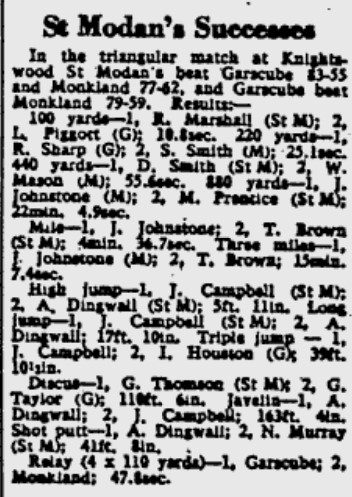 A very good start to the summer with two victories out of two and a significant number of victories. One week later in a similar format match, they beat RCST by 58 to 49, and Glasgow University 58 to 44. On 23rd May, in another three-club league contest they defeated Maryhill Harriers by 83 to 56, and Forth Valley 77 to 60. Despite all this league success which meant turning out many athletes week after week, there was a disappointing number of club members among the medals at the West District Championships at the very end of May. Tom Brown, second in the Junior Mile was the sole medallist. Walter Eadie was performing well for the RCST and won the Universities Championship Three Miles in 15:07.4 from Jim Bogan of Glasgow University on 6th June. Distance seemed no object to Tom Brown who travelled to Kinlochleven HG on 4th July where he won the mile handicap race from Knox of Shettleston.
A very good start to the summer with two victories out of two and a significant number of victories. One week later in a similar format match, they beat RCST by 58 to 49, and Glasgow University 58 to 44. On 23rd May, in another three-club league contest they defeated Maryhill Harriers by 83 to 56, and Forth Valley 77 to 60. Despite all this league success which meant turning out many athletes week after week, there was a disappointing number of club members among the medals at the West District Championships at the very end of May. Tom Brown, second in the Junior Mile was the sole medallist. Walter Eadie was performing well for the RCST and won the Universities Championship Three Miles in 15:07.4 from Jim Bogan of Glasgow University on 6th June. Distance seemed no object to Tom Brown who travelled to Kinlochleven HG on 4th July where he won the mile handicap race from Knox of Shettleston. 